|
Book 3 |
Canal Cruising 2000 to 2005
An eBook by Cyril J Wood
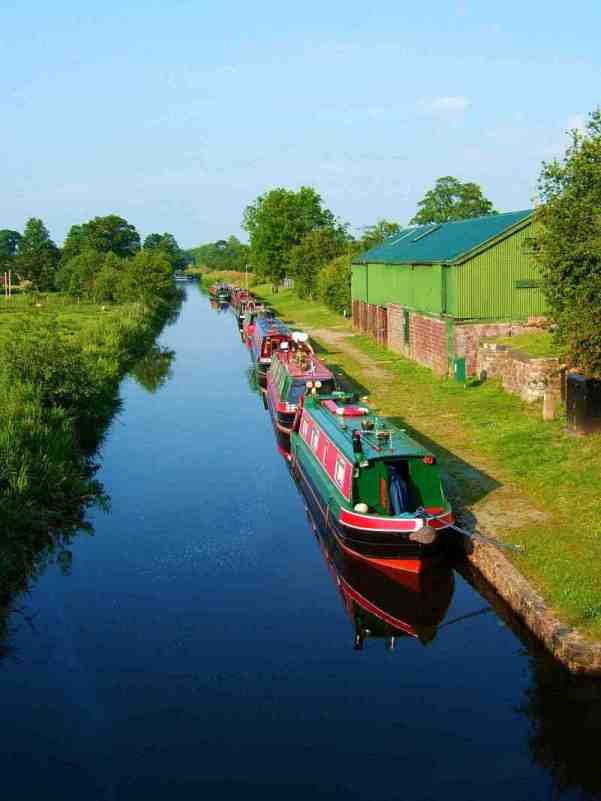
|
The title photograph shows "Total Eclipse" and other boats from Lymm |
|
Cruising Club at Queen's Head on the Montgomery Canal, July 2005. |
 |
|
|
Click on title to follow links
|
|
|
Book 3 |
Canal Cruising 2000 to 2005 is a true story
Chapter 1 - “Cordelia”
Since selling “Misty Waters” in 1990 I had kept in touch with my old canal cruising friends Dave Reed and Alec Levac. Dave still had “Cordelia” but Alec sold “Tamar” in the mid-1990’s and no longer went cruising. A chain of events about to take place were to have an impact on our lives and lead to my returning to canal cruising and subsequently become a boat owner again.

The Runcorn Arm of the Bridgewater Canal
In 1999, I remarried. My new wife, Ange and I went to the Dominican Republic to tie the knot and on our return, we threw a party for all our friends. Dave and Alec were both invited but only Alec and his partner Ann came. Dave had a prior engagement and was not able to attend. The following year, in 2000, Ange and I were invited to Lymm Cruising Club for a party to celebrate one of my old Bridgewater Canal friends, Norrie (the mad Irishman) Kelly getting married again at the age of 72! We were made most welcome by our old friends from Preston Brook’s P.B.B.O.A, Lymm, and Runcorn Cruising Clubs. It was good to see Alec and Norrie as well as my other old friends, and also to discover that I had not been forgotten. Many members of the various cruising clubs had fond memories of when we cruised together and of my audio/visual presentations.
In 1987, as mentioned in “Canalscape 2” Chapter 2... “Bridgewater Days”, I started writing a book entitled “The Bridgewater Book”. This was to be a publication covering the history of the Bridgewater Canal as well as the geography of the route, containing many photographs and an up to date set of maps. It didn’t get published and lay in my bookcase until late 2000 when, after completing a novel and being bitten by the writing bug, I decided to dust it off and bring the manuscript up to date.

A painting of narrowboats in the landscape
I spoke to my old friend Dave Reed, the owner of “Cordelia”, just before Christmas 2000 to confirm some points for the “Bridgewater Days” chapter of "Canalscape Book 2" which I was also working on at the time. During the conversation, he offered to lend me “Cordelia” anytime that I wanted. I was most grateful for this offer and we made plans to take the boat out in the March of the following year (2001). I rang Dave in February to confirm the arrangements for the following month when Ange and I both had a week’s holiday due, only to discover that he had been taken into hospital with a suspected thrombosis of the leg. Not wanting to bother him, we decided to cancel our canal cruise. It was also when the Foot and Mouth epidemic was raging and it would have been most irresponsible to have gone cruising through the Cheshire dairy land at this time. A couple of weeks later, on the 13th March, Dave rang me at home to say that he was now out of hospital and that the suspected thrombosis was actually an ulcer. It had certainly taken the wind out of his sails and he was not as mobile as he was, although he hoped to make a good recovery. Also, he wanted to ask me a favour. He told me that “Cordelia” was not being used as much as she should be and that she had been broken into along with other craft on the same moorings. He didn’t want to sell her, as it would break his heart if he was to see her being neglected by strangers. Dave had also considered bringing her out of the water and putting her in his back garden but this seemed impractical. He would rather see the boat used and asked me if I would look after “Cordelia”, treat her as my own and to go cruising on her whenever and wherever I wished. He would pay for the up-keep of the boat, but in effect, she would be mine to use as I like. The only proviso was that we took him out for a cruise every so often.
I didn’t know what to say. I was moved emotionally and at a loss for words (which is quite out of character for me). Consequently, Ange and I went to see him on the Friday evening of that week to formalise the arrangement and to pick-up the keys to the boat. He also gave me a large file, which contained “Cordelia’s” original ships papers. Amongst the papers were some very interesting documents including :- the original 1980 Hancock and Lane “Norsman 40” sales brochure, the original sales receipt, a “road test” reprinted from “Canal and Riverboat”, various instruction leaflets and an application form for the Canal Boat and Caravan Rally that we attended in April 1986. When I showed the latter to my brother (who arranged the rally) he was “gobsmacked” and I gave it to him to file away with the other documents on activities that he is involved with.
In the meantime, I still had a couple of days holiday owing to me and booked one of them for Friday the 23rd March, when I would go up to Walton (near Daresbury) on the Bridgewater Canal, where “Cordelia” was moored, to see what work was needed, to tidy her up and make her “cruisable”.
“Cordelia” was a Hancock and Lane “Norsman 40” narrowboat with a cruiser stern and powered by a British Leyland 1.5 litre diesel engine. I am told that she was Hancock and Lane’s 1981 Boat Show demonstrator. In addition to a very high build quality and has thicker than normal plating (which my electric drill can confirm) she has a two inch fin keel welded onto her base plate to ensure that, during transportation to and from events that she was exhibited, the shell did not flex, which would prevent doors and cupboards not closing properly.
Over the years she has been modified from the original fit-out. The two twin bunks in the fore cabin have been replaced with two single berths that convert into a full size double bed across the full width of the boat. A “Torgem” solid fuel stove was also fitted into the fore cabin. The original pump-out toilet had been removed (the space where the holding tank was situated beneath a removed bunk which was then occupied by the “Torgem”) and a “Porta Potti” chemical toilet took its place. A green pvc tonneau type cover has been fitted to the front deck as well as a windscreen and “pram” style cover over the rear cockpit. The original brown and beige livery has been replaced by a conventional narrowboat colour scheme of black hull with a red and green superstructure, but other than these modifications, she is pretty much as she was when built.
When I arrived at Walton and inspected “Cordelia”, the condition of the boat was not as bad as she looked. She was dirty on the outside, covered in green algae and dead leaves (due to being moored beneath trees) but the paintwork was generally in good condition and on the inside there was no smell of damp or sign of water ingress even though it had been broken into. The inside was a mess where the thieves had strewn the contents of the bunks and toolboxes over the floor whilst looking for anything valuable.
After making a start on tidying up and checking everything (gas, water and batteries), I put the main engine battery on charge (there is mains electricity on the mooring) but, judging by the rate it absorbed electricity from the charger, I suspected that it would not hold its charge. After a few hours it still wouldn’t turn the engine over. I spent a couple of hours tidying everything up then concentrated on vacuuming the carpets and cleaning the Torgem solid fuel fire. Maxi the dog came with me. It was the first time he had been on a canal boat and he was a bit timid at first but, after getting on and off a few times, soon grasped the idea.
The following day, Ange and I (and Maxi) went up to Walton armed with tools, food, cleaning materials and even (just in case we decided to stay overnight) bedding and our portable TV/Video combo. My brother, Jim and his wife Norma came up as well to give us a hand with the cleaning. The batteries went on charge again, the Torgem was lit and we started to clean the inside of the boat. When the water system was primed, I noticed that it kept its pressure for a few minutes but had to be re-primed if left for longer than ten minutes. I thought that there may be a small air leak in the sphere or one of the pipes and planned to make an inspection when convenient.
The battery still wasn’t showing signs of life so, after Jim and Norma had left we decided to take it to Claymoor Marine at Preston Brook for checking and, if necessary, replacement. The latter was, as suspected, the only option and a new battery was duly obtained. When it was connected up the engine burst into life and started to charge the domestic battery and heat up the water in the hot water cylinder.
We reversed the boat from its mooring under the A56 road bridge into the spring sunlight onto a vacant mooring adjacent to the water tap. We then started to clean the green slime off the superstructure. After a few attempts, we added a small amount of bleach into a bucket of warm water and tried it on a small area. It was extremely effective and so was used on the whole of the cabin side and hull.

"Cordelia" moored at Walton in 2001
When we had completed one side, we returned “Cordelia” to her usual mooring and I fitted one of the new security locks that I had bought. The lock was fitted unobtrusively on the doorframe and should provide, along with the second lock, adequate security protection to the door. The window in the door was another matter though. It was this that the thieves had broken and undone the bolts securing the door to gain access. The bottom edge of the window aperture had also started to rot. I planned to cut out the offending section and so make the aperture larger. A larger and thicker piece of Perspex would be needed but this would not be a problem. In the long term, a new door and frame would be required.
We decided to stay the night on board and so stoked up the Torgem, had our tea and connected the TV. It was extremely cosy lying under our duvet in the double bed that spanned the whole width of the boat’s hull, with none of the chill or condensation that I had experienced in fibreglass boats, even when lined with carpet. No doubt, the superstructure insulation combined with a solid fuel fire was the answer to many a canal boater’s prayers.
The following morning, when putting the bedding away, Ange noticed a damp patch on the carpet. We traced this to the water pump’s drip tray overflowing. As I had previously suspected, there was a leak that appeared to be coming from the water pump body gasket, which leaked when the system was pressurized. The water pressure sphere was also showing signs of corrosion and would need either attention or replacement. I planned to remove the pump assembly at the next opportunity for a more thorough inspection and isolated the system for the time of being. As it was Mothers’ Day, we planned to leave late morning so that we could visit Ange’s mum, so we tidied up, loaded our things into the car and headed home. The following weekend, we only went up on the Saturday. We had planned to use a jet wash to clean “Cordelia” but, as it was raining, we put this task on hold. Our first priority was to remove and make a closer inspection of the fresh water pump. It was a Stuart Turner pump of the impeller variety , similar to a “Jabsco” and once removed, I could see that it was leaking from the underneath of the impeller chamber. We took it to Claymoor Marine to see if they had any spares for it. When the engineer looked at, he concluded that it had been “frozen-up” and that it was beyond economical repair. They did not have one in stock but a replacement made by “Sureflo”, a new pressure sphere and the associated fittings were purchased from Midland Chandlers next door. Whilst looking around Midland Chandlers, Ange saw a “Chinese Hat”… a cowl that fits on top of the solid fuel stove’s chimney which would remove the need to place a cover over the chimney when the boat is unattended. As there are different sizes available we did not purchase one then but would measure the chimney diameter and return at a later date to purchase on that was the correct size. On our return to the boat, the new pump was placed into position but not connected. For this task I would require my plumbing tools which were at home. This job would have to wait until the following weekend. In the meantime, it had stopped raining, so the pressure washer was connected up and we commenced removing the green algae from the roof. “Cordelia” was then turned around and the opposite side was cleaned. When completed, we turned the boat around to her normal orientation, tidied-up and made our list for things to do in the week and to bring up the following weekend. On the following Wednesday evening, we went to Dave’s to return the jet wash and to show him the original water pump that I had removed. We then carried on to the boat to drop off some logs that Ange’s brother-in-law (who is a tree surgeon or, to give him his correct title… Arborer) had given us. We also took up some copper pipe and my plumbing tools ready for the installation of the new pump. Before we went home, the shower cubicle was emptied of an accumulation of bits and pieces and some of the unwanted things removed from the front/port bunk. These items found their way into our loft at home.
Ange had decided to make new curtains for “Cordelia” as the original ones looked a bit dowdy and dull-looking so we brought home one of the original curtains to use as a template. The local fabric shop was visited and suitable material, along with the lining and “rufflette” tape was purchased. That evening, as Ange is not the world's best sewer, she went to see her interior decoration expert friend, Rachael, who gave her some guidelines as to the best way to tackle the curtains. The following evening, I lugged Ange’s ancient “Singer” out of the loft and we started to cut the material and sew them together, taking turns at using the machine.
The following weekend we called in at Midland Chandlers on our way up on the Saturday to price a “Chinese Hat” for the Torgem’s chimney. As it was only six pounds, we bought one and went next door to Claymoor for disinfectant tablets (the foot and mouth outbreak was in full swing and we didn’t want to take any chances). On arrival at the boat, we tried the first pair of curtains that we had made to see how they fitted. Needless to say, they were a great improvement and brightened up the boat’s interior no end (even though we did discover at a later date that they were sewn upside down).
We did not plan to stay the night as we were going out with my brother and his wife that evening, so I concentrated on installing the pipe work for the new water pump, making it neater and more compact. After letting some air out of the pressure sphere, I turned on the water and the pump’s power supply. Everything seemed to work as it should, the only annoyance being that the pump cut-in every ten minutes or so and ran for a few seconds. I put this down to airlocks in the system and would most probably clear itself as the day went on.
We fitted the “Chinese Hat” to the chimney and continued our regime of cleaning and personalising the boat, and removed yet more unnecessary items for storage in the loft at home. The water pump was still running for a few seconds and, just as we were preparing to leave, we heard water running. I traced the noise to the engine compartment and lifted the rear deck boards to investigate. To my horror, the compartment (which is normally bone dry) had about a foot of water in it. The water was coming from the pressure relief valve on top of the hot water cylinder. I pumped out the bilge and turned off the water and electricity supply to the pump. We were running to a schedule, so the valve would have to be seen to on our next visit the following Monday.
We arrived that day mid-afternoon and after lighting the Torgem, concentrated on the pressure relief valve. After adjustment, everything was in order except for the water tank being empty. We cruised down to Preston Brook to fill it up, as the hose on the boat was not long enough to reach the water tap at our mooring. This was our first real cruise on “Cordelia” and I introduced Ange to the mechanics of narrowboat steering, which she quickly mastered.
On our return to the moorings with a full water tank, I turned on the water and electricity to the pump and we crossed our fingers. Everything was in order; no leak from the valve and the pump had stopped running every so often. We then cooked our tea and settled down for the night.
The next morning, Ange fitted more new curtains whilst I painted the Torgem’s chimney and checked the shower’s operation. This worked well except for a few leaks around the valve and head. The shower pump was becoming clogged. On inspection, water left in the tray had caused rust which was blocking the intake. I took the wooden shower board out and couldn’t believe how much the tray had corroded. The tray was scraped and dried out with a view to painting it with red “Hammerite” at the first opportunity.
Whilst I had been seeing to the shower, Ange was concentrating on cleaning the galley and cupboards and sorting out what went where. We then vacuumed and polished the boat from one end to the other before coming home with yet more stuff for the "boat box" in the loft and the “wheelie bin”.
Our next visit was on the Friday of that week which also happened to be Good Friday. When we arrived, the Torgem was lit and I connected up the stereo cassette/radio so that Ange had some music to work to whilst I painted the shower tray. Ange hung the remainder of the new curtains, completed sorting and cleaning out the kitchen cupboards before lining them with paper. After tea we tidied-up and made sure that everything was in order ready for the Easter Weekend when we planned to have our first proper cruise. After this we went home.
The next day, we arrived at teatime. We had brought our friends Joan and John to share the weekend with us after they had finished work. They were most impressed with what we had achieved after seeing photographs of how the boat was when we took it over. We all had our tea and settled down to planning where we should go the following day. After breakfast the next day, we decided to set sail for Anderton. We would not be able to stop and tie-up along the way due to the restrictions imposed by the foot and mouth outbreak, so we planned to stop for lunch at the Stanley Arms opposite the Anderton Lift. The weather was grey and windy with occasional showers. The outward trip was uneventful except for a stop at Claymoor and the passing through Preston Brook, Saltersford and Barnton tunnels. Saltersford was the worst as it was narrower than I remembered, the places where the bore had been repaired being only inches away from “Cordelia’s” cabin tops at times.

Maxi on the front deck
On our arrival at Anderton, The lift was shrouded in scaffolding and tarpaulin as the restoration work was well under way. We had our lunch in the Stanley Arms and soon cast off again, turned around in the basin opposite the lift and headed back towards Preston Brook. On the return trip, all went well until we reached Dutton Stop Lock at the southern end of the Preston Brook Tunnel. Two hire boats were negotiating the stop lock and their intentions were not very clear so I hung back to allow them to pass. In doing this, we drifted onto a mud bank. The next ten minutes were spent trying to remove “Cordelia” from the mud. Not an easy task if you do not have a boat pole and only possess two mop stales to push with.
Ex-working narrowboats moored between Preston Brook Tunnel and Dutton Stop Lock
But we did get free, whizzed through the stop lock and arrived at the tunnel at between five past and ten past seven (the time window is between six forty and seven). I had previously held the record for passing through Preston Brook Tunnel… seven and a half minutes, admittedly in a fibreglass craft half the length of “Cordelia” and, on this occasion, decided to enter the tunnel. We went at a faster speed than I would normally go, but I didn’t touch the sides. This trip through the tunnel demonstrated to me that “Cordelia” was easier to control in the confines of the tunnel when steered at a faster speed than normal due to the “Canal Effect”. This is where equal pressure builds up on either side of the boat’s hull and so keeping it in the centre of a confined water channel. The same effect comes into play when passing through a narrow bridge hole preventing the hull from colliding with the sides. When we reached the opposite end there were no craft waiting to enter anyway.
As the toilet was full, we had a short excursion to Preston Brook Marina and visited the sanitary station before heading towards our moorings at Walton, which we reached as it was just going dark.
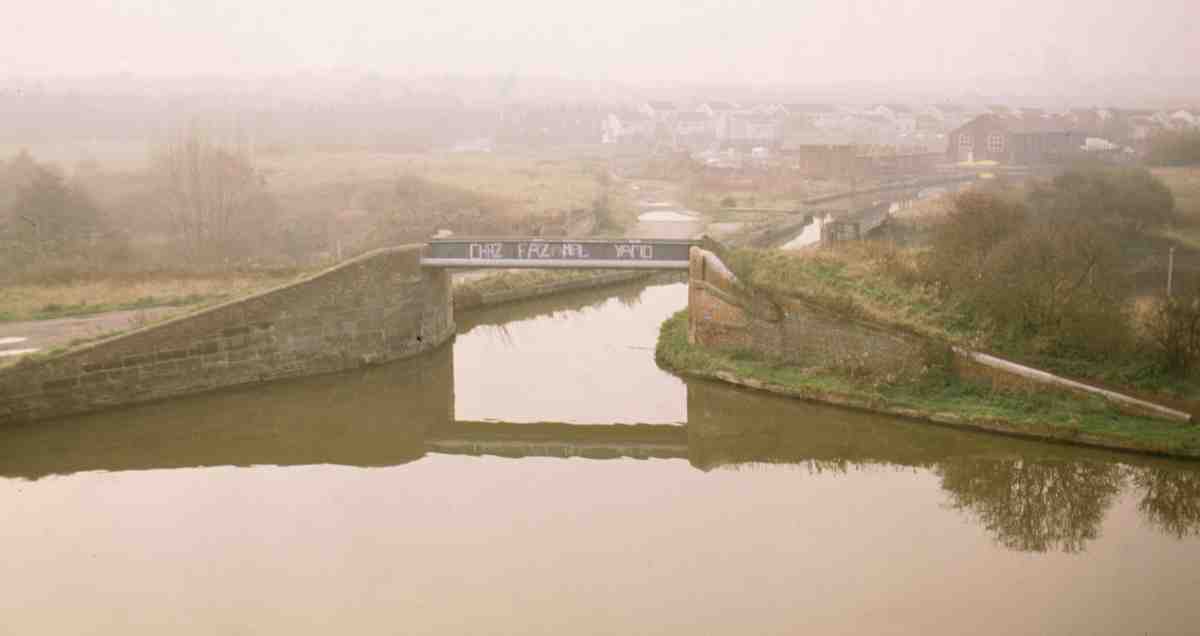
A misty morning at Waters Meeting, Preston Brook in 1986
After breakfast the next day, we set off for Lymm. The sun was shining as we slipped our moorings and passed through Walton Park Cutting, meeting another narrowboat on the bend (as you do) and a couple of hours later we were mooring at Lymm’s town moorings adjacent to the “Icebreaker Tunnel”. After spending some time looking around Lymm and having a drink at the pub by the canal bridge, we returned to the boat, cast off and turned around, heading back to Walton. We had lunch on the run as we passed through Thelwall Cutting and arrived back at Walton about five thirty. It didn’t take long to put the fore and aft deck covers in place, pack up our things and tidy up before leaving for home after a most enjoyable weekend.
The following Friday, Ange wasn’t in work and I booked the last day of my 2000/01 holidays off. We left for Walton after buying our shopping in Liscard. When the car was unloaded and the gas, water electricity was turned on, I started to make the frame for the new front door window. Once the frame was constructed, we had our tea and settled down for a lazy evening in front of the television and the Torgem.
After breakfast, the next day, we removed the front door and made the window aperture larger using a jigsaw. The frame and window were then fitted and self-adhesive, imitation leading was added as a finishing touch.
We had also planned to fit tiles above the cooker but we were invited to accompanying the rest of the club to Lymm on the “Commodore’s Cruise”. Once we reached Lymm, we were given a mooring in the tunnel arm with boats either side, three behind and four abreast in front of us. After tea, we went into the clubhouse and we were made most welcome, re-newing old acquaintances and being greeted by many old friends from my Preston Brook Marina days. We sat at a table with Norrie... the mad Irishman and his wife (referred to as “Crew”) who filled us in on the latest gossip and happenings on the canal.
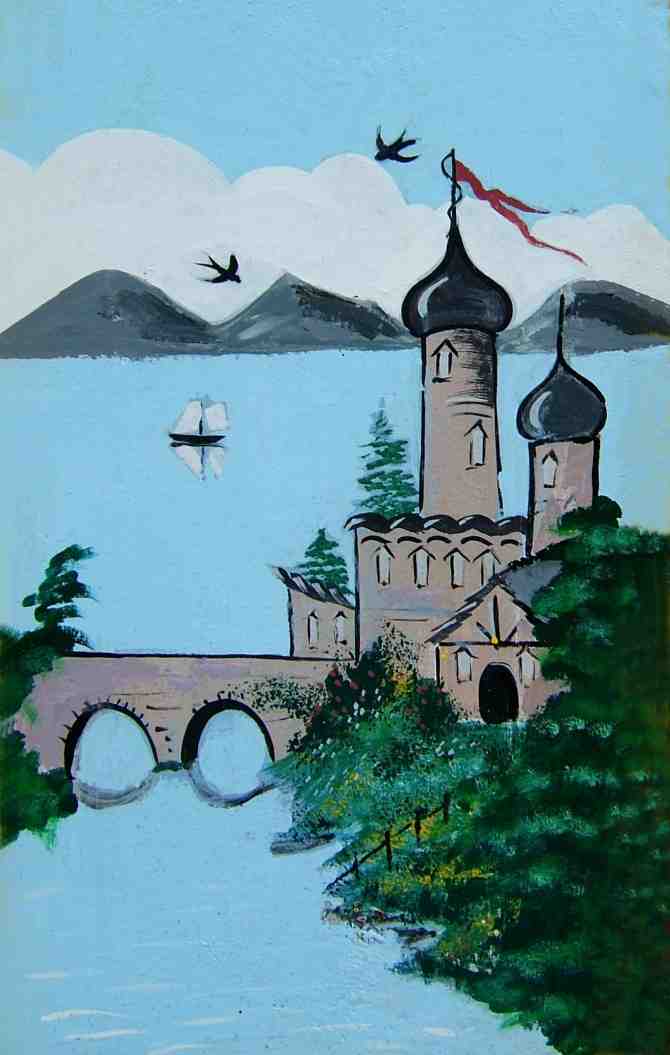
A painting of traditional narrowboat castles. This example is from NB "Swallow"
The rest of the evening at Lymm Cruising Club was most enjoyable. I think that Ange lost count of how many people came up to me saying that it was good to see me cruising on the canal again. This was to be the first of many gatherings that we were invited to and we were impressed by how welcome we were made by our friends at Lymm C C.
The next morning, we had to leave early due to family commitments but we had a problem… we couldn’t get out onto the canal due to the boats moored in front of us. After seeking volunteers to help move the craft obstructing our exit, we finally left and made for our moorings at Walton eating breakfast on the way.
The next few months were spent completing jobs from a list that we had drawn-up. They included... tiling the cooker splash-back, fitting a corner shelf in the front cabin, shifting the ballast to trim the boat correctly, cleaning the engine compartment, overhauling and re-filling the stern tube lubricator, re-wiring and re-plumbing the bilge pump, touching-up paintwork where necessary, renewing the rope locker hatch, etc. There were other long-term projects that plans were made for. These were... fitting a 240 volt electrical circuit (there is mains electricity on the moorings), obtaining a suitable second-hand generator, making a combined mast and television aerial, sorting out the horn and headlamp electrics, re-tubing and replacing (where necessary) the fluorescent cabin lighting, cleaning and re-painting the gas bottle locker, battery and engine compartments, splicing new mooring and fender ropes, replacing part of the cabin floor, building a vanity unit beneath the free-standing wash basin in the toilet and generally tidying up the boat. By the end of the boating season, most of these tasks had been completed leaving the remainder, which included painting various places like the inside of the rope locker, engine, battery and gas compartments until the following spring when the paint would dry better.
Fishermen are the bain of canal boaters. I don’t know how many times I have had to clear the boat’s propeller of fishing line or rescued ducks with line wrapped around their beaks. You cannot win with them either… if, when cruising past a fishing contest, you keep to the centre of the canal as recommended in any cruising guide, you are sometimes directed to steer over to one side or the other and if you cannot do this due to approaching craft or other circumstances beyond one’s control… insults are thrown in your direction. Quite often one fisherman will ask you to pass them on one side and another will ask you to pass them on the other. If these requests are not complied with, insults often ensue.
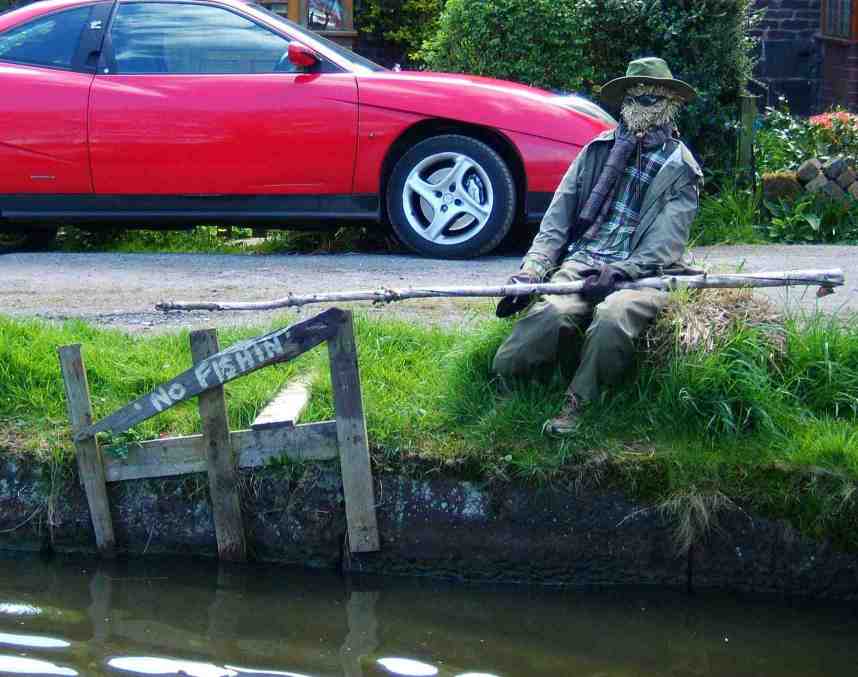
This "scarefish" was recently seen on the banks of the Bridgewater Canal at Moore
The lone fisherman can also be lacking in social skills. There was one fisherman who always used to “hide” behind a large green umbrella next to George Gleave’s Bridge near Daresbury on the Bridgewater Canal every weekend. No matter how slowly we cruised past or how courteous we were, he always shouted the same comment as we passed… “As much sense in a tin of Spam!” We put it down to his not having a happy childhood or some other traumatic experience. On other occasions, we have been cruising along wide stretches of the canal, slowing down accordingly, and had maggots propelled towards us from a catapult. At other times the fishermen will sit behind their rods avoiding eye contact at all costs and ignoring a friendly “Good morning” or “Good afternoon”. The large carbon fibre “Roach Poles” are raised just above one’s head and the female members of the crew cringe at the maggot, squirming on the hook, inches away from their hair. Surely, this is not the way grown people should conduct themselves.
Don’t misunderstand me, I am not anti-fishermen, there are some very friendly people to be found sitting on the banks luring the unwary fish. On one occasion, I was moored at Walton and woke up to a fisherman sitting about five metres away from the back of the boat. After exchanging pleasantries we offered him a cup of tea, which he accepted gratefully. Soon afterwards, he caught a fish and reeled in a Rainbow Trout at least forty centimetres long and placed it in his keep net. Twenty minutes later he caught another of the same species a little longer. When the second one joined its mate in the keep net the fisherman exclaimed… “Well, that’s my breakfast organised”, packed up his equipment and left. Whenever I relate this story to other boaters they usually wonder at the authenticity of Rainbow Trout swimming in the Bridgewater Canal. But I can honestly say that it is true… I saw the fish for myself. On another occasion we were cruising down towards Runcorn when a youth came running towards us waving his arms in the air. “Have you got a camera?” he asked, as his friend had just caught one of the largest fish we had ever seen pulled out of a canal. I obligingly pulled in to the side of the canal, photographed the catch and later sent a copy of the print to the lad. This most certainly wasn’t the one that got away!
Most of us are quite ignorant as to what lurks below the water in the canal. Recently, when our friends Joan and John were on board “Cordelia” for the weekend, John pointed out large Perch coming up for the odd fly floundering on the surface. He threw in some pieces of bread and the largest mouth I have seen outside an aquarium broke the surface of the water and sucked in the bread with a loud “shloooop”.
Whilst on the subject of fish, I must admit that the fishermen’s attitude towards boaters is changing. It is not uncommon for the scowl or nod of acknowledgement to be replaced with a smile or even the occasional “Hello… Nice day”. Recently, Ange was complimented by a fisherman on slowing down when passing a fishing match near Thelwall on the Bridgewater Canal (I have passed them at the same speed without receiving any acknowledgement at all). This wouldn’t have happened a few years ago. Maybe they are realising that we all have to co-exist and that neither of us are going to go away.

A cartoon depicting a canal scene in the style of Thelwell
At the beginning of November, we cruised up Lymm Cruising Club’s Agden moorings for the Bonfire Night Barbeque. We breasted up to Norrie’s boat and spent a most enjoyable evening there. Our winter activities didn’t stop there though. Between the middle of November and early December, I was off work after hurting my back (falling off the stepladder when coming out of the loft with the sewing machine in my arms). I quite often went up to Walton during the day to chill-out and relax in front of the Torgem. Even though there were jobs that I wanted to finish on the boat, I had been warned not to do them… or else!
We had also been invited to Lymm Cruising Club’s New Year Party. On New Year’s Eve, Ange, who is employed by one of the large High Street banks, had to work so, during the day, I went up to Walton on my own as Ange was to meet me later at Lymm, accompanied by our friends Joan and John. It was very cold but any ice had been broken up by other craft travelling along the canal. In the event of thick ice on the canal, we were going to travel to Lymm by car and return to the boat afterwards.
After lighting the Torgem, I started up “Cordelia’s” engine, turned her around and had a pleasant cruise up to Lymm’s Clubhouse moorings. Once I moored the boat outside the clubhouse and awaited Ange, Joan and John. When everyone arrived we got ready for the New Year’s Party. It was an excellent party and afterwards, we returned to a nice warm boat, having stoked up the fire before we left.
The following morning, the canal had frozen up. I had been concerned about the possibility of ice as I did not wish to remove the paint on and below the waterline. Accordingly, we decided to leave “Cordelia” at Lymm Cruising Club’s moorings until the ice had melted. After a late lunch we loaded our things into John’s car and drained the water from the fresh water pump and pipes before John drove us to Walton, collected our car and returned home after a very different New Year’s Day. A week the following Friday, the ice had melted and I went up to Lymm with my brother Jim to return “Cordelia” to Walton. I left our car at Walton then carried on to Lymm in Jim’s car and planned to retrieve it later.
It was the first time Jim had been on the boat whilst it was moving and I sensed that he couldn’t wait to take a turn at the tiller. It had been many years since he had steered a narrowboat, but he hadn’t lost the “knack”. We encountered a bit of thin ice at Thelwall but it soon abated and we had a pleasant, if not cold trip back. We stopped at London Bridge to visit the “chippy” and Thorn Marine to pick up the latest edition of “Waterways World”, but we were soon on our way again and reached Walton about half an hour later. Once the boat was safely installed at its mooring, we returned to Lymm by car to retrieve Jim’s car then went home.
I had booked “Cordelia” into Runcorn Boat Club’s dry dock in February. I didn’t think that it needed any major work but thought that I would freshen up the hull blacking, renew the zinc chromate primer and add a red oxide water line. The dry dock was booked for Sunday 17th February, the day after Lymm Cruising Club’s Valentine’s night fancy dress party. We decided to leave “Cordelia” at Walton and travel to Lymm by car with our friends Joan and John, who we had invited to accompany us. We all dressed up in school uniform outfits (short skirts and pants, white blouses and shirts, etc.) and had a most enjoyable evening.
The following morning, I was up at 6.30 am and prepared “Cordelia” to travel to Runcorn. After breakfast on the move we arrived at the dry-dock at 9.00 am and went straight in. We were accompanied by another narrowboat and when we were all in position the dock was emptied. As “Cordelia” has a keel, she had to be supported by struts until wedges were placed beneath her base plate to prevent her from leaning over. I spent the following week cleaning the hull, painting zinc chromate primer followed by two coats of red oxide beneath the water line and one above topped off with gloss black paint (not bitumen) above the water line except for the red and white stripes around the counter.

Bridgewater Motor Boat Club at Runcorn
Throughout the week weather wasn’t very good as it rained or hailed intermittently for the whole period that we were in the dry-dock and I was continually drying off the hull prior to painting a particular section. At the end of the week I was reasonably satisfied with our efforts although the black gloss on the hull was damaged in places by the rain and hailstones. I planned to give the hull additional coats of black paint when the weather allowed. It was quite different from the last time I was down in the dry-dock back in the summer of 1987. On that occasion “Tamar”, “Cordelia” and “Rakaia” spent an extremely hot week out of the water. The boats went in together and all the members of our gang (including my children) pulled together, helping each other paint the boats during the time spent in the dock.
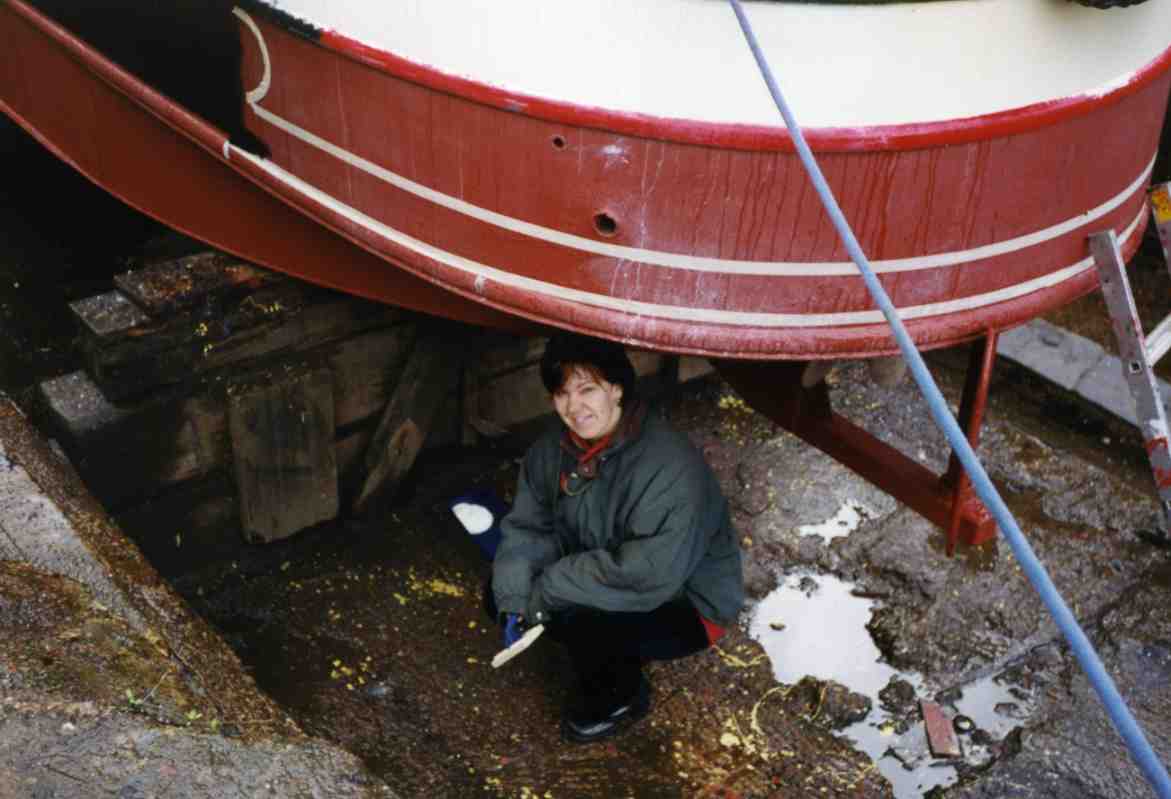
Ange sheltering from the rain whilst painting in the dry dock
On our recent travels we have met more old friends and acquaintances as well as making new ones. Because we have been made so welcome by Lymm Cruising Club, we decided to join their club when finances allowed. I have been overwhelmed by the fact that I have not been forgotten even though I have been absent from the Bridgewater Canal for over ten years.
Prior to taking over “Cordelia”, as previously mentioned, I decided to dust off the book I had started to write in 1987 on the Bridgewater Canal. I spent many hours bringing the text and maps up to date. I also travelled to many locations on the canal to take photographs where new buildings and developments have sprung up. The biggest changes have taken place in the Manchester area. The Castlefield basins have changed almost beyond recognition. The old link with the Manchester Docks complex at Hulme Lock has been replaced with a new lock at Pomona Dock where a new marina complex is proposed. Another location were the canal has been developed is Boothstown. Here, a disused loading basin was home to many old sunken barges and narrowboats. I had visited the basin in 1989 to photograph its draining and the subsequent exposure of the many old boats that were hidden by the water. It has since been converted into a marina surrounded by a modern housing development and public house.

|
The original front cover for "The Bridgewater Book" later to become "The Duke's Cut" |
|
showing the first Trent and Mersey Canal milepost located on top of Preston Brook Tunnel |
Previously, I had used my old electric typewriter to produce the text. This was relegated to the tip when Ange bought me a computer one Christmas. It revolutionised my writing as I was able to scan the text, maps, diagrams and photographs into the computer in a way that I had previously not thought possible. Ange has since bought me a laptop computer which enables me to write whilst on the boat and is also quite a revelation.
Whilst writing the book, I contacted an old acquaintance... Mike Webb from Peel Holdings... the Bridgewater Canal’s owners, who arranged for me to use historical photographs of the canal from their archives in the book, most of which were previously unpublished. Many other people along the canal loaned photographs for inclusion. The book, now retitled “The Duke’s Cut - The Bridgewater Canal” was published by Tempus Publishing in the March of 2002.
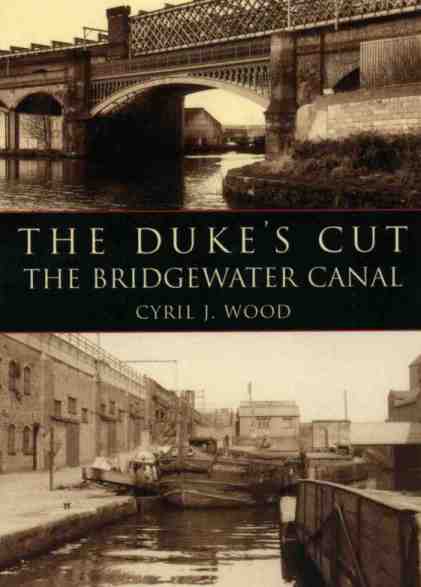
The front cover of "The Duke's Cut - The Bridgewater Canal"
The book was widely promoted in the media including the canal magazines, “Cheshire Life”, newspapers and local radio. I was interviewed by Radio Merseyside and the interview was transmitted whilst I was on my way to work one morning and, as these things happen, I missed it. Most of my colleagues at work, however, didn’t and I was ribbed about it for the next few weeks. To coincide with the publication of the book, I was asked to put on audio/visual presentations for the Bridgewater (Runcorn) and Lymm Cruising Clubs. The dates arranged were Tuesday 4th April for Lymm and 14th April for Runcorn. Tempus were so impressed by the book that they also asked me to write another using the Manchester Ship Canal as the subject. A good excuse for cruises to map, take some up to date photographs and perform research! Please indulge me whilst I share some of my favourite photographs from "The Duke's Cut - The Bridgewater Canal" with you...
Castlefield in 1986
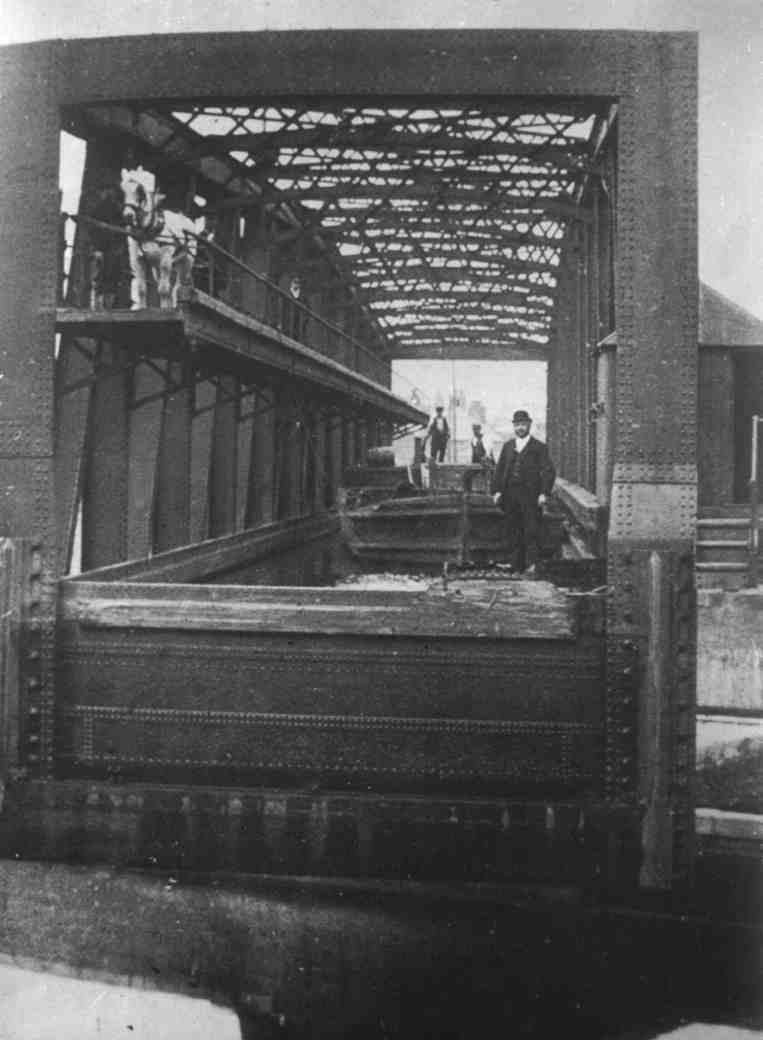
Barton Swing Aqueduct swung with a boat (complete with horse) and crew
(Photograph - Manchester Ship Canal Company)
The Old Number One at Preston Brook... now rebuilt as apartments

Hulme Lock in the 1930s
(Photograph - Manchester Ship Canal Company)
Shortly after the “Duke’s Cut” was published, at Easter 2002, we cruised the whole length of the Bridgewater Canal on a Lymm Cruising Club outing to Wigan. Even though I went fully armed with cameras and film, I didn’t take a single photograph or frame of video, but we had a really good time just the same! Tempus Publishing warned me that I should expect to receive about fifty "anorak" letters. These are letters from readers who have bought the book and wish to make comments (usually derogatory) about it. I must be doing something right as I have only received three to date!
One of these letters was from somebody who lived in the Sale area and was quite constructive, providing additional information that may be of use in the second edition. I was asked to give a talk to a South Manchester local history group which, coincidentally, meet in Sale. On the way to Sale I remember saying to Ange... who accompanied me, that it would be funny if the person from Sale who wrote the letter was in the audience. As well as giving a talk about the book I showed the audio/visual presentation that inspired the book and gave an impromptu photography lesson. Whilst giving the talk I noticed a gentleman sitting on the back row clutching his copy of "The Duke's Cut" and thought to myself... "That's him!" I was right and signed his copy of the book for him as well!
Another letter I received was from a lady in Manchester whose father was the lock keeper at Hulme Lock for many years. In fact, if you look closely at the photograph above of Hulme Lock, there are two girls sitting on the balance beam of one of the lock gates. She was one of them and her sister was the other. Her sister bought her a copy of the book for a present. And in her letter she told me that they have a narrowboat called "Butterfly" which they keep at Preston Brook Marina. A couple of weeks later I saw "Butterfly" at Stockton Heath. I introduced myself to them and had a chat as well as signing their copy of the book which they just happened to have with them. I sent her a selective enlargement of the photograph showing the two figures sitting on the lock gate more clearly as a "thank you" for taking the trouble to write to me and making kind comments about the book.
We were due to help out at the Federation of Bridgewater Cruising Club’s Annual Boat Rally being held at Runcorn over the long Bank Holiday and Jubilee weekend at the beginning of June 2002. A few days before the rally, we went to see David Reed and we were devastated when he announced that he was selling “Cordelia”. He gave us first option to buy the boat but we didn’t think that we would be able to afford the asking price. We weren’t very impressed with the announcement but, it was David’s boat and he could do with it what he wished. We were given three weeks to remove our things from the boat prior to the sale. We were so upset that we removed our belongings from “Cordelia” that evening and posted the keys and boat documents back to David Reed. Consequently, we didn’t attend the Federation Rally as it would have been too painful, being surrounded by people talking about canals and boats. It would have been like rubbing salt into open wounds.
Chapter 2 - “Total Eclipse”
After we parted company from Dave Reed and “Cordelia” we started looking around the local boatyards to see if there was anything within our price range. With the enormous upsurge of interest in canals and narrowboats there wasn’t much on the market, and what was around was out of our price range or needed too much work to make to make them cruisable. I had a feeling of dejavu as it was like stepping back nearly forty years to when my parents decided to buy a boat. Some of the same locations were visited and, as it was forty years ago, some of the craft on offer were either overpriced or unsuitable in other ways. Also, the dreaded Certificate of Compliance was at the back of my mind as we viewed some of the boats and my knowledge of the points covered in the C. of C. precluded pursuing some of them.
To cut a long (and emotionally painful) story short, I heard through the grapevine that David Reed was having difficulties selling "Cordelia" so I "bit the bullet" swallowed my pride, telephoned him and made him an offer that he eventually accepted. We made the necessary arrangements to extend the mortgage on our house in order to raise the difference after using our savings and, as Ange works for Nat West/Royal Bank of Scotland, she was able to accelerate the process.
I decided to travel alone to see David Reed and to give him the cheque in person. He then gave me the keys and documents appertaining to the boat as well as a receipt and all the keys. “Cordelia” became ours on Tuesday 16th July 2002. I then drove to Walton to make sure that the boat was ok. Whilst there, one of the moorers informed me that David Reed had brought somebody up to view the boat the previous evening and took them along the canal for a test drive. This was after he had already accepted our offer and he knew that I would be coming to see him the following day with a cheque!
After buying “Cordelia” the first thing we decided to do was to change change her name. Ange and I had many long discussions concerning alternative names including “Misty Waters III”, but decided not to use this name as we had recently seen "Misty Waters" on a narrowboat whilst sailing up the Trent and Mersey Canal. Eventually, we settled on one of our first suggestions... “Total Eclipse”. A note of explanation is required here as to the relevance of the name that we chose. At the time there was an advertisement on television for McVitie’s “Jaffa Cakes” involving a lady school teacher who was teasing her class of young children with the cakes. Whilst sitting on a stool in front of her class she took a “Jaffa Cake” out of its carton and holding it up for the class to see she said “Full Moon”. She then took a bite out of it and said “Half Moon”. The remainder of the cake was then pushed into her already full mouth and she completed her oration through an obscenely full mouth with the words... “Total Eclipse”. The sequence was then repeated interspaced with shots of the envious children looking on with dismay at not being offered one of the cakes.

Frames from the Jaffa Cake advertisement... Full Moon, Half Moon, Total Eclipse!
Ange’s favourite cakes are “Jaffa Cakes (especially the ones completely covered with chocolate and not just coated on the top) and the first time that we saw this advertisement we fell about in laughter. The advert promoted many action replays in real life... not my me I hasten to add as I am not particularly fond of “Jaffa Cakes”. When we were discussing possible names for our boat, “Total Eclipse” was one of the first suggestions made and it stood the test of time over all the other possibilities. Hence, it became our final choice.
We designed various graphics to accompany the name but settled on “Monotype Corsiva Italic” text, only the “O” in “Total” was replaced by a representation of an eclipse with the Sun’s corona surrounding a black disc. But the sign writing would have to wait as there were more important things that we would have to spend money on before we considered this.
The change of name was officially registered with the Manchester Ship Canal Company on Wednesday 25th July 2002. This was only the start of an identity change for the boat and we drew-up plans to create more storage space in the cavernous engine compartment for tools, etc, and, re-wire the batteries and bilge pump, move the stern gland greaser to the rear deck adjacent to the controls, in addition to modernising, brightening up and refitting part of the interior. The changes would take time as we were not in a financial position to do everything we wanted to do in one foul swoop plus first of all, we had the Certificate of Compliance looming in October..
We had planned to join BMBC at Runcorn as the boat was moored on their moorings at Walton. We would have to be proposed and seconded in order to join the club. This wasn’t a problem as we had plenty of friends in the club. There wasn’t a committee meeting until September when our membership proposal would come before the committee. In the meantime we were told to leave the boat where it was and we would be allocated a mooring, most probably at “Top Locks” (the Runcorn terminus of the Bridgewater Canal) or at “Sprinch” (the branch that once lead to the “Big Pool” adjacent to the clubhouse). A disagreement with one of the members at Walton who questioned my honesty and integrity made us change our minds and we applied to join Lymm Cruising Club instead. This suited us fine as we spent more time cruising with our friends from Lymm CC as well as attending many of their social functions than we did with BMBC.
Not long after buying “Total Eclipse” we went on our first long (for us anyway) cruise. We took advantage of a few days off in the beautiful hot and sunny August weather and headed along the Trent and Mersey Canal to Middlewich and up the Shroppie’s Middlewich Branch as far as Church Minshull before turning around and returning the way we came. I had forgotten just how beautiful the northern end of the Trent and Mersey was as it approached Middlewich and in places can rival the “Shroppie” or the Llangollen Canal for beauty. On our return journey we went on a trip boat up the Anderton Boat Lift. Before we were due to board the trip boat I took photographs of the lift in operation. As I started to take the photographs I was overcome with emotion and could feel my eyes filling up with tears as I didn’t think that I would ever see the historic lift operating again let alone be able to take a trip on it.
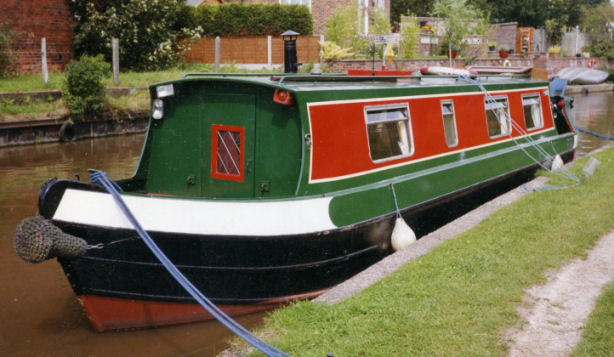
"Total Eclipse" at Anderton on our first cruise since buying her
The lift worked faultlessly if not a little jerkily. The guide told us that the machinery was only just wearing in but next year they would accelerate the speed of the lift as the jerking would have ceased by then. This was confirmed by a friend who recently went on the Weaver with his narrowboat and he told me that the jerking had virtually disappeared and the speed of the lift had, as the guide predicted, increased.
The following weekend we accompanied Lymm CC on a cruise onto the River Irwell. This was a well timed opportunity for me as I was writing the manuscript for “The Big Ditch - Manchester's Ship Canal”... the companion book to “The Duke’s Cut” which concentrates on the Bridgewater Canal’s sister waterway... the Manchester Ship Canal. The trip on the River Irwell was an excellent opportunity to explore, photograph, document and map the changes that have taken place around Manchester Docks and the Irwell corridor through the centre of Manchester. The last time I was on the River Irwell was during the IWA National Rally of 1988 and it was an eye-opener to see just how much the area had changed. Gone were the old factories and warehouses (and ships), replaced by modern business premises, up-market private housing and developments such as the Lowry Centre and Imperial War Museum North. I was so glad that I took the photographs in 1988 a they were to become a valuable historic record of the area (see “Canalscape" Book 2 – Chapter 2).

|
"Total Eclipse" and other boats from Lymm Cruising |
|
Club moored outside the Mark Addy on the River Irwell |
On the Saturday morning we descended Pomona Lock and into the deep waters of the River Irwell and Manchester Docks. We decided to cruise downstream as far as Lowry Footbridge at Salford Quays. We turned around in a large arc and headed upstream. “Total Eclipse” liked the deep water and we took this opportunity to open the throttle to see just how fast she would go. As the throttle was opened fully the bow rose and our speed increased to around six or seven miles per hour. Unfortunately I didn’t notice the fishermen lurking behind a pillar who shouted at us to slow down. The throttle was partially eased down to placate the fishermen and our wash diminished accordingly. Its a good job that none of the fishermen complained but when in the “Mark Addy” later on I related the incident to other club members who though it was hilarious. Everybody expects to be shouted at when speeding on a canal (except for the Manchester Ship Canal) but not whilst on the River Irwell!
We carried on upstream to the head of navigation then turned around opposite Manchester Cathedral before eventually mooring alongside other members’ boats at the “Mark Addy”. After a walk into Manchester we returned to the boat to get ready to meet other members for a meal in the pub... and very nice it was too. The following day we played water taxi for members not wanting to take their boats down to Salford Quays where we moored at Merchant's Quay next to Welland Lock that gives access to the basins that were once Manchester Docks and the Erie Canal... a new canal that connects the basins.
Ange and I aboard "Total Eclipse" outside the "Mark Addy"
(Photograph - Arthur Malcolm)
After taking a look around the shops and galleries we returned to the boat and Ange had a nap whilst I walked around the area taking photograph and making notes as well as video footage. Two rolls of film later I was back were I started and we waited for the other club members to return before we made our way back to the “Mark Addy”. We had to be at Pomona Lock early the next morning to climb back onto the Bridgewater Canal and then cruise back to our moorings.
Two weeks later we went on another cruise to Manchester. This time it was to Castlefield. One memorable happening on this weekend was Lymm’s Mooring Officer... Alan Savage, his son Philip and myself undertaking the “Harry Ramsden’s Challenge” (he’s behind you Phil! – gay waiter joke). This entailed our eating an extremely large plate (more like a tray than a plate) containing two fish, a mountain of chips and accompanied by peas. Even though the plates were piled high Alan asked for more peas and extra bread and butter! If we were successful in eating everything, we would receive a free sweet and a certificate. Needless to say all three of us received both items as well as extremely full stomachs.

A night shot of "Total Eclipse" moored at Castlefield, Manchester
Whilst
passing Trafford Park on our way back from Manchester we were overtaken by a group of youths riding motorcycles on the towpath. They didn't slow down for the anglers fishing along the stretch of canal and on a couple of occasions they were threatened with following their bikes into the canal. Well... I can categorically tell you that there is justice in this life! As we started to turn onto the Main Line at Stretford "Waters Meeting" there was one of the motorcycles turned upside down on the towpath with water running off it. It was obvious what had happened and the youth that was riding it was sitting rather dejectedly beneath one of the bridges trying to dry his clothes. Ange told me not to laugh in case his mates came back, they were told of our thinking that it was funny and followed us. As if I'd laugh at other people's misfortune anyway (those readers who know me do not have to answer that one!).Our application to join Lymm Cruising Club was accepted the week after the Castlefield cruise and we were invested into the Club at the October meeting even though we had previously been granted a mooring at Oughtrington... just up the canal from Lymm. There was no car parking, water or electricity at Oughtrington at that time, but we were told that as places become available at Lymm or Agden (the club’s other moorings) we would be given the opportunity to move up. In the mean time, we attended working parties to clear the overgrowth that had taken root and generally tidy-up the area that was once the car park at Oughtrington with a view to reinstating it.
Not long after joining Lymm CC, “Total Eclipse” was due for her Certificate of Compliance to be renewed. Arrangements were made for the surveyor to inspect the boat and, after doing the necessary checks and inspections failed the boat on a few minor points such as... wrong type of fire extinguisher fitted, fire blanket needed replacement, a larger vent on the rear cabin door, flexible fuel hoses to be replaced plus a gas pipe to be secured and checked for leaks. All in all, not bad for a boat of its age but the timing was bad as we were due to fly to the Dominican Republic for a holiday two weeks after the inspection which didn’t leave much time to have the failure points rectified. The next weekend I bought the necessesary bits and fitted them but the examiner could only re-inspect the boat the following Thursday so I managed to book a day off work and met him at Oughtrington when the boat sailed through its inspection. The following day I posted the duplicate certificate to Mike Webb at the Manchester Ship Canal Company and we could go away on holiday safe in the knowledge that everything was in order on the boat.
As previously mentioned, there was no electricity at our Oughtrington mooring and the lack of mains power was sometimes a problem. We could always cruise a mile down the canal to the Lymm clubhouse moorings but this wasn’t always practical. After weighing-up the various pros and cons for inverters versus generators we decided to look for an inexpensive generator capable of running power tools, charging the boat’s batteries and the mains equipment fitted to the boat. Just before Christmas (these things always appear at the wrong time of the year) we were offered a brand new Generac generator fitted with a Briggs and Stratton four stroke engine rated at 2.7 kva (2,1 kw)… just right for our needs. Even though it was a little on the large size and noisier than the smaller generators on the market, it was offered at a price that could not be refused (we suspected that it had “fallen off the back of a lorry”). The generator was subsequently installed on the front deck. When in use the landline lead was connected to the generator’s power outlet socket and the boat’s power connection but I was not too happy about this arrangement due to voltage drop and planned to install an alternative power connection socket on the front deck but in the end I relocated the generator to the rear deck and utilised the existing electrical socket.
When we were planning the modifications that we were going to make to the boat’s interior one of the problems that we had to think about was lighting. We planned to fit new lights along the centre line of the cabin roof to ensure a more even illumination than the side mounted lights and also to minimise the attraction of airborne insects during the summer when the windows were open. We decided to fit 12 volt fluorescent lights and use a heavy duty battery charger to top-up the batteries automatically when the generator was in use or when we were hooked up to a land-line. This would also help to minimise any drain caused by the boat’s other 12 volt equipment.
B
uying “Total Eclipse” had been an emotional roller coaster that ended in our severing ties with David Reed. But, in the end we had bought a good boat that would give us an enormous amount of enjoyment and take us on many cruises in the years to come.
Chapter 3 - Canalmanac 2003
to 2005
The 2003 boating season started off with a trip to Castlefield in Manchester and a couple of weeks later, the annual Easter pilgrimage to Wigan. The May Bank Holiday saw us (and forty plus boats) at a barbeque between Saltersford and Barnton Tunnels followed by a trip on a restaurant boat along the River Weaver between Saltersford Lock and the A56 swing bridge at Frodsham. We were bowled over by the beauty of the river and saw some idyllic moorings where craft had moored alongside a field full of cattle. This reminded me of the early days of canal cruising in the 1960’s when we used to moor on the Llangollen and Shropshire Union Canals and were woken up by cattle chewing on the boat’s ropes. We vowed that we would cruise this understated and beautiful river on "Total Eclipse" at the first opportunity.
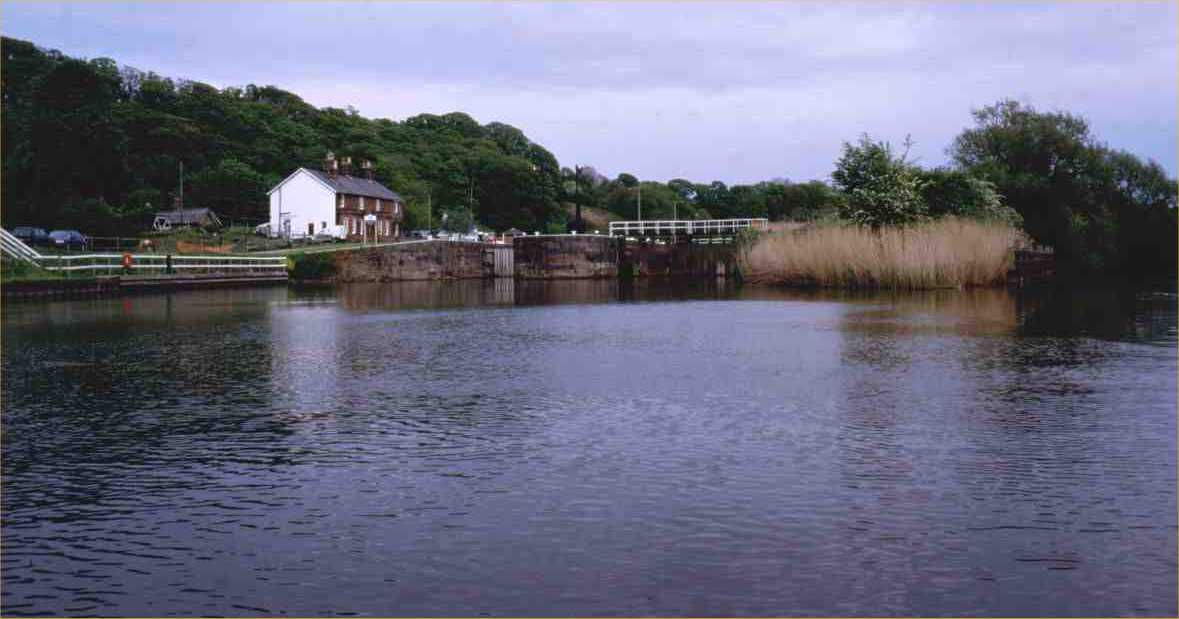
Approaching Saltersford Locks on the beautiful River Weaver
The following weekend we started a two weeks holiday. When I asked Ange where she wanted to go she immediately responded “Llangollen”. So, after work on the Friday afternoon we went straight up to the boat to start our holiday which is documented in the next chapter entitled “Llangollen Pilgrimage”.
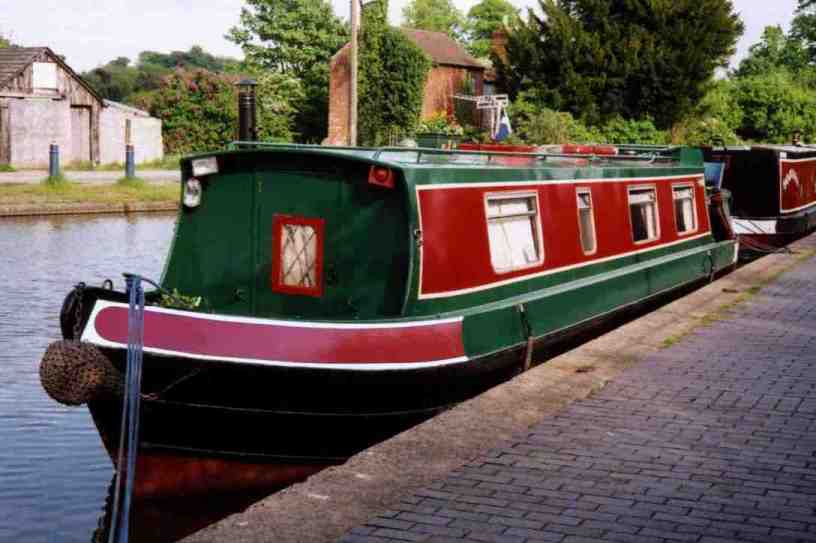
"Total Eclipse" at Ellesmere in May 2003
The weekend after our return from Llangollen was the Federation of Bridgewater Cruising Clubs’ annual rally hosted this year by Worsley Cruising Club at Astley near to the site of the old colliery. One of the high spots of the rally was when we went to the boat jumble auction and Ange put a bid on a second hand Carobo solid fuel stove to replace our ageing Torgem and got it for £27! That was the easy part as we had to transport it back to the boat and fortunately Alan Savage’s son... Phil helped me to do this.
At this time we were fine-tuning our plans to refit the forward section of the boat and as funds allowed we bought various bits (including a 12 volt DVD player) in anticipation of the refit. We had originally planned to fit a small hip bath but decided to stay with the shower. Whilst overhauling the shower mixer we discovered that the pump outlet in the side of the hull was corroded and required replacement. This entailed removing a section of the waterproof lining in the shower cubicle to grind out the pipe that was welded on both sides and when the replacement outlet pipe was fitted we tiled the cubicle, fitted a new pump switch, floor covering, shower curtain as well as painting and generally tidying up the compartment. The rest of the planned refit would have to wait until time and funds allowed.
Lymm Cruising Club had planned a summer cruise along the Weaver, down the Manchester Ship Canal to Ellesmere Port then up the “Shroppie” and back down the Trent and Mersey Canal to return to the Bridgewater Canal with the whole cruise taking two weeks. Unfortunately we were unable to secure both weeks in July but did manage to book the second week so we would cruise along the Bridgewater, T & M and “Shroppie” in the direction of Chester to meet club members on the way back. Our exploits on this cruise are documented in the chapter entitled “Beeston Pilgrimage”.
In July 2003 I (along with Anthony Burton... the well known canal book author) was approached by the BBC to help with the research for a series of television programmes entitled “What The Industrial Revolution Did For Us” and specifically, the episode that deals with Inland Waterways Transport. I was honoured that I had been approached regarding this subject and I must thank Campbell McCutcheon at Tempus Publishing for holding me (and my knowledge of the canal system) in sufficient esteem to give my details to the BBC. The production team were most impressed with the advice that I gave them regarding locations and information on the Bridgewater Canal as well as other various aspects of the canal system.
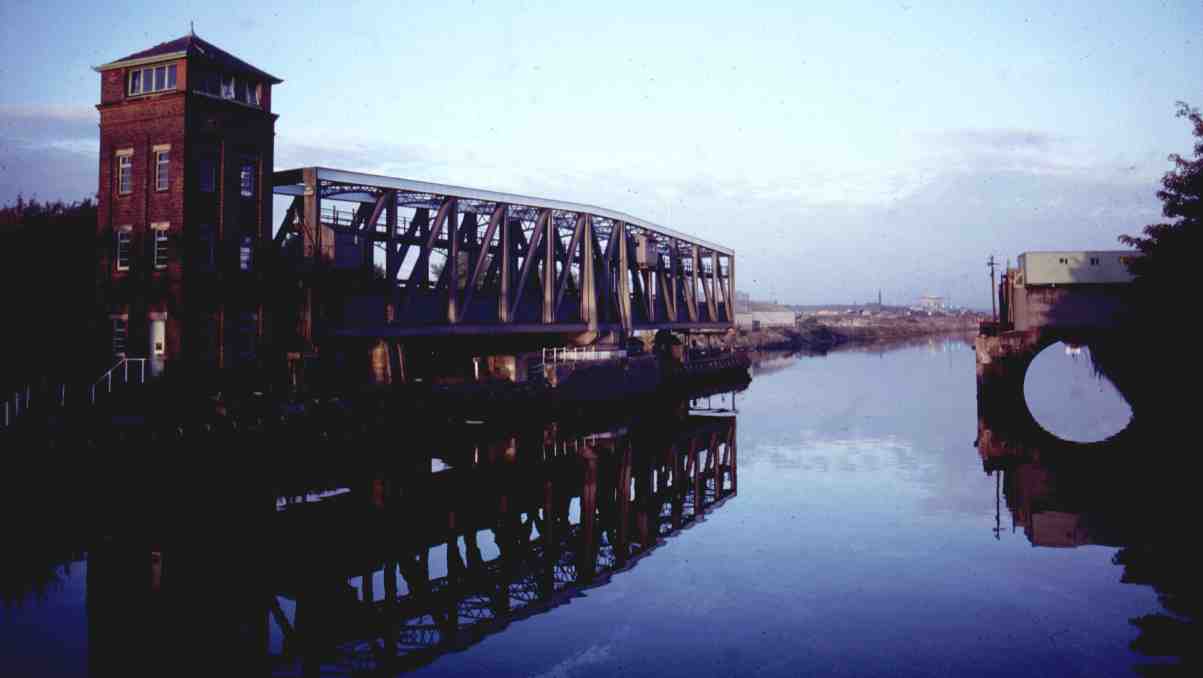
Barton Swing Aqueduct in 1986...

... and a couple of years later with a different colour scheme
One of the canal features that they were interested in was aqueducts and one of the locations I pointed them in the direction of was Hawthorn Lane Aqueduct at Stretford on the Bridgewater Canal. This particular aqueduct was constructed on similar lines to James Brindley’s original Barton Aqueduct only on a smaller scale. A few days later I received an telephone call from the excited researchers who were at that particular location with the film crew. They were most impressed with the location and thanked me for drawing their attention to it.
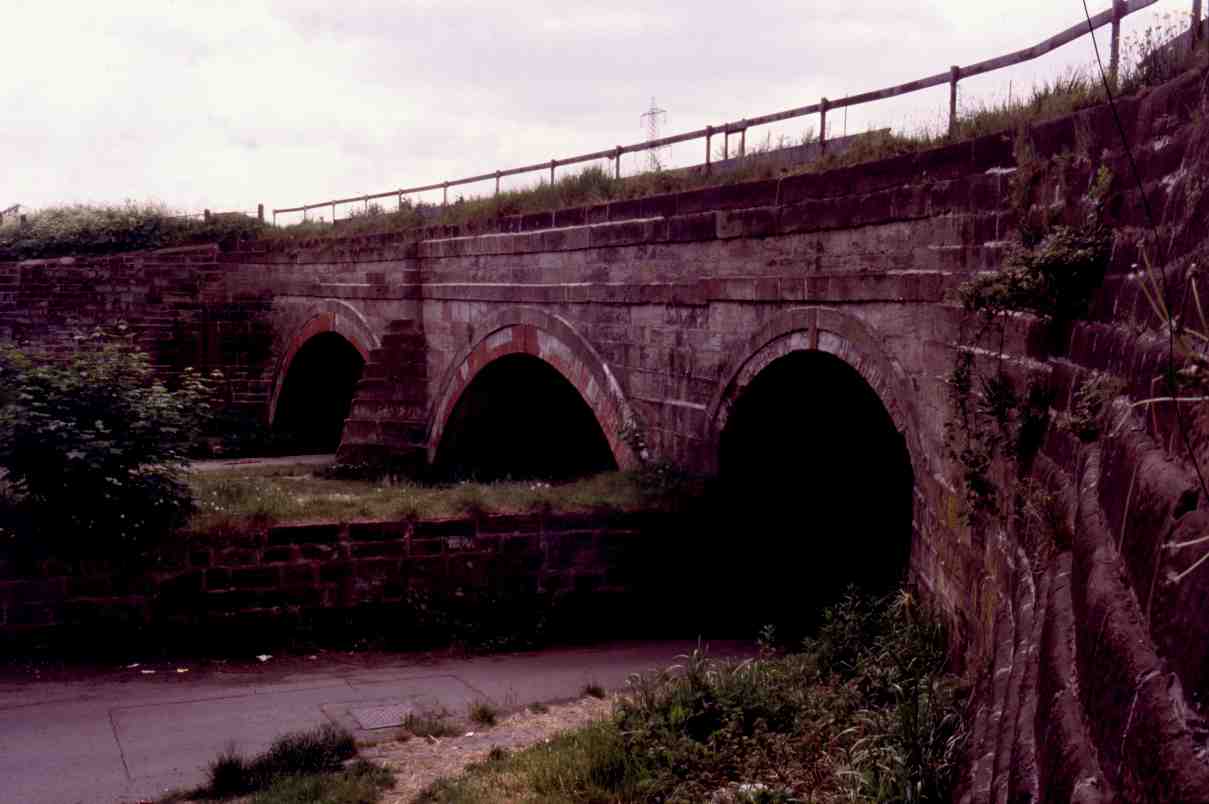
|
Hawthorn Lane Aqueduct at Watchouse, Stretford |
|
is a miniature of Brindley's original Barton Aqueduct |
They were also after details of canal fly-overs. They had been to Barton Swing Aqueduct but wanted something smaller to contrast with it. I told them about Hazlehurst Aqueduct on the Caldon Canal. This substantial aqueduct carries the Leek Branch of the Caldon Canal over the main line of the canal. They visited this location but I do not think that they used any footage of it in the transmitted programme. Even though I had not cruised or visited the Caldon I knew of the aqueduct's existence and of the fact that it is one of the few canal fly-overs in the country. The more that I read about the Caldon the more I would like to visit it. In fact it is on my "wish list" of canals that I would like to cruise.
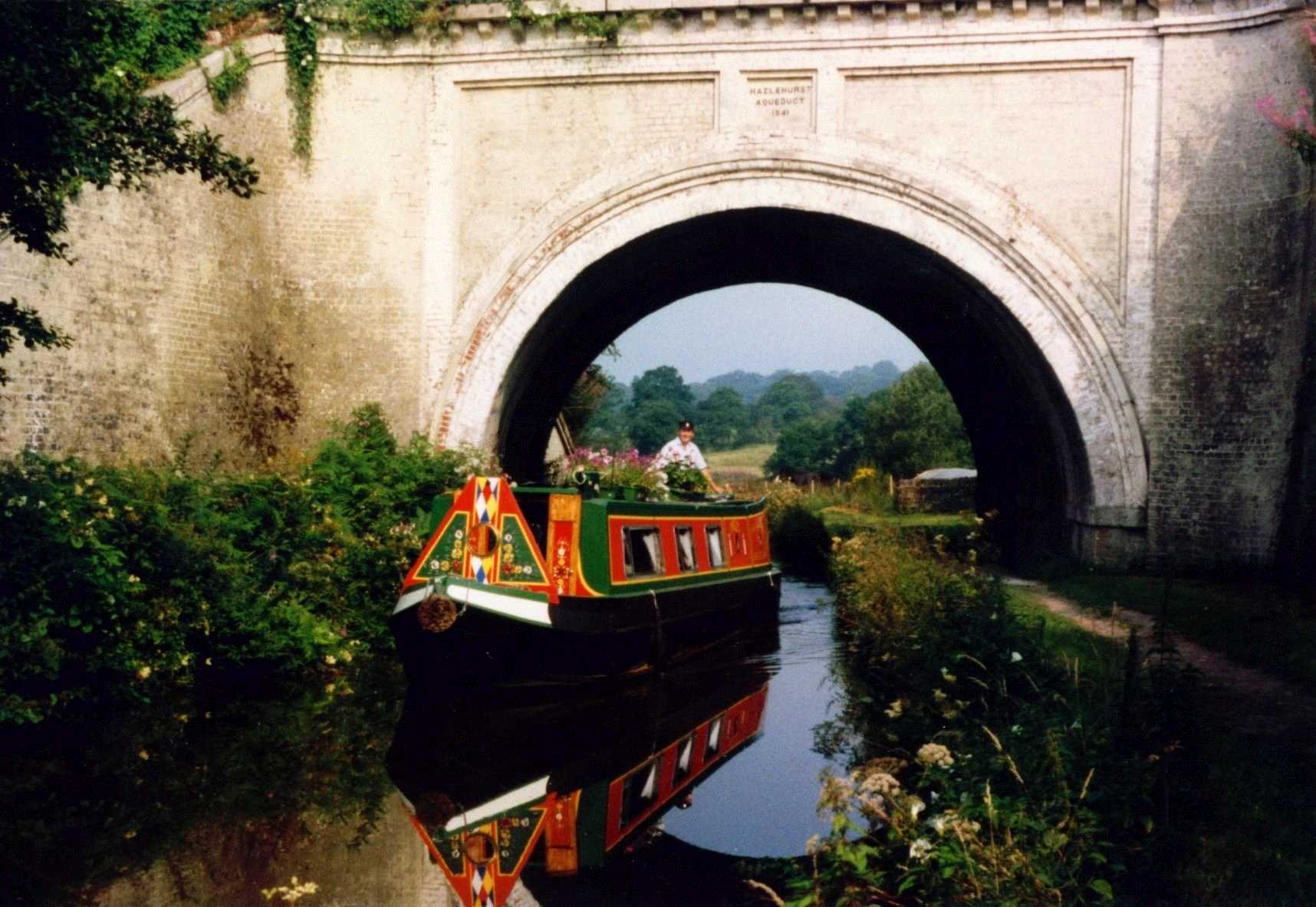
| Hazlehurst Aqueduct carries the Leek Branch of |
| the Caldon Canal over the main line of the Caldon |
On the 29th
October 2003 I had another brush with television and the media. Thorn Marine, the boat chandlers (and much, much more) at Stockton Heath were under threat of closure. Peel Holdings... the owners of the Bridgewater Canal and much of the property lining its banks wanted to demolish the historic Bank Rider's Cottage that Thorn Marine is based in and sell the land to a developer who would build five town houses on the site. It came to light that the buildings, which dated back to 1771 (four years after the opening of the canal), were possibly the oldest surviving purpose built canal buildings in the country but this didn’t deter the planners.We were involved in signing petitions and writing letters of objection to the planning application to Warrington Borough Council. There was a protest rally organised where the canal would be blockaded by narrowboats and cruisers whose owners objected to the application. As the rally was mid-week I managed to wangle a day off work in order to attend. My brother... Jim, also attended as he uses the day hire facilities offered by Thorn Marine.
The day of the rally dawned and I made my way from Lymm to Stockton Heath alone as Ange couldn’t get the time off from work. I met Jim at London Bridge and he jumped aboard just as the canal was being blocked by nearly one hundred boats. The whole rally was covered by BBC "Northwest Tonight" News and ITV’s “Granada Reports” local news programmes as well as local radio and newspaper reporters. “Total Eclipse” took pride of place on the tv footage and featured in quite a lot of the shots shown on tv. There was also a good close-up of Jim drinking a cup of coffee as well as myself eating an extremely large chocolate muffin (from Costco... yummy!). For many weeks afterwards friends and colleagues ribbed me (in the nicest possible way) about being on tv and my celebrity status but, I took it all in my stride being quietly pleased about the affair. A few weeks later we visited Thorn Marine to deliver Christmas cards and we were asked to present to Lymm Cruising Club a framed photograph of the protest rally taken from the bridge. “Total Eclipse” features prominently as does Jim and myself. I was given permission to scan the photograph for inclusion in the second edition of “The Duke’s Cut” and this text as well. The original framed print now hangs on the walls of Lymm CC’s clubhouse.

|
The protest rally at Thorn Marine on the 29th October 2003... |
|
"Total Eclipse" is third from the left on the second row from the camera |
(Photograph - Thorn Marine)
Not everything was going well with “The Big Ditch” however. Whilst the text and maps were completed and I had a large number of my own photographs to include in the book, I still needed archive photographs to accompany them. Mike Webb, who kindly supplied the archive photographs for “The Duke’s Cut”, suggested that I contact the Greater Manchester Records Office who held the Ship Canal’s photograph archive. I travelled up to Manchester and spent a few pleasurable hours with Gabriel Drew... the person who looks after the archive. The downside of the visit was that they required a reproduction fee of £5 per image plus a copyright fee of £120. As I had chosen seventy plus images this would make the project too expensive for me to pursue. Subsequent phone calls proved fruitless and I had visions of having to cancel the whole project.
On the off-chance, I telephoned the Senior County Archivist at Greater Manchester Records Office and asked if I could circumnavigate the reproduction fee by bringing my laptop and scanner to the archive and copy the images myself... so removing the need for the expensive reproduction fee and just pay the copyright fee. I was told that if I had written permission from the Manchester Ship Canal Company they would allow this. I contacted Mike Webb again to see if he could ask the relevant people in Peel Holdings... the owners of the Manchester Ship Canal, for their written permission. This came a couple of days later and I made plans to visit the Records Office in November when I had a week’s holiday from work due. I had planned to use this week for decorating at home but one day out of my schedule wouldn’t go amiss. When the arranged day arrived Ange accompanied me to the Records Office and we set up the laptop and scanner in a little office and scanned the wonderful images directly from the archive books. With Ange’s help it only took a few hours to complete the task and I spent the next couple of weeks (once the decorating was completed) editing the photographs and maps, printing them out and correlating them into the manuscript.
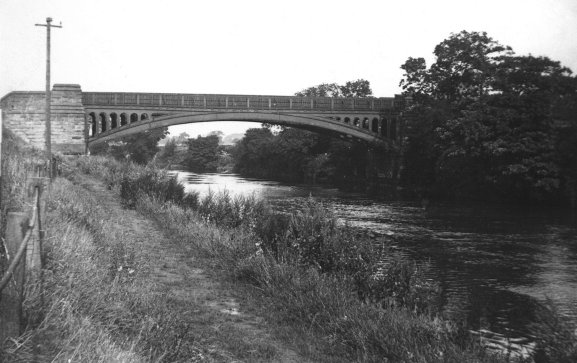
The original Warburton Toll Bridge over the River Mersey
(Photograph - Greater Manchester Records Archive)
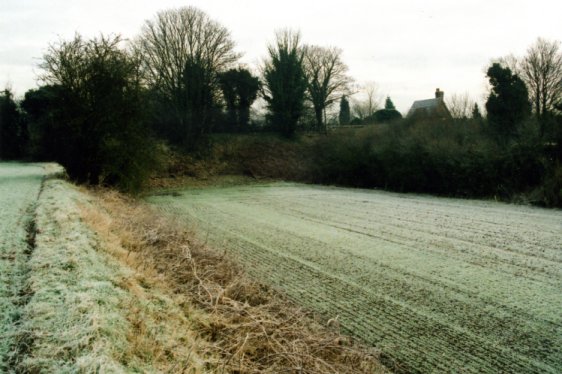
The same location as the photograph above but with the River Mersey infilled
I had previously seen a book in my local branch of W. H. Smith documenting the bridges of the River Mersey. Whilst looking through this book I saw an old photograph of the original toll bridge across the River Mersey at Warburton near Lymm as against the present day bridge across the Ship Canal. I hoped that this photograph was in the Records Office archive and that I would be able to scan it. My hope was rewarded and the photograph was duly scanned. Alan Savage... Lymm CC's Cruising Officer once told me that the toll that one pays today is not to cross the present day bridge across the Manchester Ship Canal but is actually to cross the original bridge. The original bridge is now converted into an embankment due to the natural line of the River Mersey being diverted into the ship canal when it was constructed. The parapets and cast iron railings of the bridge can still be seen but the remainder is buried beneath the tons of earth that form the embankment. This stimulated me to pay the location a visit with my camera in the hopes that I could take a photograph of the bridge as it is today. I spent a very pleasant couple of hours walking around the location, tracing the original route of the river which is now a ploughed field and taking photographs, a couple of which are reproduced here.
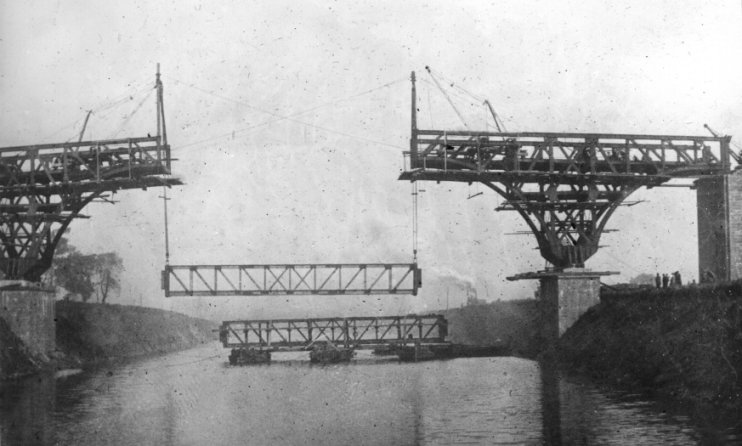
Construction of the new Warburton Bridge over the Manchester Ship Canal
(Photograph - Greater Manchester Records Archive)
.jpg)
Warburton Bridge today

The confluence of the River Mersey and the Manchester Ship Canal at Warburton
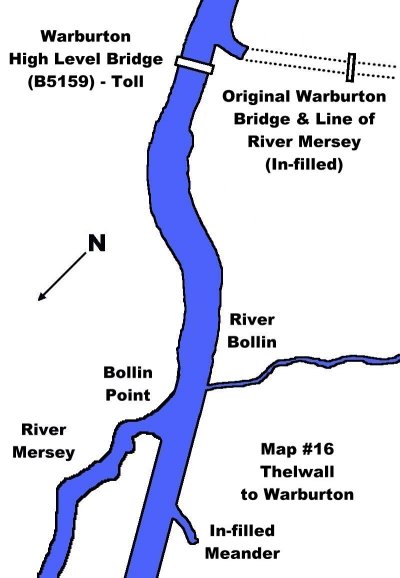
Map of the Manchester Ship Canal - Warburton area from "The Big Ditch"
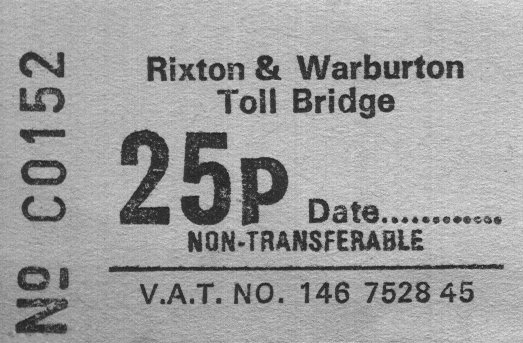
A contemporary toll ticket for Warburton Toll Bridge
Just before "The Big Ditch" project was deemed completed, I received a telephone call from the harbourmaster at Eastham Locks. I was asked to go and see him with regard to some last minute queries I had emailed Mike Webb about. I spent a happy couple of hours talking about the project and canals in general and came away with quite a lot of information that I just had to include in the text and maps. I felt a sense of achievement after the manuscript had been posted by Special Delivery to the publishers, as I could then sit back in the knowledge that the most difficult part of compiling the book was completed.
When I received the publisher’s draft a couple of weeks later I was horrified to discover that the layout of the book had been changed, photographs deleted and incorrect captions for some of the photographs used. I proof-read the draft and returned it to Tempus with a less than polite letter informing them how disappointed I was. The following week I received an amended draft to check over (along with a letter of apology) and was relieved that the errors in the previous draft had been rectified leaving only a few discrepancies to be tidied up.

Front cover of "The Big Ditch - Manchester's Ship Canal"
As the publication date drew near, preparations were in hand for the promotion of the book. A totally unscheduled event took place at work when the BBC Learning Bus visited Wirral Metropolitan College's Carlett Park Campus. As well as students visiting the bus, members of staff were encouraged to visit it to see what they had on offer. The hostess on the bus was Estelle Condliff, one of the BBC Radio Merseyside's Broadcast Journalists. She engaged me in conversation and asked me about my interests. Needless to say... Canals and Inland Waterways came up in conversation as did my writings. I was asked if I would mind being interviewed for Radio Merseyside and I agreed. The ensuing interview lasted for about fifteen minutes and was broadcast at 6.15 pm on Thursday 10th March 2005 on "Evening Merseyside". Even though I was in work at the time I heard the interview go out live. Everybody who heard it commented on how professional I sounded and how my enthusiasm for the canals and inland waterways came over. The interview was replayed on Radio Merseyside's "Pick of the Week" and there was a lot of interest in the subjects covered. I was sent a cd of the broadcast which was also broadcast on Radio Met... the College's own radio station. Similar comments to those after the Radio Merseyside broadcasts followed. Please indulge me again whilst I share some of my favourite photographs from "The Big Ditch" with you...
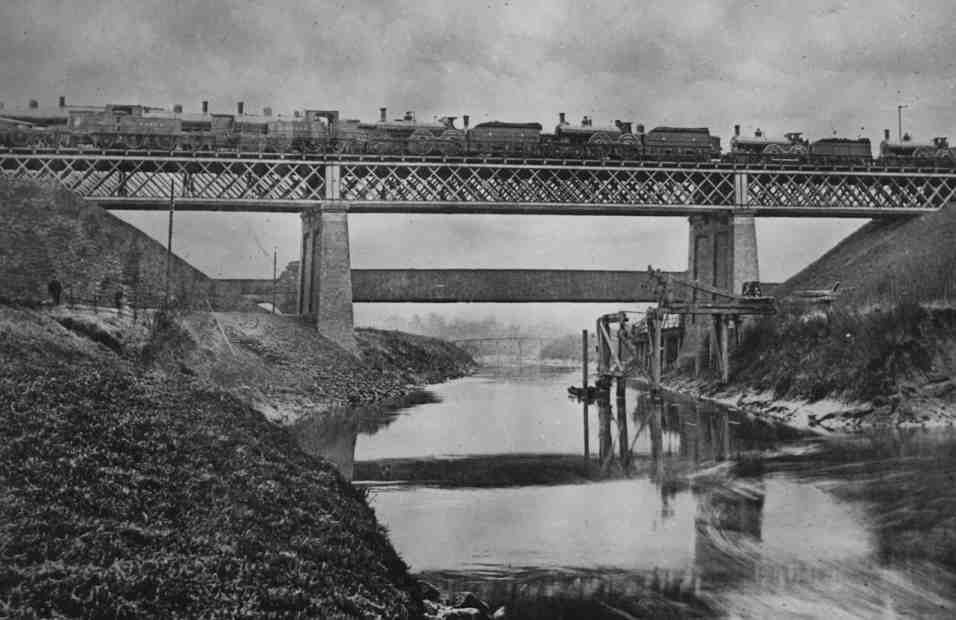
The approach to Cadishead Railway Viaduct being tested with railway locomotives
(Photograph - Greater Manchester Records Archive)

Brindley's Barton Aqueduct being demolished with its replacement... Leader Williams' Swing Aqueduct in the background
(Photograph - Greater Manchester Records Archive)
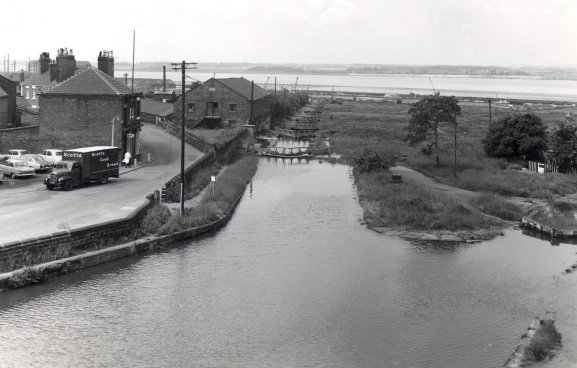
The New Line of Locks at Runcorn with the in-filled Old Line of Locks on the right of the photograph
(Photograph - Greater Manchester Records Archive)
Not all the photographs contained within "The Big Ditch" are archive images as can be seen by the computer generated images of the proposed Mersey Second Crossing (or Mersey Gateway as it is now known). Most of the contemporary photographs were taken by myself and some are included below...
|
|
|
Two computer enhanced/derived views of the proposed Mersey Second Crossing
(CGI - Halton Borough Council)
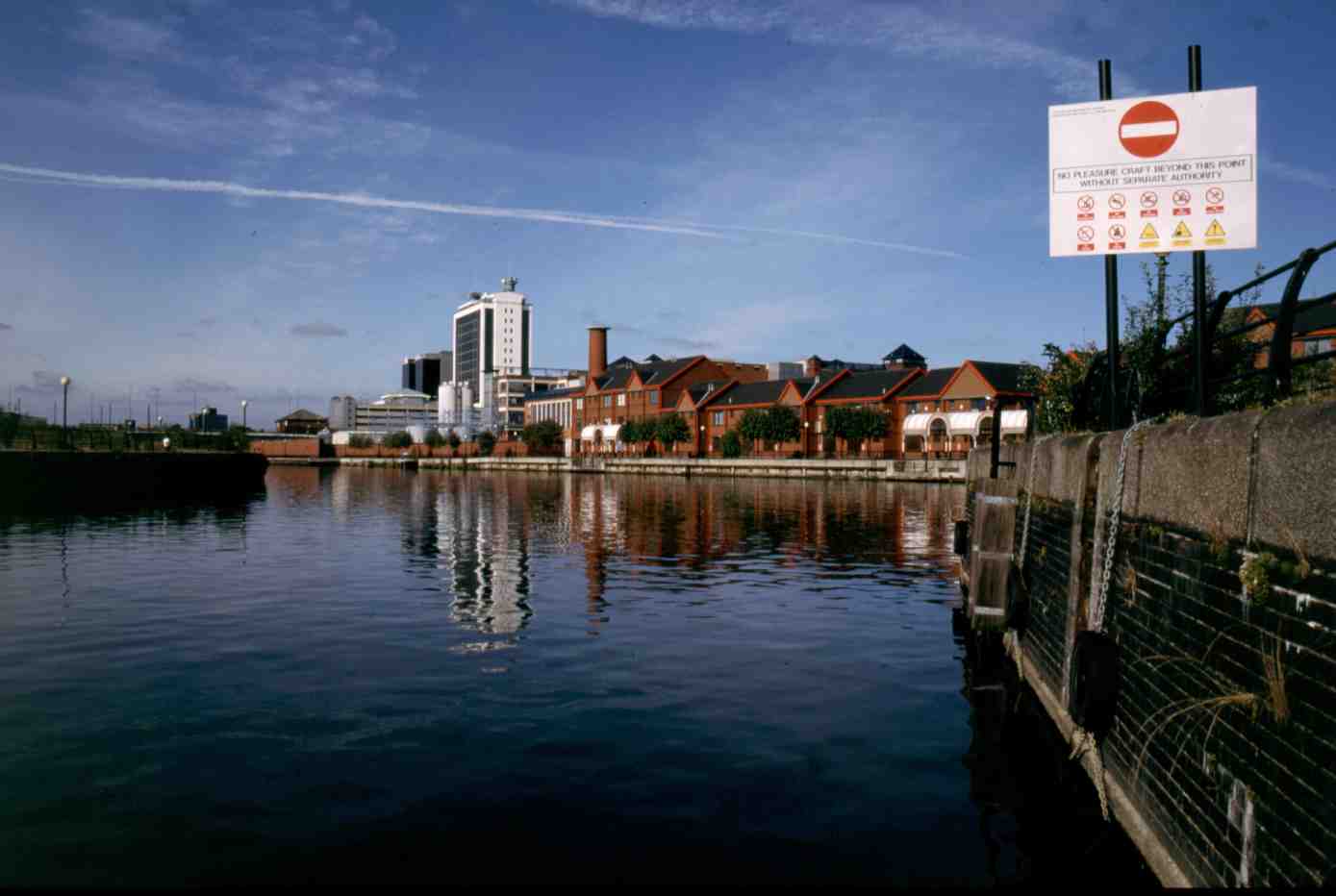
Pomona Dock Entrance to the River Irwell, Manchester
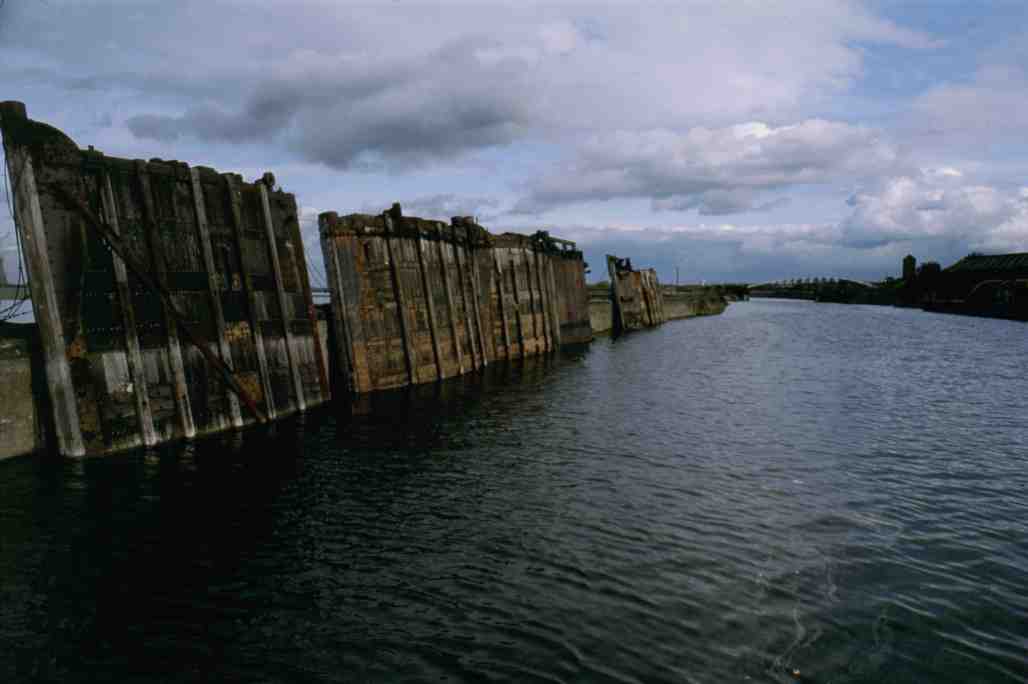
Lock gates stored at Old Quay, Runcorn
Easter 2004 saw Lymm Cruising Club’s Annual Pilgrimage to Wigan. With the second edition of "The Duke’s Cut" at the planning stage I took this as an opportunity to up-date the canal maps and photograph any new landmarks and features that had manifested themselves along the canal. As far as the maps were concerned, I couldn’t believe how much had altered since I redrew the maps three years previously. New bridges and features such as new stop gates and marina developments needed documenting, old landmarks (especially around the Trafford Park area) that had disappeared were noted and their replacements (if any) recorded ready for inclusion in the second edition.
We stopped at various locations along the canal for meals. At Boothstown on the Bridgewater Canal we moored at the pub previously called the Moorings but now under new management and renamed Miller’s. The landlord... Neil was most accommodating. He wanted to involve boaters more and offered hoses for topping up the water tanks, a boater’s breakfast in the morning, barbeque from midday through the afternoon and excellent cuisine during the evening. Once at Wigan we went ten pin bowling and there were various competitions throughout the weekend. Ange didn’t win the Easter Bonnet competition but we did win a prize in a quiz.
|
I always thought that boats were supposed to go beneath bridges! |
|
Seen at the Leeds and Liverpool Canal Maintenance Yard near Leigh |
Whilst we were at Wigan rumours had filtered back to us that there were problems with Plank Lane Lift Bridge on the Leeds and Liverpool just outside Leigh. This is a large hydraulically operated lift bridge that carries a main road across the canal and the problem lay with the bridge’s hydraulics and that it was closed. When we reached the bridge on the return journey, the bridge had been repaired and visions of having to "play hooky" from work (which I would have done without much persuasion) disappeared.
Disregarding the possible enforced stay at Plank Lane, the cruise was a great success. On our return journey we booked virtually the whole of the club members participating on the cruise into "Miller’s" at Boothstown who took catering for over sixty members in the evening in their stride. I took photographs of the boats moored outside the pub and wrote a review for the waterways press. The rest of the cruise was a great success. The boat performed faultlessly, and the weather was reasonably kind even if there was some drizzle.
Lymm CC regularly descends upon the "Moorings" pub at Boothstown
On our return from Wigan I started to concentrate on the refitting of the front cabin of "Total Eclipse". One of the bunk/seats was removed and the plinth for the "Carobo" solid fuel fire was fitted in readiness for the installation of the fire. On the opposite side from where the fire was to be located I constructed a cupboard over the extension to the bunk/seat that originally was occupied by a second wash hand basin. Whilst building the cupboard I was horrified to discover water seeping through the basin outlet in the side of the hull. It was only rainwater but the outlet had been plugged by a piece of wooden dowel which was showing signs of rotting as it had not been treated with sealant of any kind. The situation was remedied with glass fibre filler until a patch could be welded on, solving the problem permanently.
The refitting was put on hold for the Federation of Bridgewater Cruising Club’s Annual Rally which was being hosted by Lymm CC due to the original hosting club (Preston Brook Boat Owners Association) having organisational problems. We were also returning to the Dominican Republic in June as Ange’s brother Paul was following our example and getting married there. The only difference being that as we went on our own... he was taking the whole family with him! The task of organising the tickets, financial arrangements, etc fell on Ange’s shoulders. No doubt… because she worked for a bank and was good at organisation.
It was over two years since "Total Eclipse had been out of the water and, as we both had a week left of our annual holidays we arranged to bring the boat out of the water at Lymm CC’s slipway in July ’04 on the trolley for narrowboats. I showed photographs of the boat’s keel to John Moult who is the Harbourmaster at Lymm CC and whose job it would be to bring the boat out of the water. Wooden blocks were placed on the trolley to support the weight of the boat without interfering with the keel. Once out of the water the moss was jet-washed off the hull whilst it was still wet as it comes off easier. The wetness wasn’t confined to the boat’s hull as it was pouring with rain. I was soaked to the skin (literally) and once the cleaning was completed Ange made me have a shower and warm-up besides the fire that she had lit.
Later that afternoon the rain stopped and the hull had dried off. This allowed me to remove any loose paint, rub down the paintwork, inspect the condition of the hull and apply the first coat of red oxide paint. The following morning (Sunday) I was up early and was painting the second coat by six thirty am. After breakfast I applied a third coat and when this was dry we masked the water line for the first coat of gloss black. Ange was shown how to paint the semi-circular shapes on the bow and the counter by Brian Warburton from NB "Ondine". Brian is a senior member of the club and an old boat painter to boot, who can paint complicated shapes without resorting to a pair of compasses and a template. The end result looked very professional and received admiring comments from everyone who saw Ange’s handiwork. Ange also asked him about scumbling the interior woodwork when we have completed our refitting and he showed her some examples on his own boat which impressed us both. In the meantime I concentrated on the gloss black and whilst I waited for it to dry painted the lifebelt white and red, the gangplank red and borrowed one of my Father’s ideas by painting the boat pole green and red with a white band separating the two colours. One of the red portions was 1’ 6" for the forward draft and a 2’ 6" portion at the other end for the stern draft (my Father had originally used insulation tape on “Phial’s” boat pole to indicate the eighteen inch draft of the outboard motor).
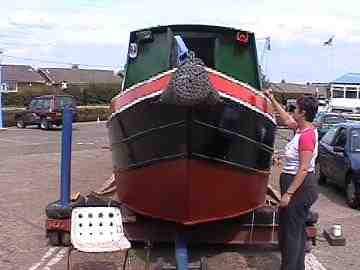
A "grabbed" video frame of Ange painting "Total Eclipse" in July 2004
Once everything was completed, the bits missed touched-up and the remaining bits of masking tape removed, she was ready to go back into the water. That evening Jim and Norma (my brother and his wife) visited and they both commented on how good the boat looked. Jim hadn’t seen it out of the water before and was amazed at the condition of the steelwork beneath the water line. What is even more surprising is the fact that the boat has never had sacrificial anodes fitted although I think that the next time the boat comes out we will fit them just to be on the safe side. The following day... Wednesday, John Moult reversed the trolley back down the slipway and I made sure that none of the new paintwork was scratched in the process.
Once back in the water we arranged to leave the boat in the slipway arm for a day or so whilst we went home to wash our clothes and do some essential shopping. On our return we left Lymm and took a leisurely cruise southwards. We moored for the night at Moore and the following morning, continued to the Trent and Mersey Canal, passing through Preston Brook Tunnel without any drama and made sure that we didn’t scratch the paint in Dutton Stop Lock or when going through Saltersford Tunnel. We moored in the wide between Saltersford and Barnton Tunnels and relaxed in the afternoon sunshine. The following day was the opposite weather-wise. We cast off at eight ‘o clock in the rain so that we didn’t meet anything coming in the opposite direction through Saltersford Tunnel. We didn’t but another boat was approaching from the north as we emerged. The rain was on and off for most of the day and the only real respite was when we were passing through Preston Brook Tunnel at ten ‘o clock.
When we reached Lymm I dropped Ange off at the boat club to collect the car and she drove up to Agden whilst I cruised up to our temporary mooring there. So ended an enjoyable and fulfilling if not tiring week. The boat was looking wonderful and we had made some more plans for the refitting of the front cabin as well.
The mention of the tunnels has prompted me to relate a couple of incidents that have happened to us recently. We have had a few memorable passages through the three tunnels on the northern end of the Trent and Mersey. Once, when passing through Saltersford, we were nearing the southern portal when I heard some unusual noises coming from in front of the boat. It turned out to be a family of swans that had swum into the tunnel. The cob and one of the cygnets were on one side of the boat whilst the hen and the other cygnet were on the opposite side of the boat. They were calling to each other and I was afraid of crushing them between the boat and the tunnel side. I slowed down onto tick-over but the swans stayed where they were. I was tempted to switch on the rear deck light but didn’t as I was afraid that they would try and come aboard the rear deck. Whilst I admire swans from a distance I have heard too many tales when they have attacked people and I was afraid that if they could see the rear deck of the boat they might attack either Ange or myself. The swans eventually swam to the stern and were re-united but they stayed inside the tunnel only emerging in front of the boat following us.
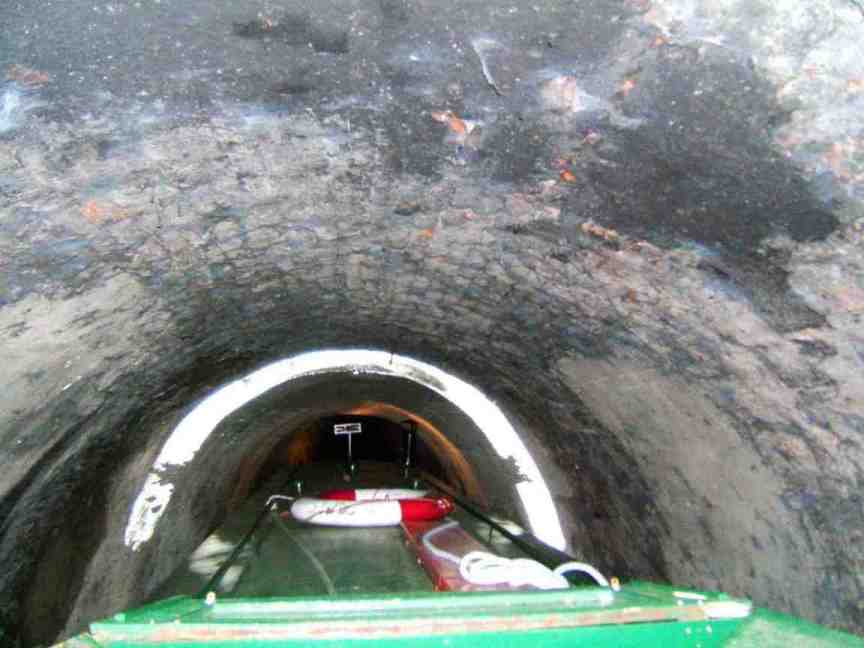
|
Not much space for "Total Eclipse" to squeeze through |
|
Saltersford Tunnel on the Trent and Mersey Canal |
On another occasion, we were travelling south through Barnton Tunnel when we heard a strange noise behind us. I brought the boat down to tick-over and we heard a passage of a different kind… “Amazing Grace” was being played on what sounded like a penny whistle from the boat following us and it accompanied us until we emerged from the tunnel. This was the first time we had heard music being played inside the tunnel and it was most appropriate too! To make the most of this musical accompaniment we remained on tick-over for the rest of the passage through the tunnel.
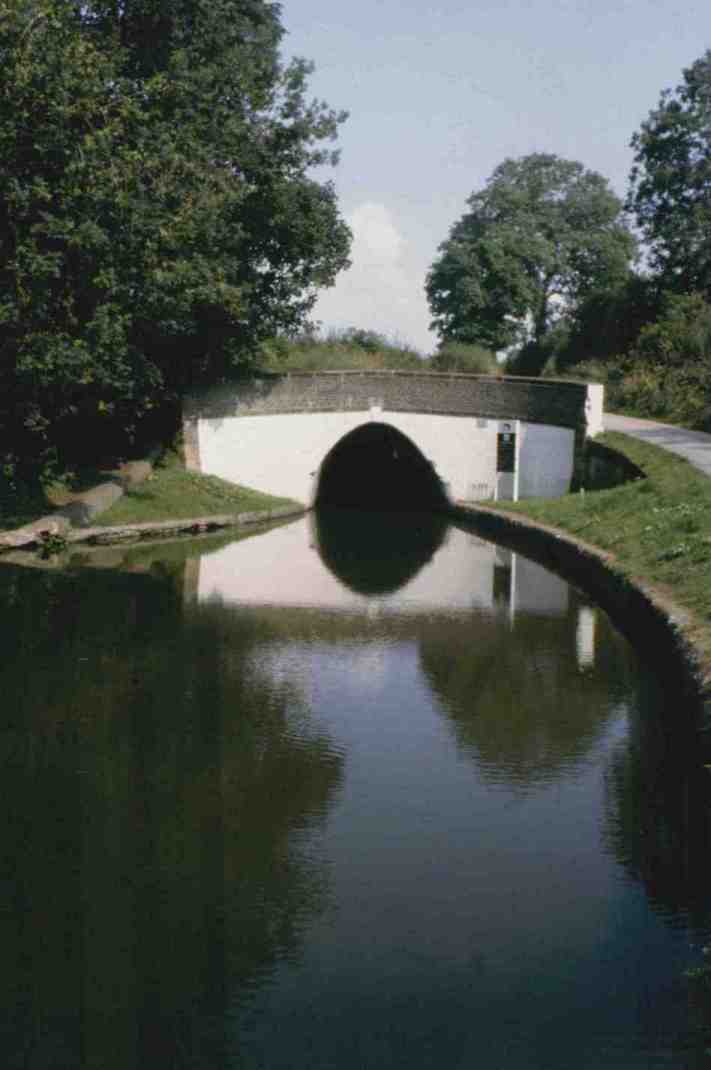
The northern portal of Barnton Tunnel
A few weeks after “Total Eclipse” had been slipped for repainting I started work again on the re-fitting of the front cabin. A concrete flagstone was acquired and cut diagonally to fit in the allotted space. This was raised onto bricks in order to provide space beneath for the ballast that had been located in the bunk that previously occupied the location and also to "focus" the heat. The bricks were not only cemented into position but screwed to the floor as well to prevent any impact "shifting". Blue tiles were chosen by Ange for the fire surround and were fitted over the heat-proof material that was originally behind the old "Torgem" fire.
Alan Savage gave me a hand to install the "Carabo", drilling the cabin roof to relocate the flue collar and welding various fittings to the fire and flue, as well as filling the hole at the location of the old fire. I felt a great sense of achievement when this was completed as I could then remove the "Torgem" and dismantle the toilet and wash basin compartment. Once this was accomplished I could then start on extending the shower compartment to accommodate a vanity unit (complete with basin) bought from B&Q and the relocated toilet. The wardrobe access door would have to be screwed-up and an alternative door aperture cut adjacent to the dinette. The toilet was a Thetford "Porta Potti" that was to be replaced with a Thetford CS200 Cassette Toilet when funds allowed.
“The Big Ditch” officially went on sale on the 8th August 2005. Coincidentally, that weekend we were cruising on the River Irwell with Lymm Cruising Club. Two weeks later on August Bank Holiday weekend, we attended the Inland Waterways Association National Rally of Boats held at Preston Brook. On the way to the rally we met the steam narrowboat “President” at Moore which told us that we were nearing the rally site. We had quite a good mooring two minutes walk from Red Brow Underbridge which was one of the access points for the show ground located on the loop of the canal between the main line and the Runcorn Arm of the Bridgewater Canal.
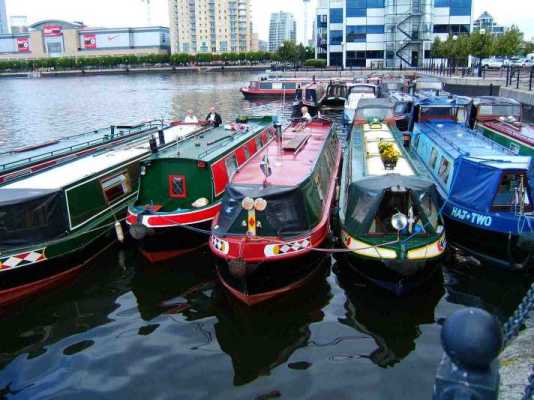
|
Narrowboats from Lymm CC moored at Salford Quays on the River Irwell |
|
("Total Eclipse" is the third boat from the left) |

| Nigel Foster at the tiller of "Vive Para Hoy" in Manchester Docks with the |
| "Theatre of Dreams" (Manchester United Football Ground) in the background |
The weather could not have been better and walking around the exhibits we renewed quite a few acquaintances. Ange wanted to look onboard some of the new narrowboats on display, mainly to get ideas for our forthcoming partial refit (even though the plans have been made and some of the materials bought). One boat in particular caught our eye. We climbed aboard and took photographs of the Kendall Narrowboats exhibit which was based on a Liverpool Boats semi-trad shell and had a good build and fit-out quality as well as a good lay-out. The galley area was exactly the same lay-out as that on our boat and the use of modern materials was inspiring. I suspect that many boat builders use proprietary kitchen units and modify them for use in fitting out boats. Consequently, when we come to refit the galley on “Total Eclipse” this will most probably be the way that we go. It would be very nice to have a boat that did not require jobs to be done on it and spend the time cruising but this is not a financial possibility. Even so, I do not know if I would like to replace our boat with a new one.
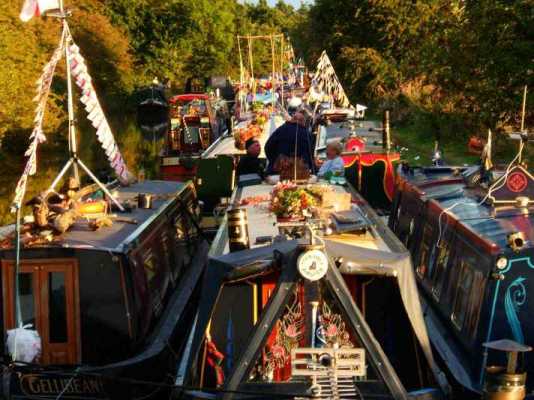
Boats moored at the 2005 IWA National Rally, Preston Brook
After viewing the boats we continued our perusing but did not buy much from the multitude of stands… only a second-hand cd of movie themes and a book entitled “Total Eclipse” which we could not walk past without buying. Tony and Linda Whalley from Lymm CC had also seen the book and nearly bought it for us. The second day of the rally was noticeably busier than the first and on our second visit we looked around more of the craft stalls but the weather broke for the Bank Holiday Monday and we made our way back to Oughtrington in the pouring rain. As is usually the way with these things, when we reached our mooring the rain stopped and the sun shone for the rest of the day. It was the second National Rally that I had attended but it was difficult to say whether or not the 1988 rally was better attended as in 1988 the boats were moored on not only the Bridgewater Canal but the Rochdale Canal and the River Irwell as well.
When the IWA Annual Report was published I read it and noted that 420 boats attended the rally as did 23000 paying visitors and 3000 children. I will have to look in my back-editions of "Waterways World" to discover if it is more or less than 1988. I suspect that it is less but we will have to wait and see.The 2005 season came to an end with the usual end of social evening and subsequent cruise to Grappenhall Village Hall. Permission had been obtained from the farmer who owns the land to extend the newly reopened carpark at Oughtrington. A couple of weeks later a work party was held to remove the fence that marked the boundary of the car park, erected a new one about four metres further along and clear the ground of the various grasses and bushes. The farmer could not use the land for grazing as there is a plant growing there that upsets the livestock’s stomachs. A concrete bunker was erected to house the newly purchased generator that would provide mains electricity on the moorings and a hose reel was also installed for the water tap. The work party was well attended and the outcome has made Lymm CC’s Oughtrington moorings even better than they were previously. Oughtrington is really Lymm CC’s best kept secret!
As the year came to a close I was pleased to hear that work had started on the restoration of the Manchester, Bolton and Bury Canal were it joined the River Irwell in Manchester and on the South Docks Link extension to the Leeds and Liverpool Canal in front of Liverpool’s Pier Head. But another piece of news that, on the surface of it was not so good was that British Waterways was to take over the administration of the Bridgewater Canal. This could have far-reaching implications regarding the mooring and licence fees that we and many other boaters have to pay and could make canal cruising for them (and us) too expensive. We will have to wait and see what the future holds in this direction.
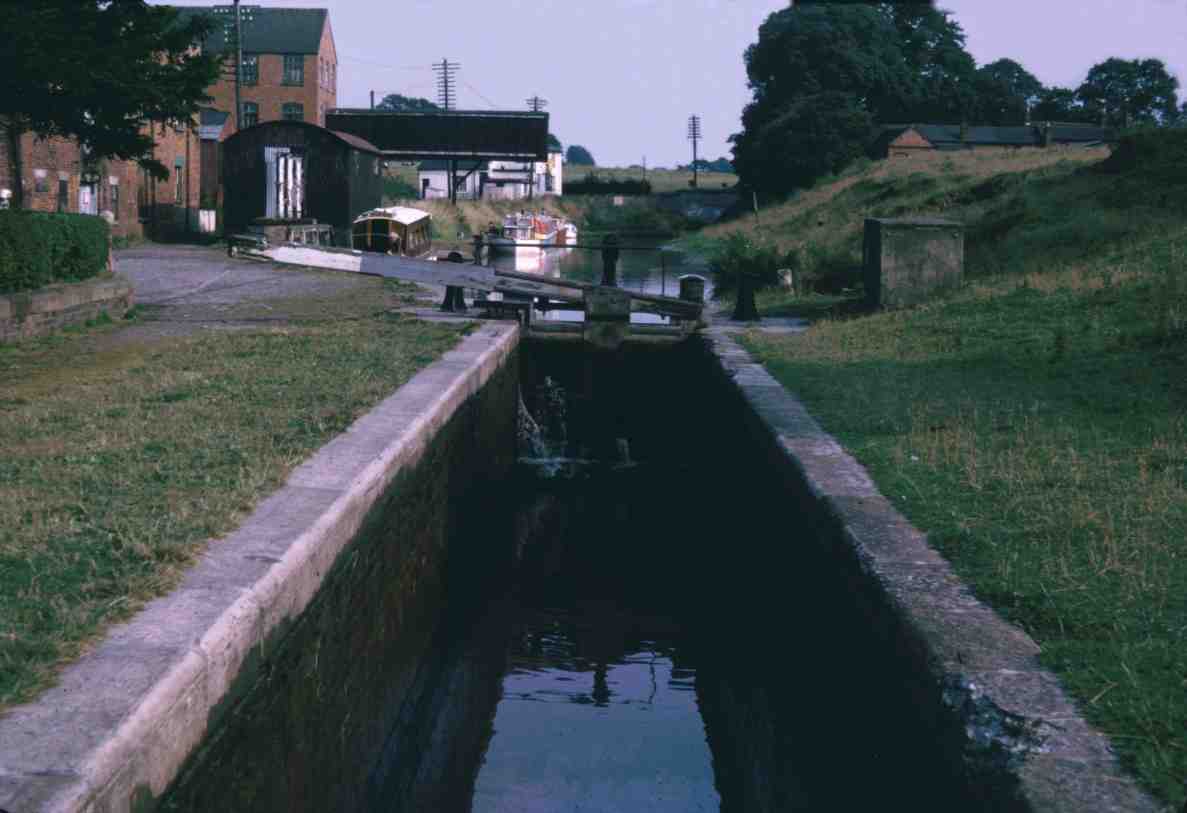
Audlem in 1966...
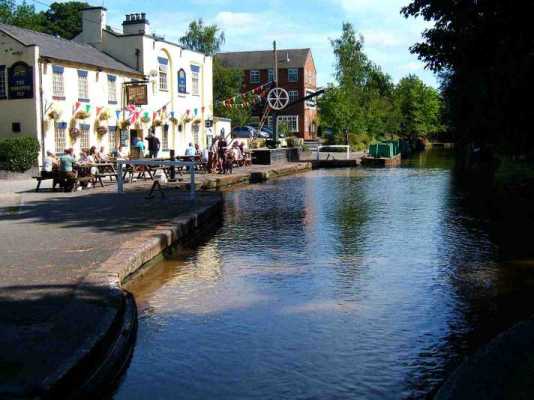
... and from virtually the same position in August 2005
Late in November, I was contacted by Stuart Wood (no relation) from Radio Merseyside who asked me to participate in a radio interview on the Roger (“Oolah”) Phillips (Radio Merseyside “War of the Worlds” joke) show the following week. Needless to say, I didn’t have to be asked twice. The only problem was that the previous interviews I have had were pre-recorded but this one was going out live… quite a daunting thought, but I needn’t have worried as everything went according to plan. During the interview we chatted about “The Big Ditch” and set a question for a phone-in competition to win a signed copy of the book. Other topics of conversation included the Pier Head Extension to the Leeds and Liverpool Canal and other canal-related subjects and everybody who heard it said that it sounded very professional.
After the broadcast, we met up with Andy Ball who first interviewed me in 2003 when “The Duke’s Cut” was published and made plans for canal-related broadcasts in the future. We were to contact British Waterways to explore the possibility of being on the “try-out” boat when the Pier Head Extension was completed and report on the journey for transmission. Other ideas for future broadcasts included a programme transmitted from a narrowboat cruising along a canal (guess which boat) using a new piece of equipment which is a radio station in a suitcase and a regular canal spot as well. Watch this space!
Canalmanac 2003 to 2005... Epilogue
How things have changed over the last few years. We now have our own narrowboat and go cruising most weekends (even in the winter), have at least two holidays a year on the boat, attend rallies, cruises and other functions connected with canals and inland waterways. As well as being members of Lymm Cruising Club I was voted onto the club’s committee and a director of Lymm Properties Ltd... the company that looks after Lymm CC’s assets. We have received a lot from Lymm Cruising Club and it was nice to be able to give something back in return.
There are still some local canals that we have not yet cruised but would like to cruise... namely the Caldon Canal; which we have cruised past the entrance to but never ventured up and the Lancaster Canal; when we have plucked up enough courage to brave the River Ribble Estuary. The Scottish and Irish waterways have always held a fascination for me and, since partially restoring “Phial” have had a wish to explore them. The Caledonian and Crinan canals have also long beckoned me and, since the construction of the Falkirk Wheel and the accelerated reopening of the Scottish Lowlands canals so have the Forth and Clyde and the Scottish Union canals.
The French waterways are tempting us as well. There was recently a food programme on BBC2 entitled “Rick Stein’s French Odyssey” where the famous chef cruised through France to the Mediterranean along the Canals du Centre/Lateral/du Midi on a barge, sampling both solid and liquid cuisine on the way. He travelled in the wake of Terry Darlington (“Narrow Dog to
Carcassonne”). Of course Terry and that other renowned narrowboat adventurer... James Griffin in “Ocean Princess” are not the only canal enthusiasts to have taken their boats across the English Channel but if we were to do so I think that it would be from the safety of an articulated lorry. The more I see, read and learn about the French waterways the more my appetite is whetted. There are many wonders such as the eight step staircase locks and water slopes at Montech not to mention aqueducts, lifts, and other oddities that definitely warrant examination. Maybe, one day we will be able to visit these and the other wonders mentioned.
Ange and I cruising along the Trent and Mersey Canal in 2003
(Photograph - Joan Hodrien)
Not only have I fulfilled a life-long ambition to have a canal book published but have been greedy in having two books on the subject published, I have had several interviews on the radio to publicise "The Duke’s Cut" and "The Big Ditch" and promote other canal related subjects, been involved with the production of a television series and even been on the local television news. We now look forward to a future featuring narrowboats and canal cruising and to the adventures that lie ahead of us aboard "Total Eclipse" on the increasing range of the beautiful Canals and Inland Waterways of England and Wales.
Chapter 4 -
Llangollen Pilgrimage
In May 2003 we had two week’s holiday due and decided to spend our time off work on a trip up the Llangollen Canal. It had been nearly twenty years since I last cruised this canal and it would be interesting to see how much it has changed during that period. It was the first time that Ange had been on this canal and she was looking forward to seeing in the flesh a canal she had heard so much about.
We set off from our moorings at 07.00 on Saturday 10th May 2003 and headed south along the Bridgewater Canal. The weather was warm and sunny but the weather forecast gave no guarantee of it remaining so. We stopped at Thorn Marine, Stockton Heath for diesel fuel then carried on towards Preston Brook and the Trent and Mersey Canal.
At Preston Brook Tunnel we followed a charity boat through then queued up at Dutton Stop Lock. A Claymoore Navigation hire boat followed us through Saltersford Tunnel and one of the female crew members didn’t like going through tunnels so walked across on the old horse path. When she was getting back on the boat after it had passed through the tunnel she missed her footing and ended up in the canal. After a quick dry and change of clothes the unfortunate lady was ready to walk across Barnton Tunnel which is about a quarter of a mile from Saltersford. When they emerged from the tunnel and the aquatic crew member boarded the boat (successfully this time) we made friends with them and, as it was their first time on a narrowboat, we gave them some advice on boating, boat handling and canal etiquette. We cruised all day having lunch whilst on the move and that evening we stopped outside “The Old Broken Cross” at Lostock Gralam for a meal. We met our new friends in there and sat at the adjacent table whilst we ate then said goodnight to them before we moved up to Billinge Green Flash to moor for the night away from the hustle and bustle of the adjacent main road.
The following morning we reached Middlewich, negotiated the locks (giving our novice friends lock tuition into the bargain) and joined the “Shroppie’s” Middlewich Branch. The Middlewich Branch is quite shallow and we took our time along this stretch of canal. At Barbridge I was delighted to see the “Juliana” moored there. She must be the last remaining boat from the Dean’s Hire Boat fleet still in existence. She has a Taylor hull with a superstructure built by Deans in their own workshops at Christleton. In fact, I remember seeing her being built in the early sixties along with one of her sister craft. We moored for the night at Barbridge outside the “Old Barbridge Inn” where we had a meal with our new friends. They had originally planned on cruising up the Llangollen Canal to Whichurch but, reading between the lines, Ange and I thought that it was too much like hard work and they decided to cruise along the “Shroppie” to Nantwich and take their time cruising back to Preston Brook instead.
The next morning we bade farewell to our new friends and cast off in the direction of Hurleston Junction and the start of the Llangollen Canal about a mile distant.
On reaching Hurleston I remembered that there used to be a sign that warned boaters that craft with a draft exceeding two feet (60 cms) do so at their own risk. As “Total Eclipse” has a draft of two foot six inches (75 cms) I wondered if the canal’s depth was still the same. On entering the bottom lock a sign advised the lifting of fenders... some things never change! We climbed the four locks at Hurleston and on passing through the first bridge hole I was surprised when the boat almost came to a complete standstill due to the amount of water flowing down the canal. This was one of the features of the canal that I had forgotten. It wasn’t as noticeable in a fibreglass boat but in a steel boat, the flow of 8.5 megagallons of water per day coming down the canal has quite an effect on craft navigating upstream. Carrying on upstream we met a dredger, the first of many, scraping silt from the bed of the canal. The dredger was basically a JCB placed on a pontoon and the resulting dredgings were being spread over the adjacent field. A little way further on, at Burland, we passed beneath the pipes immediately after bridge six and I was taken back to my childhood when I used to run up the slope encasing the pipes whilst Mum and Father went to the nearby shop for provisions.
The two locks at Swanley and three at Baddiley were just as I remembered them except that the top ground paddles had been modified. Previously, when one lifted these paddles water used to spray up the breather pipes and wet the legs of the unwary standing over them. Another modification to the ground paddles was that originally a steel wedge was placed between two of the pinions that raise the toothed rack connected to the paddle assembly. To prevent the wedge being lost it was attached to the main casting by a chain usually covered in oil. I actually have one of these wedges (still with the dried oil on it) that was found on the ground at a lock nearly fifty years ago. Above Swanley Locks, a man was selling hand painted flower planters complete with a colourful collection of flowers. Ange bought for the roof of “Total Eclipse” and very nice it looked too.
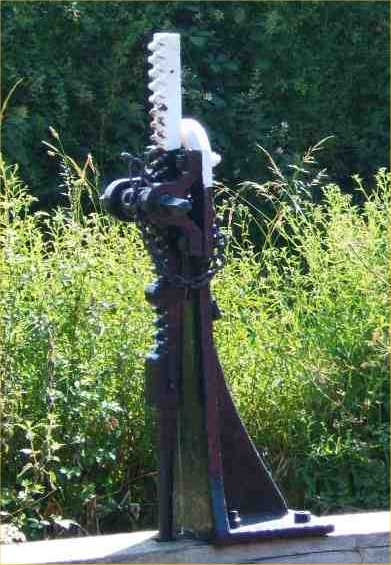
|
A typical Llangollen Canal Ground Paddle... the chain and steel peg are clearly visible. |
|
This example controls the overflow weir at Newmarton Top Lock |
The next obstacle was bridge nineteen... the last remaining of the original wooden lift bridges operated by swinging on a chain. I nearly fell over laughing at Ange when she was trying to lift the bridge. She would manage to get the bridge so far up then it would start to go down again whilst she changed positions to get a better purchase on the counter-balance weight.
Bridge twenty at Wrenbury was a different kettle of fish. The original “chain wound by a windlass” bridge has been replaced by a electo-hydraulically operated structure, complete with flashing lights, audible two-tone siren and a movable barrier to prevent traffic driving onto the bridge whilst it is being lifted. Ange took the operation of the bridge in her stride and when she returned to the boat after we had passed through she said... “This girl will stop traffic” (as in the television advertisement of the time for Alberto VO5 hair products). She also likened the Llangollen Canal to a cross between the “Krypton Factor” and “Gladiator”... two television programs where contestants have to solve logic puzzles and perform feats of agility and strength.
After passing through the normally open bridge twenty one we passed the new winding hole constructed, no doubt, to facilitate the hire boats based at Wrenbury Mill.
Our first night on the canal was spent below Grindley Brook Locks. We moored well away from other craft as we wanted to use the generator for various reasons. After tea, I walked up to the staircase locks and visited Tom Merral who lives at the top of the locks. We spent time reminiscing and talking over old times as well as discussing our respective fathers and the relationship of mutual respect that they had for each other. I gave Tom a proof manuscript of "Canalscape" to read as there were parts that required clarification and also because it mentioned him and his family. I didn’t want to put anything in that was incorrect, would offend or embarrass him. As we parted we promised to contact each other when I returned home to discuss any changes to be made in the manuscript.
The next morning it was raining intermittently as we set off up the flight of locks. I had taught Ange how the staircase lock was operated and she was helped by the lock-keeper who seemed impressed with her mastery of the locks. When we reached the top of the locks Ange went to the canalside shop and whilst she was away Tom Merral came and said hello. He told me that he had read some of the manuscript that I gave him and was most impressed with it and... one thing that I try to ensure in all of my manuscripts... he enjoyed reading it. When Ange returned from the shop I introduced her to Tom and after filling the water tank and emptying the loo we were soon on our way again.
The next notable happening was our arrival at the junction of the Whichurch Arm. The last time I had seen the location of the arm it was just a field of reeds. We decided to venture down the arm and managed to negotiate the tight bed into it without too much trouble and cruised slowly past the moored craft awaiting their owners to return from the town. To be able to cruise down the partially restored arm as far as the winding hole was really quite remarkable. When funding allows, the arm is to be extended into Whichurch town centre itself with the help of an inclined plane which may be similar to the design proposed for the upper reaches of the Lancaster Canal.
After leaving Whichurch behind the weather degenerated over the course of the day. We tied up for lunch just before Tilstock Park Lift Bridge (bridge 42) as it started to rain again. After lunch the rain had stopped and we crossed Whixhall Peat Moss. The scrap yard here appears to have been relocated and is now adjacent to Morris’s Lift Bridge (bridge 45) where we had to beach the “Maureen” in 1964 when she sprung a leak. Even so the area has become more pleasant over the years. English Nature have gone to great pains to inform walkers and nature enthusiasts alike of the unusual landscape, its fauna and flora. The towpath forms part of the Moss Trail that winds its way through the area, which is more reminiscent of Ireland than Shropshire. Peat is still cut on the moss and whereas there used to be a narrow gauge railway that transported the cut peat today it is (unsurprisingly) transported by road.
The weather brightened up as we approached Ellesmere. We passed the location of Sid Dean’s caravan where we had tied over forty years ago whilst cruising on "Kathleen". We wound around the meres close to the canal and remembered my childhood thoughts of connecting the canal to the meres so that we could cruise around them. After navigating the short Ellesmere Tunnel we were soon at the new Blackwater Meadow Marina situated close to the junction of the arm of the canal that brought the canal straight into the heart of the town. A colleague has a glass-fibre boat at this marina and in some ways I envy the idyllic location but not at the height of the season when there are queues at locks and one has to be especially vigilant when approaching a bridge or blind bend.
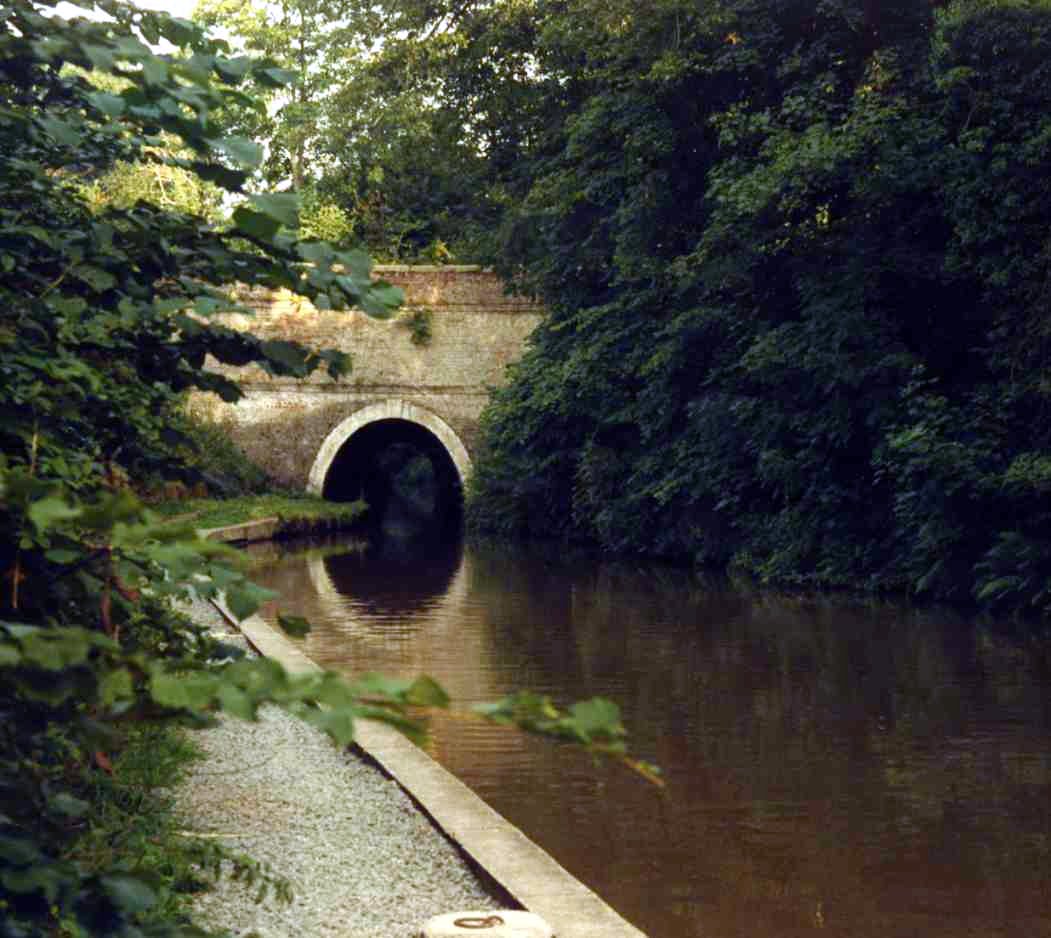
The 87 yards (85 metres) long Ellesmere Tunnel
Not long after passing the entrance to the Ellesmere Arm the weather degenerated again. The wind grew stronger and was lubricated by torrential rain. I was tempted to stop and erect the rear deck cover but I didn’t think that I would have very much success in the wind so we pressed on. It was half-way between Ellesmere and Welsh Frankton that we decided to call it a day and we moored on the recently provided moorings... but first we had to moor the boat. The wind was blowing so strongly that we had difficulty placing the boat adjacent to the towing path and at one point the wind blew the boat right across the canal. Fortunately we have a centre rope to facilitate mooring. As usually happens, the moment one has become completely saturated after hammering the mooring pegs into the towpath and tied the ropes to them... the rain stops and the sun begins to break through the clouds. But we had decided that since we were moored we would stay moored so we started to prepare our evening meal and settle down for the night.
The following morning, the weather was much better. The wind had subsided, the rain had stopped and the sun was shining. I left Ange in bed and made an early start. We passed the restored junction at Welsh Frankton with the Montgomery Canal which was beckoning us to stop and descend to the newly opened extension to the restored canal. But that would have to wait for another time and we pressed on, stopping for breakfast below Newmarton Locks.
Not long after Newmarton we saw about seven or eight Yorkshire Terriers sitting on the inside of the window ledge of a canalside house. Unfortunately we had passed the scene and couldn’t reverse to take a photograph due to there being a boat following us. We soon reached the location of Usher’s Bakery. This shop sold not only the bread that they were renowned for but everything from ice cream to fresh vegetables. The demise of this popular shop must be mourned by many who knew the canal in the past. The adjacent bridge (bridge 13) has been rebuilt to accommodate a road widening scheme.
The weather remained bright and pleasant and we were soon passing the location of another new marina and golf club just off the A5 trunk road at Preesgweene (bridge 18). The garage opposite, that could once be accessed from the canal no longer displayed the friendly BP Boat Services “propeller sign” informing boaters that they could buy petrol here ready mixed (usually at a 50 to 1 ratio) for their Stuart Turner or outboard motor. Not surprising really as it had changed to a Shell garage. The pub opposite seems to have disappeared beneath the new golf club and the “Little Chef” restaurant adjacent to the garage wasn’t there on my last visit either.
We wound around Chirk Bank on the section of canal where a concrete lining which prevents the canal from (literally) slipping down the hillside. I remembered walking along this section when the canal was drained for the construction of the concrete lining and it is good to see that the theory has worked in practice.
We soon rounded the bend that leads to Chirk Aqueduct. This beautiful structure is usually overshadowed by its larger and more famous brother at Pontcysyllte as well as by, in more literal terms, the adjacent railway viaduct. It is still a wonderful piece of civil engineering even if the cast iron trough cannot be seen when full of water. A few years ago I had the opportunity of walking along the bed of the aqueduct when it was dewatered for maintenance. In this state the cast iron trough is visible and differs from the one at Pontcysyllte in many ways. But back to our pilgrimage... fortunately the wind had dropped when we made the crossing and the sun was still shining as we floated across the valley looking down on the River Ceriog and the surrounding fields.
Moored in the basin between the aqueduct and the tunnel was an ex-British Waterways hire boat from the 1960’s... “Water Lupin”. It looked to be well maintained and in good condition. We entered the tunnel behind a hire boat and I was immediately struck by the narrowness of the tunnel’s bore. With being used to Preston Brook Tunnel on the Trent and Mersey which doesn’t possess a towpath and consequently appears wider, it surprised me as to how much space the towpath actually took up. The boat in front bounced off the walls all the way through and I cringed at some of the scraping and banging sounds emanating from in front of us.
Once out of the tunnel we cruised through the Chirk Cutting with the sun glinting through the trees. The next feature of note is Chirk Marina. I had visited the site when the marina was new and the area hadn’t been landscaped. This was my first opportunity of seeing it completed. It is most impressive with its covered wet docks and workshops. Many of the craft moored there can be seen from the canal and I often wonder why owners of boats let their once prized possessions fall into the condition that some of the boats moored at this marina were in. Flaking paintwork, moss-covered and dilapidated, some of the craft were crying out to be cleaned and cared for once more.
After passing the marina we crept along behind the hire craft that we followed through the tunnel and I would not envy anybody dragging craft this size along this shallow, winding waterway, especially when manned by an inexperienced crew. “Total Eclipse” is forty feet long without fenders and I consider this to be the ideal length... it is relatively easy to wind (turned around - in fact it can be winded virtually anywhere on the Bridgewater Canal) and stops well within its own length when meeting other craft at a bridge hole or blind bend.
We carried on through Whitehouses Tunnel and wound into the Vale of Llangollen. When we reached Vron we had to hold back to let the trip boat that operates trips across Pontcysyllte Aqueduct wind and moor. The hire boat that had been in front of us all the way from Chirk also moored and we rounded the bend onto the approach embankment of “Ponty”. Soon we were watching the ground fall away from us as we started to cross this the ultimate icon of canal engineering. Emotion overtook me and I could feel my eyes filling up with tears. A couple of years ago I didn’t think that I would ever be steering my own boat across "Ponty" again. I controlled my emotions and concentrated on the job in hand. Ange was sitting on the towpath side of the boat and wouldn’t even look at the trough a couple of inches below the level of our gunwales on the other side. She had walked across the aqueduct many times when we had gone out for a drive and even been across on the trip boat but this was the first time she had felt the exhilaration first hand of crossing without the safety of the towpath handrail, a window or cabin side to protect her from the one hundred and twenty one foot drop to the River Dee below. Half-way across she stepped onto the towpath to take photographs of the boat crossing the aqueduct.
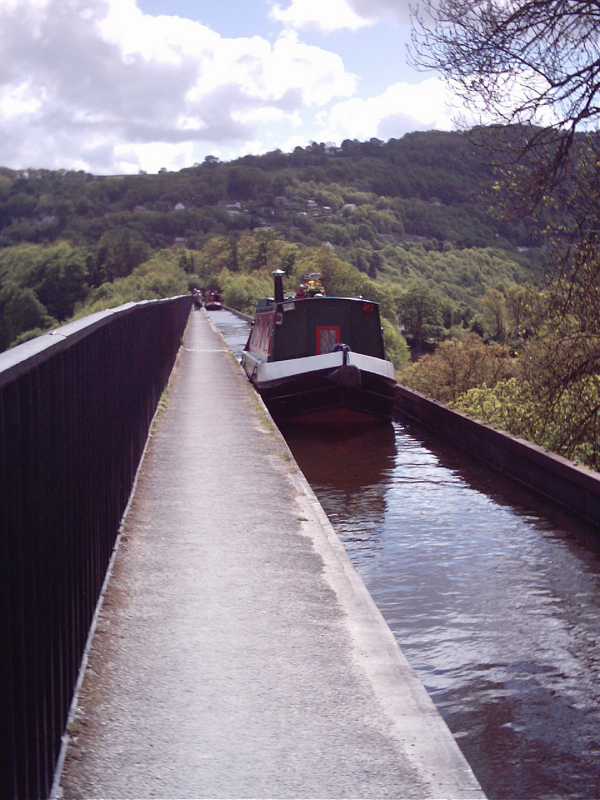
"Total Eclipse" crossing the Pontcysyllte Aqueduct
(Photograph - Angela Wood)
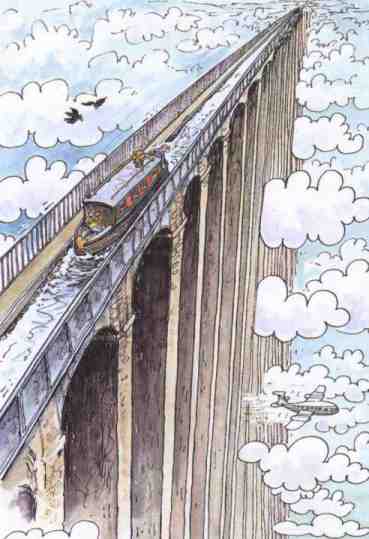
A postcard depicting a narrowboat crossing the Pontcysyllte Aqueduct
Once across the inland waterways’ answer to Blackpool’s “Big One” we turned sharp left at Trevor and headed along the “Water Line” to Llangollen. I was impressed at how much of the canal had been lined with a new concrete trough even if it was a little narrow in places. Once back onto the “natural” canal we touched the bottom of the canal a couple of times before we finally made it to Llangollen.
The Llangollen Canal winding through the Welsh Mountains at Sun Trevor
We were fortunate in that there weren’t many craft moored at the town. Ours was the second boat from the start of the moorings and we were only a short distance from the town. Once moored we decided to visit the town and have a look around the shops. I was also eager to see what progress had been made on the new marina-style short stay moorings adjacent to the winding hole. I was disappointed to discover that there had been no progress made at all. In fact, I don’t think that the project has even been started. When I later made enquiries, I was told that there had been opposition to the marina from local residents. The local residents don’t oppose people from the canal spending money in their town to boost the local economy though! I look forward to the day that common sense prevails and the marina is completed and open for visitors.
After walking around the shops and buying fish and chips we returned to the boat to eat our tea and spent a pleasant evening sitting on the front deck of the boat basking in the evening sunshine.
The following morning we decided to cast off early, make our way to the winding hole and return through the narrow sections of the “Water Line” before the hire boats made the way up. We stopped at the Anglo Welsh base at Trevor for diesel fuel and a few other bits before crossing back over “Ponty”. We were behind a large hire boat (again) and they were making heavy going of the narrow winding section below Vron. Whilst cruising along this section I heard the unmistakable drone of four Rolls Royce Merlin engines in the sky. When I glanced upwards I saw the dark shadow of what I think was a Lancaster bomber flying up the valley. It was another of those occasions when I wasn’t quick enough with the camera and it had passed overhead before I had time to photograph it.
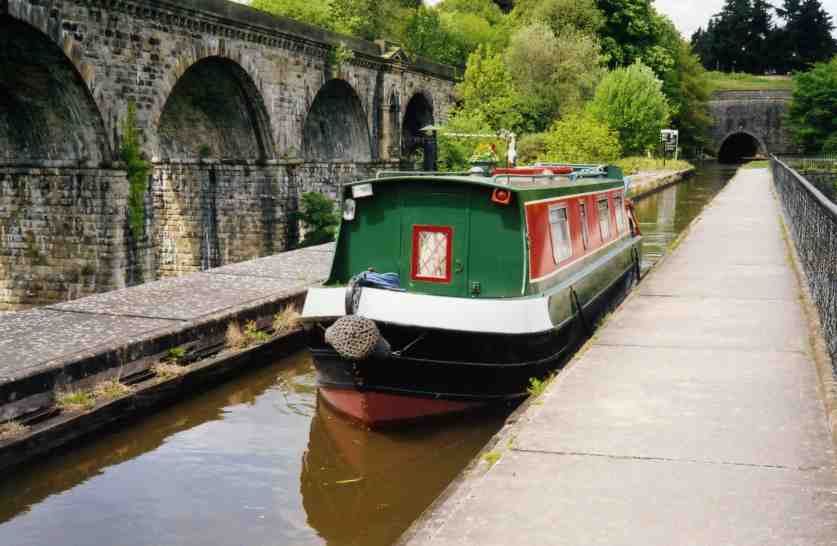
"Total Eclipse" crossing Chirk Aqueduct (I wonder who's steering?)
We were soon passing the marina at Chirk and I saw a narrow boat fender floating in the canal. We had planned to stop for lunch around about this time so when we moored close to the old railway trans-shipment wharf. I walked back the hundred metres or so with the boat pole, fished the fender out and returned to the boat with our new, spare fender.

"Total Eclipse" moored opposite the old warehouse in the Ellesmere Arm
After lunch we carried on in the brilliant sunshine, made a short excursion down the Ellesmere Arm at teatime for photographic purposes, turned around and carried on before mooring for the night just past Lyneal Wharf (between bridges 53 and 52).
The following morning dawned wet and breezy so the rear deck cover was erected and after casting off we approached the first bridge gingerly to see if we could fit under it with the cover up. To my surprise we did so we carried on across Whixhall Moss and stopped at the “Shop in the Garden” half-way along the straight stretch between bridges forty four and forty three for milk etc. After this our next stop was at Grindley Brook and we moored at one of the excellent water points to replenish our water tank. Whilst this was filling I emptied the loo and rubbish. This done we had lunch and proceeded to the locks. Ange made mincemeat of the staircase but coming out of it I caught the still erected cover on the low road bridge at the tail of the lock. The only damage was one of the securing tabs was pulled out but, as it had stopped raining, I decided to take the cover down anyway. Ange took the boat through the next locks, followed by Povey’s, Willey Moor and Quoisley. She was becoming very accomplished at placing the boat in the lock without banging or scraping the sides and could do it as well as I could. We moored for the night about half way between Steer Bridge (bridge 24) and Marbury Lock. As soon as we moored it started to rain again so the cover was erected for the night.
The next day was another “blowing hot and cold” day but we decided to take the cover down and if we encountered a shower we would use the big brolly. We stopped at Wrenbury for a look around the canal shop next to bridge 20 then walked into the village for provisions. Needless to say it decided to rain as we were returning from the village so we had an early lunch before proceeding.
Ange took the boat through Swanley and Baddiley Locks whilst I operated the paddles and gates and as we cruised on to Hurleston she fell asleep. When we reached Hurleston Locks I took the boat through single-handed not wanting to wake my wife but when she surfaced she took over handling the boat. I was becoming more and more impressed at her skill in handling the boat and, as previously mentioned, she was handling it as well as I could.
Once we emerged from the locks at Hurleston we turned south along the “Shroppie” and headed towards Nantwich. The rain started again and the wind picked up once more. Another ex-British Waterways hire boat... “Water Lilac” was spotted not far from Acton then we encountered a raft constructed from plastic barrels being propelled along the canal by students from the nearby Reaseheath College. We gave way to the raft and took photographs as it passed. It was when we arrived at Nantwich that we discovered that we had been sharing the Llangollen Canal with a one of my heroes and his family. Harrison Ford (of Han Solo in "Star Wars" and "Indiana Jones" fame) and his partner Calista Flockhart (Ali McBeal) had hired a narrowboat from Maestermyn Marine not far from Welsh Frankton and the trip was documented in the newspapers. Just think... we most probably passed them and didn't realise it!
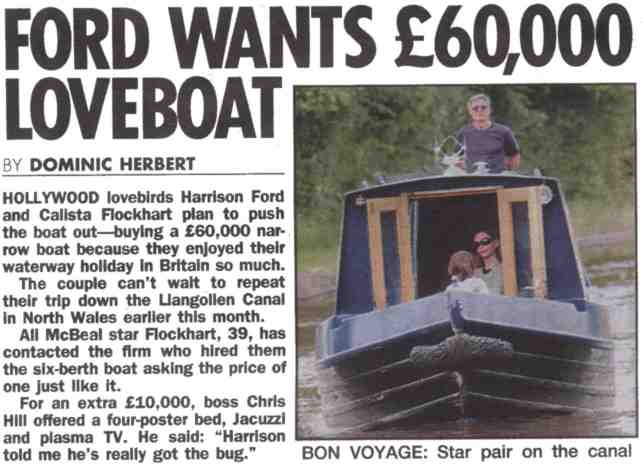
A newspaper cutting of Harrison Ford's Llangollen Canal holiday
We passed the moorings belonging to the Nantwich and Border Counties Yacht Club (N.B.C.Y.C) and I was not surprised to note the absence of any of the varnished mahogany Taylor cabin cruisers I had seen as a child. I could see only two wooden craft... one looked like Sid Dean’s old boat “Falling Sands and the other had what looked like a “Walton” wooden hulled boat with a full-length timber cabin. The remainder of the craft were either GRP cruisers or narrow boats. One narrow boat that did catch my eye was “Printer’s Devil”. This looked a lot like “Kottingham”... the boat used for a project boat designed by Chris Lloyd for a series of “Waterways World” articles. When the boat was sold on, its new owners were plagued with enquiries about the boat, so much so that they consequently decided to rename it. Could “Printer’s Devil” be the original “Kottingham”?
We turned down the basin at Nantwich and planned to visit the excellent boat chandlery there. As I was manoeuvring the boat ready to moor the wind caught us and I had to make us perform a pirouette the wrong way (at certain engine speeds when reversing, “Total Eclipse's propeller thrash causes the boat’s bow to veer to port and the wind blew me in the opposite direction so I had no directional control going backwards) when mooring alongside the visitor moorings. And, after all that the shop didn’t have what I was looking for so it was a fruitless exercise. We retraced our steps, past Hurleston and moored at Barbridge for the night. The wind had now dropped and the rain had ceased... doesn’t that always happen when one decides to moor for the night!
The next day promised weather brighter than the previous day so I decided to lower the rear deck cover and if we encountered any rain showers I would use the large brolly again. I can assure you that the brolly was opened and closed quite a few times along this stretch of canal. We stopped for lunch not far from Church Minshull then pressed on to Middlewich. During the cruise to Middlewich it started to rain again but by the time we entered the town the sun was shining and it was quite warm. Middlewich was busy as usual and we had to queue up for the locks. After an hour we were sitting in Big Lock waiting for the gates to open and cruise down one of my favourite sections of the Trent and Mersey Canal.
By now, the sun was blazing and it was quite hot. As we cruised through the wooded cuttings and crossed the elevated embankments we both had the feeling that... “It doesn’t get much better than this”.
Unfortunately, our euphoria was short lived. As we passed through Billinge Green Flat the sun went behind a storm cloud, the wind cropped up again and it started to rain heavily. I put the boat into neutral and let it coast whilst we erected the cover over the rear deck. We erected it just in time as the rain had turned into a torrent. By the time we reached Wyncham Wharf the rain had turned to hail and then it started to thunder. The wind was behind us and even with the engine on low revolutions we were doing four miles per hour.
We were approaching the road bridge next to the Lion Salt Works and looking at the height of the bridge I had doubts as to whether or not the boat would pass beneath with the cover erected. I put the engine into reverse but the wind was blowing us closer and closer to the bridge. Needless to say, the cover would not fit beneath the bridge and the momentum of the boat tore the windscreen surround from its hinges as well as the starboard side screen which ended up in the canal. Fortunately it floated. I managed to reverse the boat backwards from the bridge, folded the remaining sections of the cover and fished the side screen out of the water. I then saw the audience! True to form, when one is in an embarrassing situation like this, people appear from nowhere to observe the what is going on!
After this incident I got out the big brolly again and we were blown down Marston New Cut. Fortunately, the rain soon abated and when we were in the shelter of the trees by Marbury Park the wind almost disappeared. We passed the Anderton Lift with its new visitor centre and in the wide flash after the lift Ange brought me a cup of coffee. It was one of the best cups of coffee I had ever tasted as it was laced with Bailey’s Liqueur. We soon arrived at Barnton Tunnel and passed straight through it as we also did at Saltersford Tunnel.
We had arranged to meet our friends Jan and Jim on “Grandma Cheese” and spend the evening with them on their moorings by the dry dock at Dutton Stop Lock. We first met them at our old Walton moorings on the Bridgewater Canal over two years ago. They had just purchased a narrowboat and were looking for a mooring to keep it on. Since then we had waved when passing but never had the opportunity to stop for a natter. We moored alongside their boat, were made very welcome and talked about boats and canals for most of the evening. The following morning their was no sign of them but we will meet up again soon.
After breakfast we went through the stop lock and got into the queue for Preston Brook Tunnel. There were two boats in front of us and two more came behind whilst we were waiting. Right on the hour we entered the tunnel but after a couple minutes into the tunnel the engine died. This has to be one of my worst nightmares. Ange started flashing our high-powered lamp at the boat following whilst I got onto the roof of the boat and started to pole us to the “Cathedral”... the part of the tunnel that was rebuilt when it collapsed in 1982. There is a part that I that I thought was just wide enough for two boats to pass. When we reached this part I held our boat against the wall with the pole whilst the boat behind passed us. We gave them our bow rope and they towed us out of the tunnel. Whilst passing through the tunnel Ange swallowed a fly of some description and tried in vain to eject it. She also threatened not to speak to me for a week if we had run out of fuel (which I didn’t think we had). Unfortunately the boat towing us wasn’t travelling fast enough for the “canal effect” to occur. This would have kept us in the centre of the tunnel and as things were, we must have bounced off every other brick in the as well as nearly demolishing the chimney and nearly losing the “Chinese Hat” from the top of it.
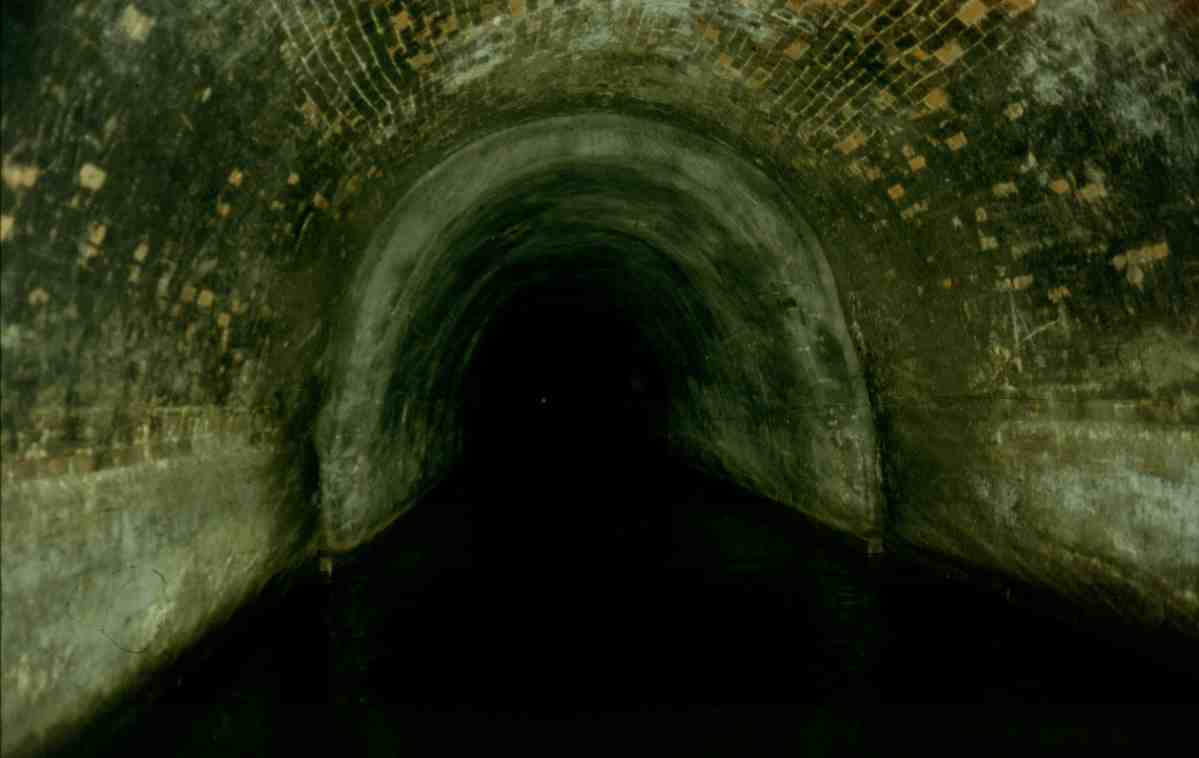
Inside Preston Brook Tunnel at the start of the relined section

The "Cathedral"... the rebuilt section inside Preston Brook Tunnel
(Just wide enough for two boats to pass... I speak from experience!)
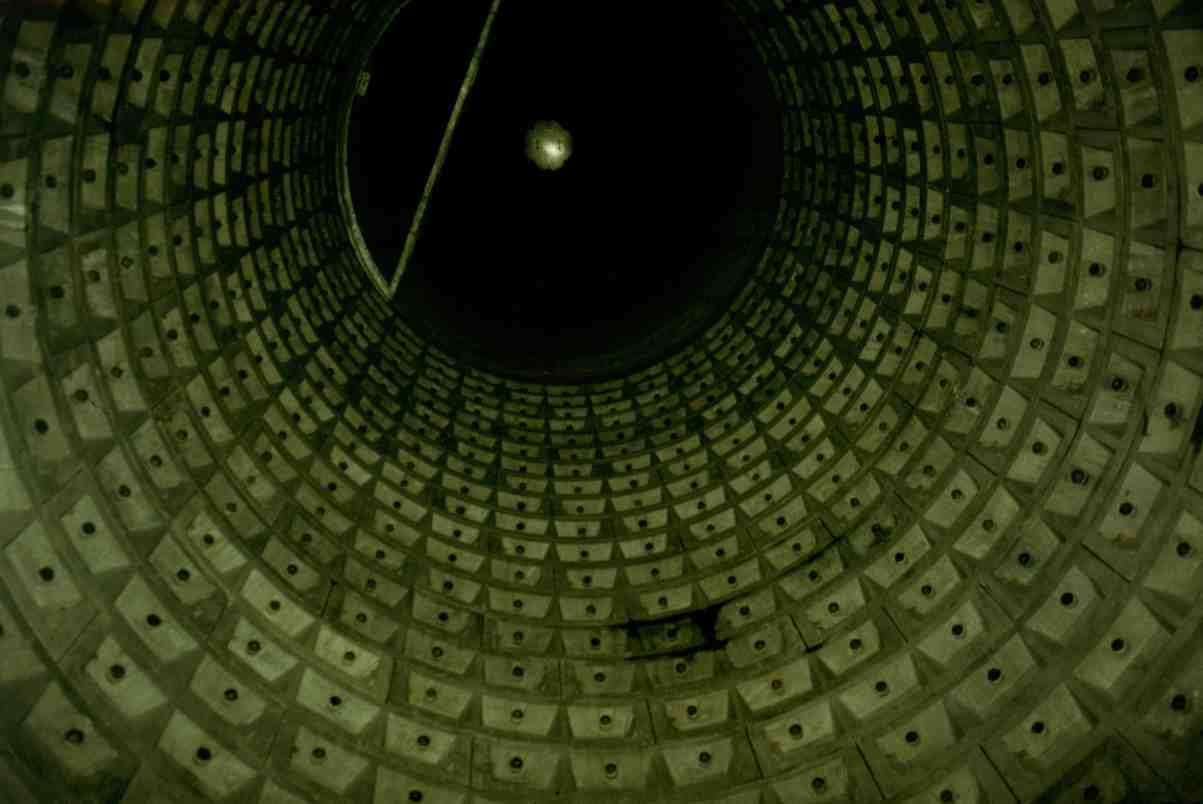
And what you see when you look up the main ventilation shaft
At last we emerged into brilliant sunlight. We thanked the crew of the boat for towing us and moored just outside the tunnel entrance. My first action was to dip the fuel tank. To my relief it was half full. I thought that we had either picked up some dirty diesel or, with all the rain we had been subjected to, some water had found its way into the fuel system. I rang Alan Savage from Lymm Cruising Club for his suggestions and he said to get some fresh fuel from Claymoore Navigation at Preston Brook as well as a new fuel filter and take it from there. In the meantime I decided to try and start the engine one last time and, to my surprise, it roared into life.
We cruised slowly to Claymoore, got our fuel and filter then moored outside Midland Chandlers which nestles in the shadow of the M56 viaduct at Preston Brook and went inside for some window shopping. After looking around at the solid fuel fires, cookers and shower baths we pressed on and stopped at Thorn Marine, Stockton Heath to empty the toilet and have a look around their shop for inspiration and price comparison. As with all specialist shops, one has to shop around as some prices were cheaper at Thorn and some cheaper at Midland Chandlers. Whilst we were moored at Stockton Heath we had our lunch before proceeding to Agden where we “borrowed” Jim Shead’s mooring as his boat was out of the water being repainted.
The next morning I investigated the fuel system and discovered that the water separator was full of black “gunge” as was the lift pump gauze and the main fuel filter. After cleaning everything and replacing the filter, I bled the system and injectors and started the engine. It ran normally and I was most relieved as the following weekend was the Federation of Bridgewater Cruising Clubs’ Annual Rally at Astley between Worsley and Leigh.
And so we had an eventful end for our pilgrimage up the Llangollen Canal. My thoughts on the canal twenty years after I had last cruised it are as follows... The locks are greatly improved as are the lift bridges (well... most of them anyway). It was good to see so much dredging taking place. The new sanitary block at Grindley Brook will be a great asset when it is completed. The on-going restoration of the Whichurch Arm and Montgomery Canal confirms British Waterways’ commitment to the canal and we look forward to sailing along new lengths as and when they are restored. Mooring at Llangollen has always been a problem even in the less popular times of the year. Let’s hope that they are able to construct the proposed new marina-style moorings at Llangollen to alleviate some of the mooring problems without too much hassle from the local residents. It would be a great asset, not only to the canal but to the town as well.
When I was speaking to Tom Merral at Grindley Brook he told me that the Llangollen Canal is his favourite canal. But, it has the ability to challenge the most experience boater with its fast running by-washes, unpredictable winds and shallow depth. Of course, he is correct. I class myself as an experienced boater and I was caught out by nearly all the observations that he made.
But, disregarding the canal’s shortcomings, it remains the most beautiful canal on our system and one of the most satisfying to navigate. It has the same charm that it possessed forty-odd years ago when I first cruised along it. Every visit brings something new or one sees something that previously was not noticed.
We classed our pilgrimage to the Llangollen Canal as a success (even though the weather wasn’t very kind to us) and we are already looking forward to cruising it again in the not too distant future.
Llangollen Pilgrimage... Epilogue
Since cruising the canal and writing this chapter the new marina moorings at Llangollen are now completed and open for business. I was interested to discover in “Waterways World” that the first boat to use the new marina moorings was NB “Amy” belonging to my old friends David and Joyce Stewart (“big box - small room”) from Preston Brook Marina (who have since joined Lymm CC).
Lymm Cruising Club’s 2005 Summer Cruise was to be up the Llangollen Canal and Montgomery Canals and is documented in Chapter Six - Llangollen Revisited. It is interesting to see how the canal has changed and what the new mooring arrangements at Llangollen are like first hand.
Chapter 5 -
Beeston Pilgrimage
Lymm Cruising Club’s Annual Holiday Cruise in 2003 was to be from 21st July to the 3rd August. The planned route was to be along the Bridgewater Canal onto the Trent and Mersey Canal to the Anderton Lift, down the lift onto the River Weaver, spend a couple of days exploring the river then down to Frodsham to join the Manchester Ship Canal, cruise down the Ship Canal to the Boat Museum at Ellesmere Port, up the Shropshire Union Canal through Chester and on to Barbridge, down the Middlewich Arm of the “Shroppie” to the Trent and Mersey Canal at Middlewich and back to the Bridgewater Canal.
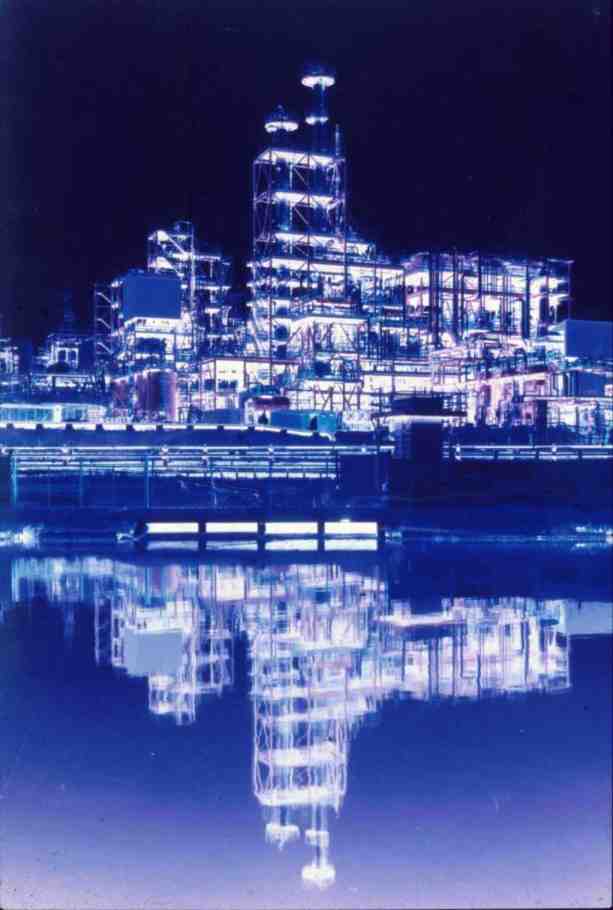
Castner Kellner chemical plant overlooking the Weaver Navigation at Weston Point
(Not a night shot but a special reversal printing process)
Ange and I were looking forward to cruising this mini-ring of Cheshire waterways until we discovered that Ange could only have the second week off work. We decided to cruise the ring in the opposite way to our fellow club members and meet them at wherever our paths met. This would mean missing out the Anderton Lift, River Weaver and Manchester Ship Canal but it was the best that we could manage. We had invited our friends Joan and John to join us on this holiday and in the weeks leading up to it we were all really looking forward to it.
We spent the weekend before our part of the cruise was due to start cleaning and preparing the boat, tiling the shower and doing the last minute odd jobs that needed to be done before we set off.
The first part of the cruise was essentially the same as when we went on our pilgrimage up the Llangollen Canal. The only difference being that, as it was the last week in July and the children were off school, the canals were much busier. We even had to queue for some of the locks on the Middlewich Arm of the Shroppie.
Our first night was spent at one of our favourite moorings on the Trent and Mersey Canal at Billinge Green Flat after having a meal at The “Old Broken Cross” about a mile downstream. The next day we made Middlewich, had our tea at the “Barbridge Inn” then cruised to Hurleston Reservoir where we moored for the night. Ange had bought a small fishing rod and had a go at fishing in the warm, evening sunlight. It was on this occasion that she caught her first fish... a quite respectable bream which turned out to be the first of many.
The following day we turned around and headed for Bunbury Staircase Locks. Ange was, by now, well versed in the operation of staircase locks but had only experienced narrow ones such as Grindley Brook. At Bunbury, one has the added novelty of being able to pass craft coming uphill at the intermediate level when one is going downhill. During busy periods it is possible to juggle a full lock of boats going uphill around a full lock of boats going downhill. The uninitiated boaters’ faces are a picture when this is taking place.
After negotiating Bunbury we passed through Tilstone Lock in its idyllic, leafy surroundings before reaching the first of the Beeston Locks... Beeston Stone Lock. We had planned to moor here for lunch and purchase some of the excellent pies baked by Caroline Docherty. Caroline’s pies, scones and jam are legendary throughout the Northwest canals. She was recently under threat of being closed down by the local authorities but many letters were sent to them and the canal magazines in protest. Accordingly, the decision was reversed.
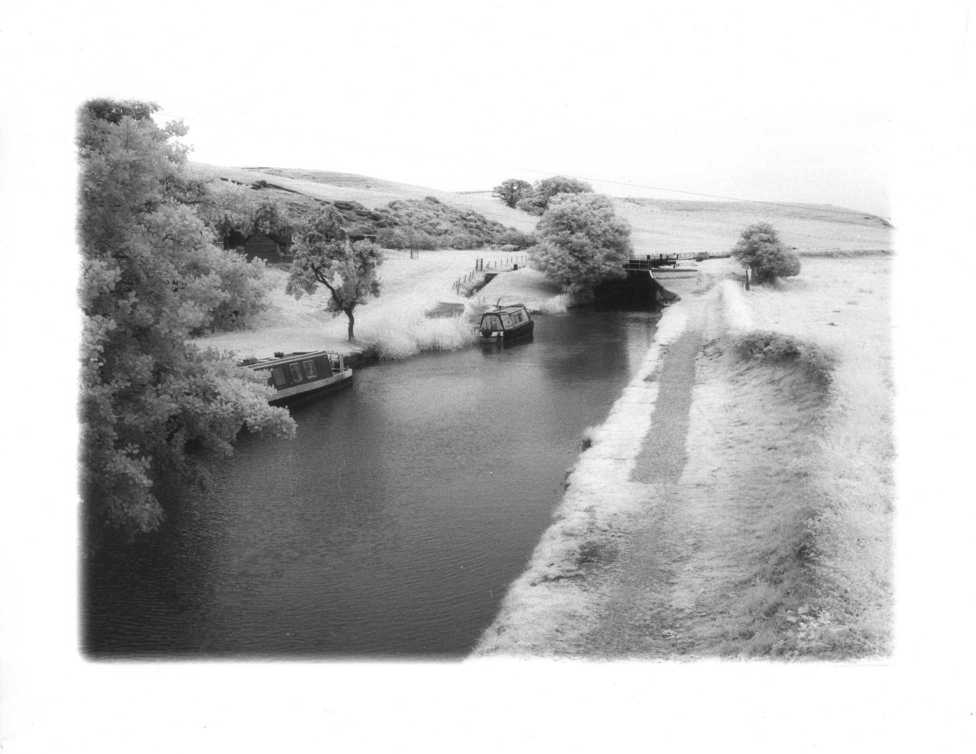
A monochrome infra-red photograph of Beeston from Bridge 107
When we were purchasing our lunch we noticed two of our fellow Lymm Cruising Club members approaching the lock and we decided to walk down to the Iron Lock to greet them. After they had locked through the Iron and Stone Locks they moored next to us and we were told of the adventures they had on the first week of the holiday. I was most envious of their negotiating the Anderton Boat Lift, exploring the River Weaver and cruising down the Manchester Ship Canal to Ellesmere Port. Even though we weren’t able to join them I had my spies looking out for “Phial” but she was not to be seen.
The following day we planned to cruise to Nantwich but we had to leave before the others to visit the sanitary station at Calveley for water tank filling and toilet emptying. The sanitary station in question is one of British Waterways’ latest designs and boasts all the usual facilities in addition to showers and pump-out. A far cry from the old days when all one was provided with was a water tap and, if you were lucky, a sluice to empty the toilet into.
After completing the tasks at the sanitary station, we made our way past Barbridge to Nantwich. I was suffering with cold symptoms and the local chemist was visited in order to obtain medicine. In the meantime I fell asleep whilst our crew members walked around the town. In their absence some of the Lymm Cruising Club members passed us on their way to the Nuclear Bunker Exhibition Centre at Hack Green. We had planned to meet them there the next day but, in the meantime, I took my medicine in the hopes that it would make me feel better.
The next day was the start of the Nantwich Agricultural Show and we were amazed at the cars parked in the adjacent fields. We were not surprised by the numbers but at the fact that visitors were driving ordinary cars onto a sodden, muddy field as it rained quite heavily in the night. There were tractors present and we thought that there services would definitely be called upon when the crowds came to go home.
We soon reached Hack Green and the others were waiting for our arrival so that we could all go into the Secret Nuclear Bunker together. I looked at the locks and remaining stable block with interest to see if anything had been changed and was relieved to discover that it was basically as it was years ago with the exception of benches and picnic tables being placed in what was the lock-keeper’s cottage garden. When we made our way up to the road that lead to the bunker I didn’t expect to see the large, revolving radar scanner that was a landmark for many miles. Apparently, it was dismantled around 1968 and its place taken by a more compact modern array.
We were all impressed by the standard of the exhibits at Hack Green. Ange especially enjoyed the Morse Code transmitter and the interactive telephone exchange. This was the old type where leads were plugged into the appropriate extension. Our visit was over all too soon and we made our way back to the boat and set off for “The Barbridge Inn” which was to be our mooring for the night.
After a most enjoyable meal (at least I think it was as I had no sense of taste due to my cold... nice textures though!) we sat outside with our drinks chatting with the other Lymm CC members for an hour or so before we returned to the boat and Ange and I read whilst the others fished.
The following morning we visited the sanitary station (again) behind the boat shop, emptied our rubbish and joined the armada heading for Cholmondeston Lock. When we reached the lock we were at the end of a queue of about fifteen boats all waiting for the lock. Over an hour later it was our turn to go through the lock and after negotiating it we moored up opposite Venetian Marina Village where we had our breakfast in the cafe before looking around the boat chandlery and Kate’s Canal Shop.
We then set-off again and set course for Minshull Lock. We then joined another queue which was, at one point, twenty seven boats long. Bill Edsbury, Lymm CC’s Commodore, tied his boat to the outside of ours so that he could make himself something to eat whilst we waited for the lock. Whilst we were pulling the boats around a moored boat John fell in whilst pushing both boats off. He fell in backwards and hit his arm on a folded fishing chair that was on the deck as he fell in. Ange and Bill pulled him out of the cut onto our rear deck and it wasn’t until he had showered and changed into dry clothes that the size of the wound became apparent. I cleaned it with an antiseptic wipe and applied a pad and bandage to the wound. If it were a normal cut I would have advised a visit to the hospital for stitches but the skin had been stretched and ripped rather than a clean laceration. So, under the circumstances, cleaning, a bandage and a hot cup of sweet coffee was, in my opinion, the best course of action (John’s wound has since healed completely with no evidence that it ever existed except for a small scar).
I think that John’s pride was hurt more than anything but that didn’t stop strangers coming up to him for the rest of the day and asking if he was alright. If a member of Lymm CC falls in observed they receive a “Mermaid Award” trophy and a cd of songs with water as their theme at the end of the season. As Bill hasn’t had many takers for the award this year he is considering giving John an honorary “Mermaid Award” as he is not a member of the club.
John’s soaking didn’t dampen his ardour and he was soon back to his normal self showing more concern for his straw golfing hat which got a dowsing and the chair that fell overboard never to be seen again.
When Bill’s boat... “Mister Ed” wasn’t tied to ours in the lock queue he had a habit of putting the centre rope onto the towpath and wandering off to talk to people. Great public relations exercise for the club but not for Bill when his boat starts to drift off. On one occasion when Bill was doing his pr bit his boat started to drift off and Ange called him as John and I were both otherwise engaged. Bill came running up just in time to catch his rope before it went into the cut. A mild mannered person that doesn’t normally swear, Bill surprised us when, as he pulled his boat into the bank, he was heard to say “Come on you bar-stard” referring to his boat as he pulled on the rope. I nearly followed in John’s footsteps with laughter on hearing the words that were totally out of Bill’s character.
Whilst waiting at Stanhope Lock I saw a man striding down the towpath with a windlass attached to his specially designed belt. “What length are you”? he asked. “Forty feet” I replied. “Would you have any objection to having a thirty footer come in the lock with you”? “None at all but then I’m not the one who has to brave the scowls and comments from longer boats in the queue”. With that he smiled and said “Not a problem” and disappeared back along the towpath to bring his boat down and tie it to the side of “Total Eclipse”. The narrowboat in question was a Sea Otter aluminium craft called “Tiger Moth”. We were all impressed by the standard of finish on the boat and whilst descending the lock we discussed the merits of the built-in water ballast tanks. The exercise was repeated at Wardle Lock but we then went our separate ways as “Tiger Moth” was going up Heart-break Hill towards the potteries and we were heading towards Preston Brook.
When we started to descend the three Middlewich locks Ange took over the tiller and guided the boat through the locks, taking the ninety degree turn adjacent to the dry-dock in her stride and placing “Total Eclipse” perfectly in the locks without a bump or a scratch. John was working the locks and I was recording the proceedings on video. When we reached Big Lock we seemed to have lost the other boats that had accompanied us and there was no queue. After the locks were negotiated we cruised through the beautiful Cheshire countryside to the “Salt Barge” in the brilliant afternoon sunshine where we moored for the night and visited the pub for a wonderful meal.
The following morning we set off in the direction of Preston Brook. We stopped at the new sanitary station at Anderton to empty the toilet and fill the water tank and passed through all three tunnels without incident before we tied-up at Moore just after the winding hole. We went to the Red Lion to have a drink and book our table for an evening meal then walked to the shop for milk, etc. On our return to the boat the rest of our friends had arrived and we spent an enjoyable afternoon fishing and chatting in the brilliant sunshine.
The next morning was the last day of our holiday and we set-off for Agden. When we arrived we moored the boat, tidied-ip and loaded our things into the car. The holiday was over all too soon and even though the weather wasn’t too generous to us we all had a good time.
Our “Beeston Pilgrimage” was not as long as we would have wished. We would have liked to have cruised down as far as Christleton at least or tied up at Brockholes Aqueduct, sampling the fayre at “The Old Shadey Oak” in the shade of Beeston Castle, on the way. But our friends didn’t stay in Chester as long as we thought and we were surprised when we met our them at Beeston.

The carpet of weed covering the canal at Ellesmere Port not far from the Boat Museum
The parts of the Shroppie that we cruised on hadn’t changed much since I was last on them. Calveley was the only place that showed any change. The canal shop that occupied the site has been replaced with one of British Waterways’ new state of the art sanitary stations and this was a change for the better. We look forward to cruising the remainder of the canal and discovering what impact time has had on Audlem, Market Drayton, Gnosall and Brewood. If the northern part of the canal is anything to go by we should be in for a pleasant surprise. No doubt, when the time comes our adventures will be documented in “Canalscape Book 4”.
Beeston Pilgrimage... Epilogue
I was saddened to hear recently of Caroline and Ken Docherty’s retirement to France. I bought my first boat... “Misty Waters” from Ken in 1983 and his wife, Caroline, has kept our stomachs full with her beautiful meat pies, fruit pies, jams and ice cream from her shop beside Beeston Stone Lock for nearly a quarter of a century. They will be sadly missed. Another member of the North West canal fraternity was lost around this time. Chas Harden’s mother died in April 2005 and she will also be missed. Her “Glory Hole” shop at Beeston was one of my favourites and will not be the same again.
Chapter 6
-
Llangollen Revisited
Lymm Cruising Club’s Annual Holiday Cruise in 2005 was planned to be a cruise up the Llangollen Canal with an excursion down the Montgomery Canal on the way back. Accordingly, the cruise was to be the last two weeks in June... a month earlier than usual to avoid the busy period on the Llangollen Canal and congestion at bridges and waiting at locks.
We had planned our holidays accordingly and even though we were half way through refitting the front cabin in “Total Eclipse” we decided to temporarily place the toilet into the shower compartment and lift it out when we wished to use the shower. Other preparations included filling the fuel tank to the top and cleaning the boat from bow to stern. Needless to say, the weeks leading up to the holiday passed all too quickly and there were jobs that I completed whilst we were away.
Most of the club members had set off on the cruise before us and we planned to catch them up within the first few days. We left our Lymm moorings at 10.00 am on Saturday 18th June 2005 in brilliant summer sunshine. After a brief stop at the clubhouse to top-up the water tank and empty the toilet and a flying visit to Thorn Marine to pass in promotional material for “The Big Ditch”, we cruised towards Preston Brook where we caught the 2.30 pm tunnel passage. We made a brief stop at Black Prince of Acton Bridge to obtain our British Waterways licence as, under a reciprocal agreement with BW our Bridgewater Canal licence only covers us as far as Barbridge Junction.
After this brief pause we carried on and ate our lunch “on the cruise” as we passed along the lovely River Weaver Valley or, as it is also known... Vale Royal. Saltersford and Barnton Tunnels were negotiated without drama, we sailed past the Anderton Boat Lift and we eventually moored in Croxton Flash on the outskirts of Middlewich. We watched the numerous swallows, cormorants, herons, grebes and other wild birds that frequent this idyllic location and even spotted a grass snake swimming across the flash just before we were treated to a beautiful sunset... a fitting ending to a wonderful summer’s day cruising.
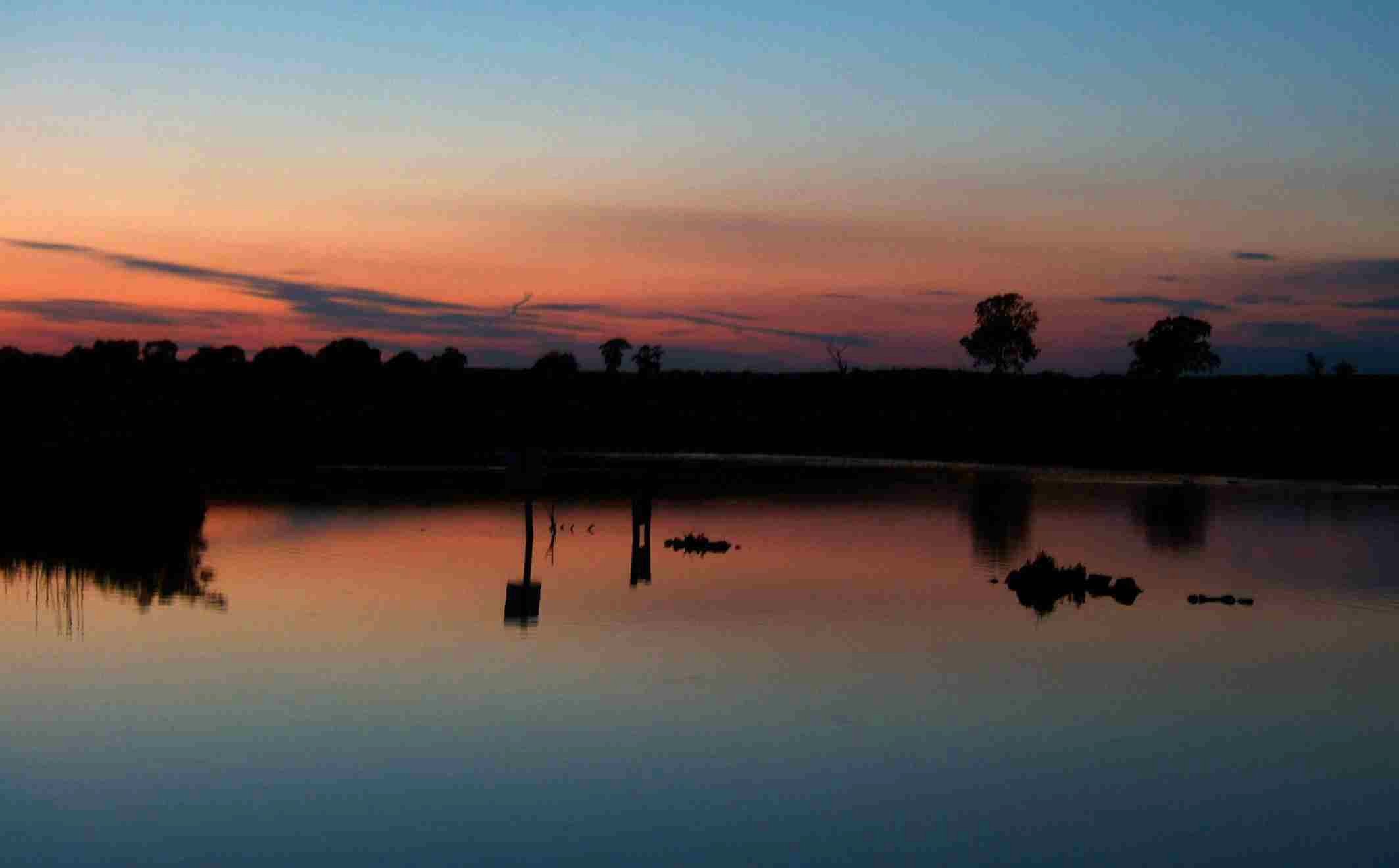
Sunset at Croxton Flash on the Trent and Mersey Canal
The following morning we were up bright and early as I had a couple of jobs to do before we set off. Once we were under way Croxton Aqueduct was soon crossed and we were approaching Big Lock. It was the weekend of the Middlewich Festival and there were quite a few boats moored. Ange and I took turns steering the boat through the locks and when we came out of the second lock, Ange had to pass the butty “Gifford” being bow-hauled from the Boat Museum for charity. Ange took this manoeuvre in her stride and I don’t think that I could have handled the boat any better myself. Around the corner before Wardle Lock we joined a queue waiting to join the Shroppie’s Middlewich Branch. When we eventually entered the lock we were serenaded by a group of lock-side musicians as we said hello to Maureen... the unofficial guardian of the lock.
The stretch of canal above the lock is notoriously shallow and we traversed this stretch virtually on tick-over whilst we ate our lunch. The weather was hot and sunny and we were soon cruising beneath the main Crewe railway line (where we saw a “Pendolino” just after passing through the bridge) and past hundreds of cows ruminating in the fields that line the canal. Ange “mooed” at the cows and was doubled over with laughter at the expressions on their faces. As we approached the straight stretch of canal once used in an experiment where railway tracks were laid along the towpath for small locomotives to tow narrowboats it started to cloud over. We joined a queue for Cholmondeston Lock opposite Venetian Marina and the heavens opened. Large spots of rain heralded the approach of a thunderstorm and we sheltered inside the boat until the storm subsided.
The craft in front of us passed through the lock and by the time it was our turn the storm had passed and the surrounding countryside was steaming as the rainwater evaporated on the hot ground. When the paddles were opened emptying the lock for us to enter, our centre rope broke. I wasn’t too surprised at this as the rope was quite old and started to thin out in places. It had passed four o’ clock and the chandlery opposite had closed for the day so I tied a reef knot in the rope until a replacement could be bought.
The rain abated as it was our turn to enter the lock and by the time we had passed through the lock the rain had stopped completely. We joined the Shroppie’s main line and moored for the night opposite the Barbridge Inn where a few of our fellow Lymm CC members had moored. Not long after we had our tea a collection of ex-working boats moored next to us lead by none other than “Starling”. As mentioned in “Canalscape - Book 1, Chapter Seven - Beeston Days”... this was the first narrowboat that I ever steered back in 1966 when it was only 35 feet in length.
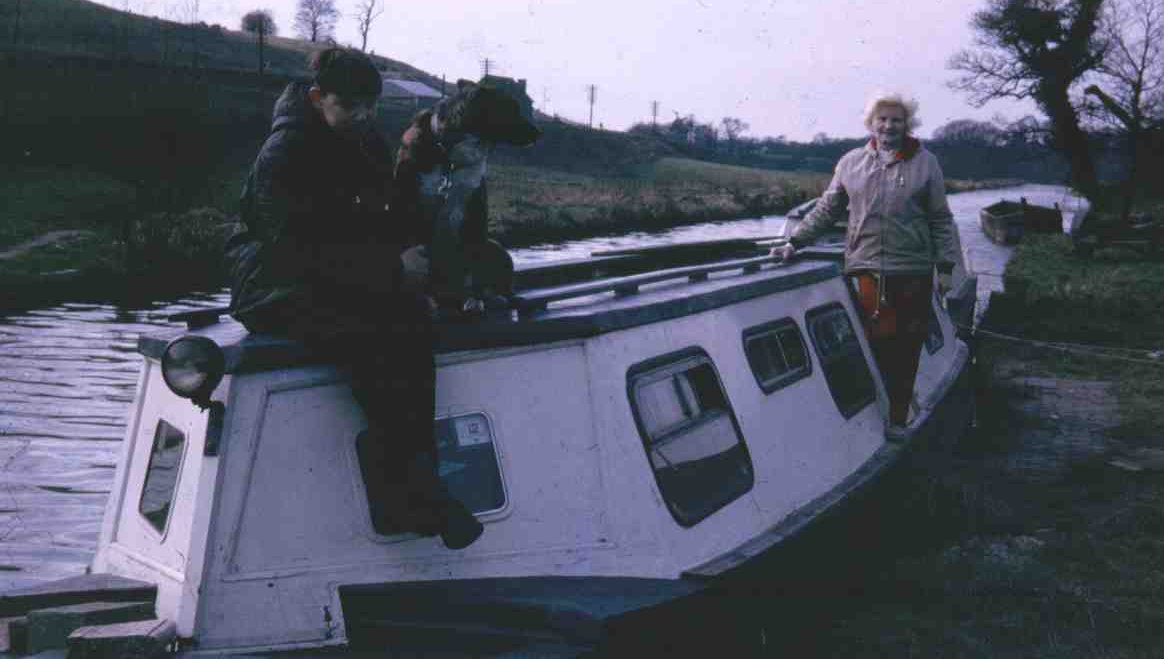
Mother, Jack and myself on board "Starling" at Beeston in March 1966
David Jones... the present owner wanted to reinstate the boat to its original length but the original centre section... "Swan", later known as "Jacqueline-Yvonne" was not available so the reversion to the original length was accomplished by using the knees of an old wooden boat and new steel plates to form the remainder of the hull. The BMC “Commander” engine that was fitted when I first steered it in 1966 had previously been replaced with a Seffle semi-diesel and in turn this was replaced with a big Lister HA2.
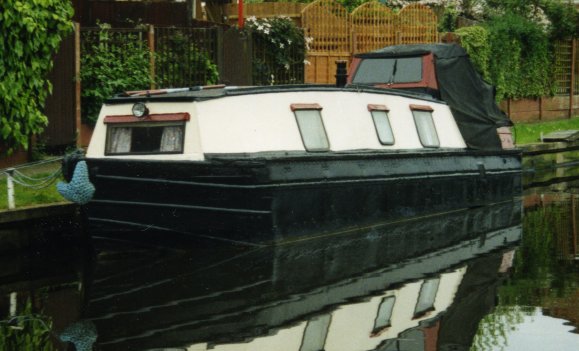
"Jacqueline-Yvonne" ex-"Swan" - "Starling's" centre section moored at Lymm in 2002
The boatman’s cabin was rebuilt as was the engine room before painting it in the original Coburn and Cowpar colour scheme. The result of his labours is a boat that, if you didn’t know its history, you wouldn’t guess that it was once only half its present length as it now looks as good as the day it was launched. "Starling" features as Historic Boat of the Month in the October 2008 edition of "Waterways World".
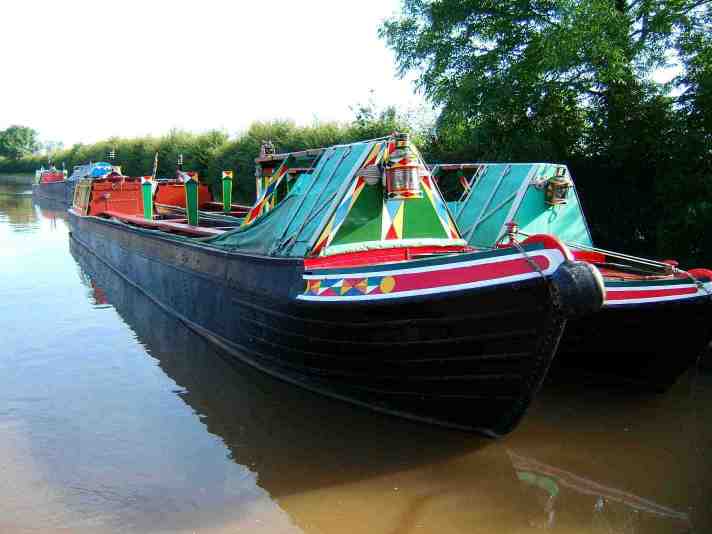
"Starling" at Barbridge... I was hard-pushed to spot the joins!
We later joined some of our fellow Lymm Cruising Club members for a drink in the Barbridge Inn and discussed the delights that were in store for us during the next two weeks.
The following morning we cast off and made for Hurleston Junction and the start of the Llangollen Canal. On mooring in the entrance basin I lifted the fenders whilst Ange set the first lock. Some of the lower gate paddles are hydraulic and Ange commented on their stiffness. This prompted me to remember when the hydraulic paddles were being tested in the early 1960's. Each set of bottom gates had a different type of mechanism painted a different colour and a questionnaire had to be completed when reaching the top of the flight for British Waterways to ascertain which design was preferred by boaters. Then as now we prefer the conventional rack and pinion design as they are easier to operate and can be dropped quickly in an emergency.
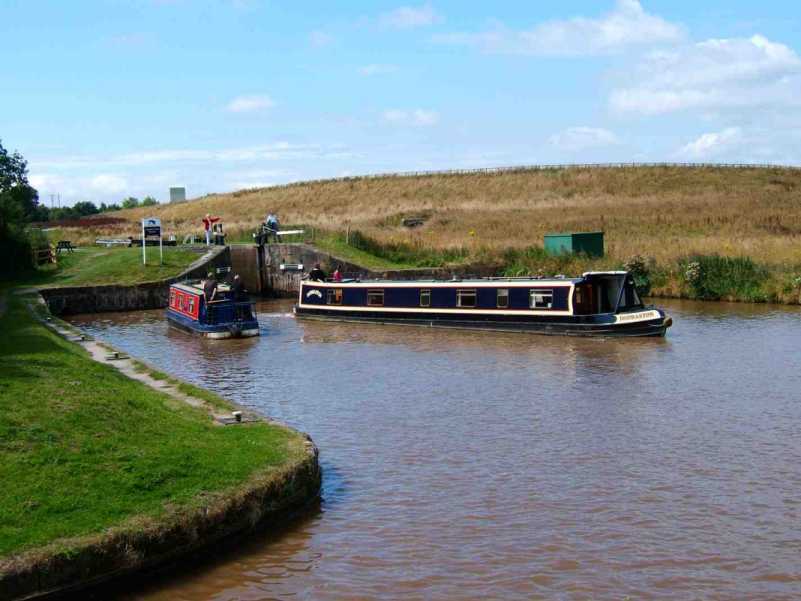
Hurleston Junction and the notorious Bottom Lock
("Lift the fenders Ange!")
As we ascended the flight we were joined by the lock keeper who checked our licence as he chatted to us. At the top lock three canine noses protruded beneath the gate to the lock keeper’s cottage garden. They belonged to three Springer Spaniels who greeted us with great enthusiasm when we looked over the gate. After bidding farewell to our three new canine friends and the lock keeper we dropped the fenders and headed up the canal in the brilliant sunshine.
The Llangollen Canal is notorious for its by-pass weirs which catch-out the unwary. I had suggested to Ange that, when approaching a lock with the by-pass weirs running that she pointed the bow of the boat towards the weir and rely on the power of the water to realign the boat towards the lock chamber. Nine times out of ten this ploy worked but it is reliant on the amount of water running down them. We negotiated the two locks at Swanley and the three locks at Baddiley without incident and hardly touched the sides of the lock when entering the chamber using this technique.
We had previously bought a painted planter containing flowers from a man who lived on a narrowboat above Baddiley number three lock. When we passed he was not in residence but planned to stop on the return journey. In the meantime we passed more fields of Friesian cattle. Needless to say, Ange had a good “moo” at them.
On reaching the first lift bridge – bridge 19, much to Ange’s relief, we didn’t have to stop to lift it as the platform had been removed. This was one of the last remaining bridges where one had to swing on a chain to lift it and we assumed that it would be refurbished with hydraulic lifting gear.
A little way along the canal is bridge 20 – Wrenbury Bridge. This bridge is electrically operated and Nigel Foster... one of Lymm CC’s members lifted it for us as well as informing us that there was a mooring just around the corner that we should be able to squeeze into (which we did). That evening we joined our fellow club members in the Cotton Arms for a beautiful meal. The manager/chef was most accommodating, sitting us all together and even made room for late comers. We left at about 10.30 pm but the following day we were informed by Nigel that they were invited for a stay-behind and didn’t return to their boats until much, much later.
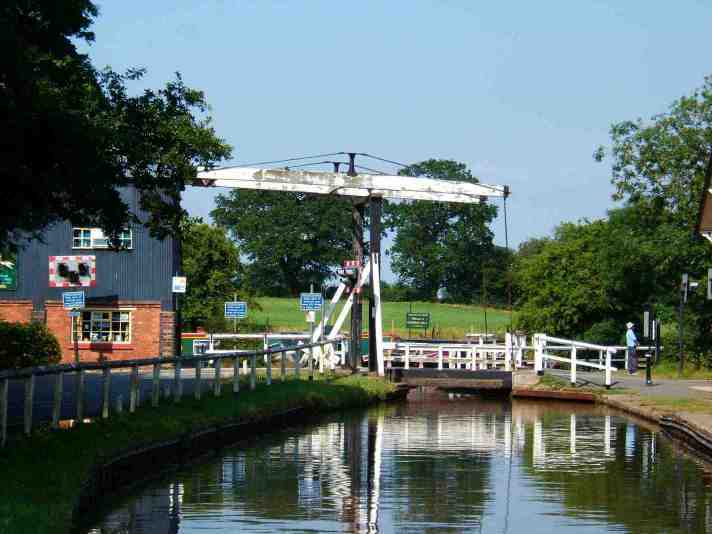
The electrically operated lift bridge at Wrenbury (Bridge 20)
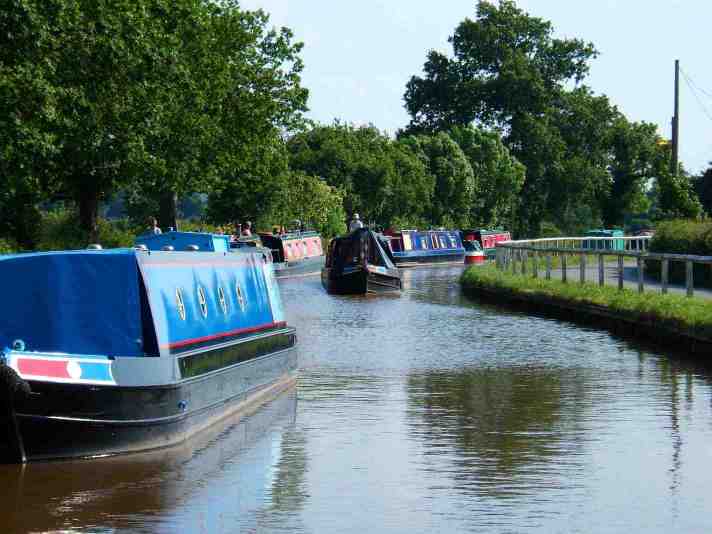
Looking from the lift bridge at Wrenbury towards Marbury
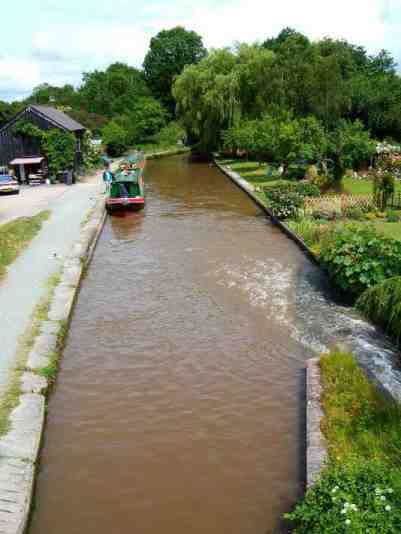
"Total Eclipse" waiting in the queue below Grindley Brook Locks
We woke up the next morning to more brilliant sunshine and discovered that some of the club members had already left so we had our breakfast and followed in their footsteps. After rising in Marbury lock we entered a beautifully isolated section before passing beneath the A49 and reaching Quoisley Lock. Willeymoor and Povey’s Locks followed and we were soon in a queue for Grindley Brook Locks.

Grindley Brook Bottom Lock
Ange took the boat through the three-step staircase lock and I thought that she would be intimidated by the size of the chambers but she took them in her stride to the amazement of the lock keeper. At the top I shouted hello to Tom Merral before we stopped to fill the water tank, empty the toilet and rubbish before carrying on.
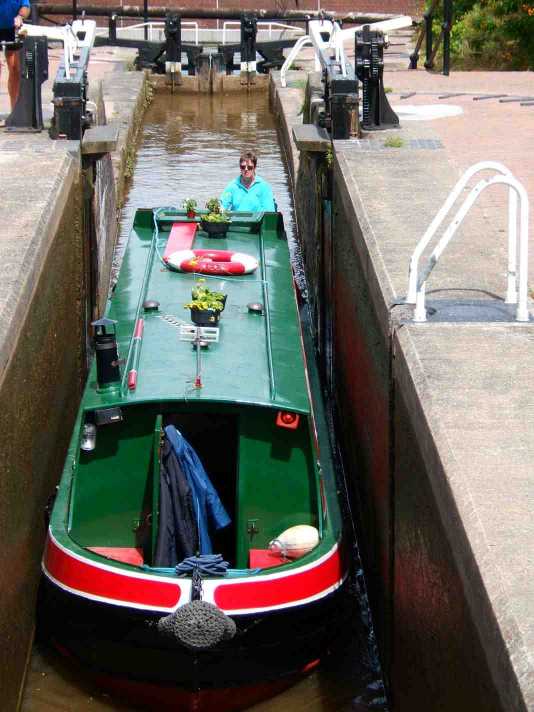
Ange expertly negotiating the three-step staircase lock at Grindley Brook
We thought that some of our club members would have gone into Whichurch so we negotiated the tight turn into the Whichurch Arm and cruised up to the moorings only to find them empty. We turned in the winding hole and returned to the main line, meeting a long hire boat at the junction. We reversed backwards to allow the boat to enter the arm but even then they only just made it around the corner. We noticed that when entering the arm from Grindley Brook, craft over 40ft have to cruise up to the winding hole a little way upstream and enter the arm from the other direction.
We cruised above Whichurch in the late afternoon sunshine, operating two lift bridges until we met a narrowboat that had been driven aground by a hire boat travelling too fast for such a shallow canal. The steerer’s hat had blown off in the excitement of the moment and we retrieved it, passing it to the owner and offering to pull them off the shallows. Ange caught their stern rope and gave it a couple of turns around one of our stern cleats. I engaged gear and slowly pulled them back into the centre of the canal, enabling them to continue once they had retrieved their rope.
We next arrived at the site of the breach earlier this year and were amazed at the way that nature had reclaimed the banks in such a short period of time. As well as the usual bank-side plants, Field Poppies were growing in great numbers all along the new piling. Yet again, British Waterways had done a good job that we thought the badgers reputably responsible for the breach would find impossible to burrow through again.
It wasn’t too long before we saw the collection of boats from Lymm CC moored, virtually in the middle of nowhere. The folding chairs, tables and barbequeues were out in force as our fellow members prepared their teas in the early evening sunshine. We had a cold tea and joined our friends, talking about the holiday and I walked along the towpath to take photographs of the location. On my return a group of members dressed as druids invaded our end of the moorings... well it was the Summer Solstice! Later on, when returning to our boat, Ange missed the side of the boat and put her foot in the canal. Tony Whalley (the Club Commodore) and myself pulled her upright with only pride being hurt.

Moored in the middle of nowhere on the 2005 Summer Solstice
The next morning offered yet more sunshine and we cast off following “Don Ross” being steered by Nigel and Lisa Foster with whom we took turns in operating the lift bridges. The Shropshire countryside is briefly punctuated by an arm of Wales and the canal flows from Shropshire to Clwyd just before Whixall and back into Shropshire again just after the junction with the Prees Branch. When we arrived at Whixall, where the canal passes through the Whixall Moss nature reserve on a long straight stretch, we were attacked by numerous horse flies which actually drew blood on exposed skin. We usually enjoy loitering through this stretch but, under the circumstances (ie; being eaten alive) we were glad to leave Whixall behind.
We were now approaching Ellesmere and as we passed through the wooded section that skirted the meres we were treated to the sight of a Kingfisher darting along the off-side bank of the canal. Its electric blue plumage stood out and seeing it was one of the ornithological highlights of the holiday. Unfortunately, due to its speed I was not able to photograph it.
We welcomed the shade offered by the trees lining the stretch of canal that skirts around Blake and Cole Meres. The coolness of Ellesmere Tunnel was equally welcomed and we were soon out in the open, blistering sunshine again as we moored at the start of the Ellesmere Arm of the canal.
We wasted no time mooring and locking-up the boat before we walked down the arm into Ellesmere itself. We walked up the main street and saw in a shop window an architect's plan for the redevelopment for the old dairy at the end of the canal arm. Once again property developers are realising the value of canalside properties. Their commitment to developments of this kind will only enhance the canalside environment. In this case, removing the eyesore of a dilapidated, derelict dairy and developing it into an up-market housing development. After buying essentials from the shops we checked out the local hostelry and booked a table for the evening before returning to the boat. We put our shopping away and had forty winks before readying ourselves for the evening meal which was, needless to say, superb as was the company.
The following day dawned with blue skies and, when the sun rose, it was as hot as the previous day. After breakfast we reversed out of the arm and continued our cruise towards Llangollen. A little way along the canal we came to Welsh Frankton where the Montgomery Canal descends on its way south. We looked wistfully at the entrance locks but, they would have to wait until our return journey.
We were soon at Maestermyn Marine and we pulled in to buy a new length of rope after our centre rope broke at Cholmondeston. Whilst in the boat chandlery I asked about omni-directional tv aerials but they only had one that was incomplete. It was minus cables, plugs, brackets and hardware but the important bits such as the antenna itself and the signal booster/splitter were present. As well as receiving tv signals it doubled as an fm radio antenna as well. The cable fittings seemed to be the screw-in type as used on satellite and cable tv decoders and the underside of the antenna seemed to have the same mounting as a conventional aerial. I noted these points and filed them away in my mind for future reference. We bought the July edition of “Waterways World” which was accompanied by a catalogue for boat hardware including omni-directional aerials Illustrated was the same unit that was mentioned above and they were being sold for £80 complete. If time allowed we might call back at Maestermyn Marine on our return journey and make an offer for the incomplete unit

In the queue for Newmarton Locks on a hot summer's afternoon
Under way
again we soon joined the queue for New Marton Locks. There were quite a few boats in front of us and we had to wait over an hour before it was our turn to enter the lock. The boat waiting to come down the lock was crewed by young men (I will not call them gentlemen) who were quite willing to allow everybody else to operate the lock for them. The crew of the boat behind us were inexperienced boaters and Ange had given the female member of the crew some pointers in lock operation. She seemed daunted at having to operate a lock on her own for the boat coming down and she was told to walk back to her boat and let the able-bodied men on the boat coming down prepare the lock for her. As we cruised past I couldn’t resist a comment on their letting women do all the work for them. The empty lager cans littered all over their boat and their general attitude summed up the situation... best left well alone!
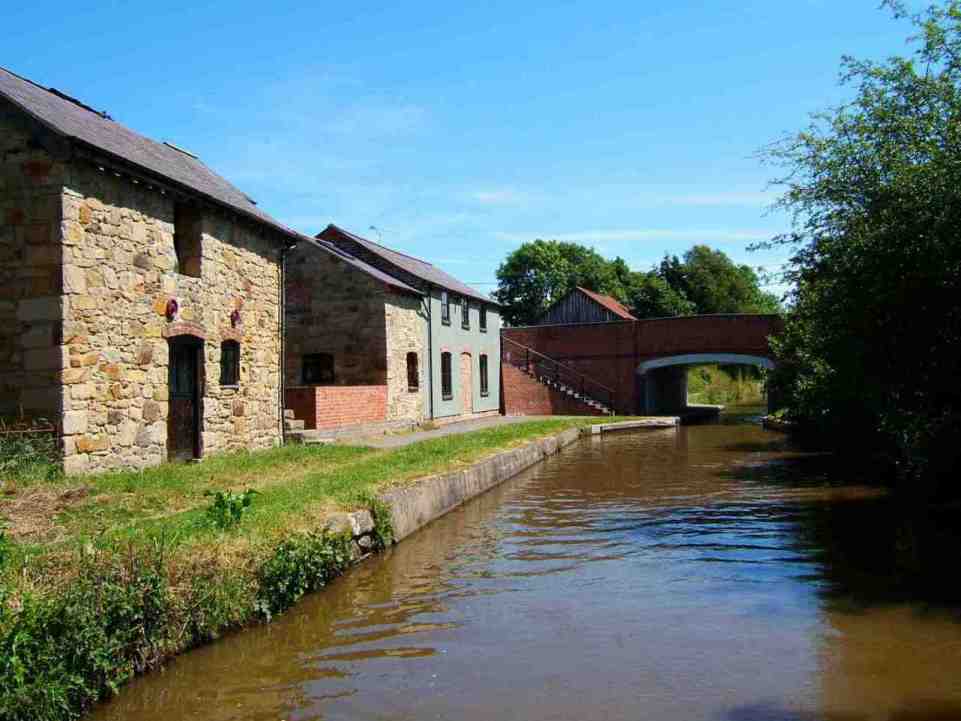
St Martins... Once the location of Usher's Stores
Above New Marton Locks is the village of St Martins. Just past the recently rebuilt bridge are cottages that were once Usher's Stores and Bakery. It was here in my youth that we used to stop for freshly baked bread and rolls (the aroma of which can only be imagined), milk and other food items as well as buying ice creams to cool us down on hot summer days. Alas, the shop is no more and we will have to wait until reaching Llangollen before we stock-up the cupboards and fridge.
As we cruised across St Martin’s Moor we could see the Welsh hills in the distance and it was hard to believe that we would be soon cruising through them on the level as a route through them was not visible. However, it wasn’t too long before we were approaching Chirk Bank and the canal clung to the sides of the River Ceriog Valley on its way to the first of the mighty aqueducts... Chirk Aqueduct. We were following a hire boat and I did not think that they were going to reach the aqueduct let alone manage to cross it. Their progress was painfully slow and I am glad that they didn’t meet another boat as it seemed that they didn’t have the navigation skills to pass on this narrow concrete section.
We eventually reached the aqueduct and hung back to allow the hire boat in front time to creep across. When they were about three quarters of the way across we started to cross. The views up the valley are marred by the adjacent railway viaduct but the glimpses obtained through the arches were tantalising as we crossed into Wales for the second time. The boat in front stopped at the far end of the aqueduct as the basin was full of craft waiting to enter the tunnel. A British Waterways man walked beside us on his way to check the tunnel and we chatted to him, offering him a cold drink. He accepted our offer and then hurried off to see what the problem was ahead.
After fifteen minutes or so a narrowboat emerged from the tunnel. The steerer was apologising to everyone waiting, explained that his headlight had failed and had to use a torch to see his way through. The boats waiting in the basin started to enter the tunnel but by this time another boat had entered at the other end. When this boat emerged the tunnel was clear and the boats in front started to enter allowing us to come off the aqueduct. It was a bit like a Chinese puzzle with the boats shuffling around the basin but we soon entered the tunnel behind the hire boat that crawled across the aqueduct. Their speed (or rather... lack of it) was duplicated in the tunnel and what made matters worse was the fact that there were children on the roof of the boat and others dangling their feet into the water as they went through. We met the British Waterways man about a third of the way through and informed him of the dangerous behaviour on the boat ahead. He turned around and caught them up to tell them off for not obeying the safety notices at each end of the tunnel. Twenty minutes later we emerged from the other end of the tunnel and decided to tie up for lunch, giving the crawler a chance to get a good distance ahead.
After lunch we carried on towards Pontcysyllte and we braced ourselves for the white knuckle ride of the canal system. The crossing of Ponty was as wonderful as ever and without drama. Our cruise itinery was to cruise as far Trevor so, at the far end of the aqueduct we cruised past the hire cruiser base and beneath Scotch Hall Bridge into the short Ruabon Arm hoping to see some of our fellow club members. None of the boats moored there were familiar so we turned around, retraced our steps. A hireboat was making heavy weather of the right turn onto the “Water Line” to Llangollen much to the amusement of gongoozlers sitting on the canal bank. When it was our turn to negotiate this manoeuvre we made the turn perfectly without having to resort to the dramatic use of engine and tiller of the previous boat. We were congratulated by the observers who commented that “that is the way it should be done” and I thanked them for their kind comments as we passed under the bridge.
I feel that a word of explanation is required regarding the word "gongoozler". A gongoozler is a person that stands by locks, bridges and other places along the canals watching boats negotiating the various canal features. The gongoozler will be delighted if the boater makes a fool of themselves whilst negotiating the various obstacles (like being "caught by the wind" Nigel). The term originates from Lincolnshire in the 19th Century and means to stare or gape... and is quite appropriate I think.

The view from the tiller whilst crossing "Ponty"
All along the Water Line we were following the hireboat which was a blessing in disguise really as it was they who met other craft on the blind bends or in the narrow sections and not us. They were resourceful as the crew member walking ahead on the towpath used mobile telephones to communicate with the boat to warn of approaching craft.

The beautiful scenery on the "Waterline" below Llangollen
We pulled in at the approach to Llangollen Marina to pay for and collect our “pay and display” mooring ticket (£10 for 48 hours - excellent value) for the new marina. We also took the opportunity to empty the toilet and rubbish bin before cruising up to the limit of navigation for narrowboats and turned into the marina. As there was plenty of space I executed a perfect 180º turn and reversed onto one of the mooring piers (much to the delight of fellow Lymm Cruising Club members who were watching with critical eyes).
Our first impression of the new marina was “why hadn’t facilities like this been built before”? At the end of the pier was a unit that contained the 240 volt electrical shoreline supply unit as well as a water tap. We connected the shoreline and decided to leave filling the water tank until the following day. Once the scars of construction have healed the area will blend into the surrounding countryside completing the overall visual impression of the marina. As we were coming into Llangollen we noticed clouds creeping up on the horizon. Not long after mooring it started to rain which was accompanied by a thunderstorm.
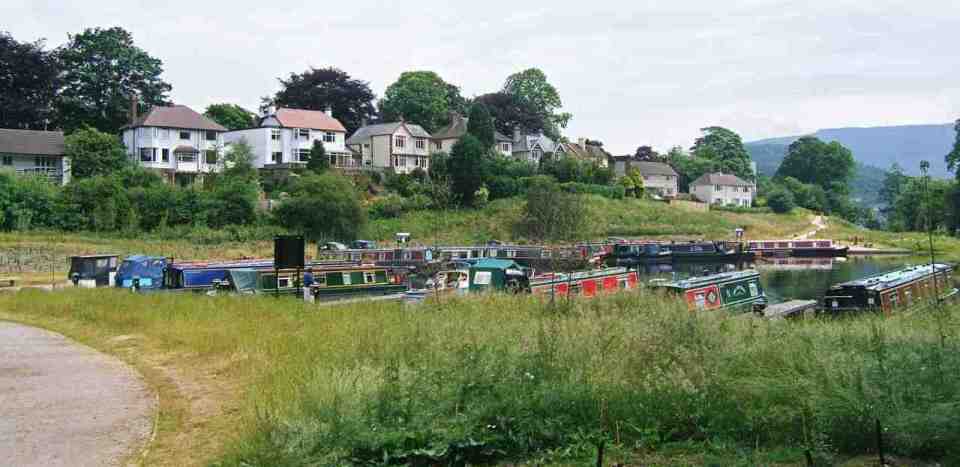
Llangollen Marina on a less than perfect day weather-wise
The following day we went into the town for shopping and we had a visit from my brother Jim and his wife plus their dog Timmy. It was the first time that they had seen the new marina and they were as impressed with the facilities as we were and spent a very pleasant day with us. That evening we had arranged to go to the “Corn Mill” for a meal with some of the Lymm CC members. It was the first time that we had been in this establishment and we were all amazed at the old mill machinery that had been retained as an interior decor feature. As well as this the quality of the food could not be faulted even though Ange's food came laden with tomatoes to which she is allergic to (even though she ordered it without tomatoes) and had to send back for a replacement.
Bonny and Mike Goldberg from NB "Californian" are our resident "Yanks" who spend their winters at home in Longbeach, California (hence the name of their narrowboat) and the summers cruising the British canals on their boat. They had instructed us not to order a sweet after our meal as we were all invited back to “Californian” for supper. Bonny and Mike laid on a sumptuous selection of brownies, cookies (to use the trans-Atlantic vernacular) and other sweets cooked on board that afternoon. Fortunately, “Californian’s” lounge is big enough to hold quite a few people in comfort even if Mike was worrying about water entering his front deck through the "scuppers" with the increased "ballast".

A few of us sampling brownies on board NB "Californian
(Photograph - Mike and Bonny Goldberg)
We decided to leave the following morning and try to negotiate the narrows of the “Water Line” before the hire boats started to come up. We were followed by the narrowboat “Thomas Telford” carrying a boat load of passengers on a trip from Llangollen to the Pontcysyllte Aqueduct. I was conscious of the fact that we could stop more quickly than it could and tried to give clear indications of approaching craft on blind bends etc so help prevent being “rear-ended” by it. My efforts were successful but I do not know if they were appreciated by the steerer or not!
When we arrived at “Ponty” we had a clear run across but what I found most disconcerting was that I was suffering (unusually) from slight vertigo whilst crossing. On our outwards crossing I was on the “drop” side... looking straight over the edge from our steering position and did not have a problem. On the return journey however, I found myself leaning towards the towpath even though I was on the towpath side. Ange got off the boat to take photographs and I felt as though I was going to be catapulted over the side as she got off. Maybe it was because I could only see the gunwales of the boat and not the side of the cast iron trough whereas before I could see them both.
We cruised all day, negotiating Chirk Tunnel and Aqueduct without incident. Coming through Chirk Bank we passed a beautifully restored Holt Abbot cruiser but, unfortunately I could not take a good photograph of it. Whilst crossing St Martin’s Moor we came across two other boats from Lymm CC... “Saphire” owned by Tony and Linda Whalley (Tony is this year’s Commodore) and “Philbarmar” owned by Barry and Phyllis Greenough (Barry was last year’s Commodore). They invited us to pull in and moor up with them for the night, which we did. Not long afterwards, Nigel and Lisa on "Don Ross" arrived and they joined us as well. This was a convenient mooring as we were due to lock down onto the Montgomery Canal the next afternoon at 2 o’clock (when the lock keeper comes on duty). This left us with Newmarton Locks and a leisurely cruise to Welsh Frankton Junction in the morning.
The next morning heralded another bright sunny day. Not long after we set off we found ourselves in a queue for Newmarton Locks but not for as long as when we were coming up. We decided not to stop at Maestermyn Marine to enquire about the omni-directional tv aerial as we were conscious of the time we had to be at Welsh Frankton for and continued on to the junction where we joined the queue for the locks. Whilst we were waiting I took photographs of the restored canal locks and my mind went back to the 1960’s when I remembered sitting on the disused lock gates of the staircase lock with my father. He would have been well impressed with the work that had been completed here and, in going down this canal, we accomplished one of the things that he would have loved to have done.
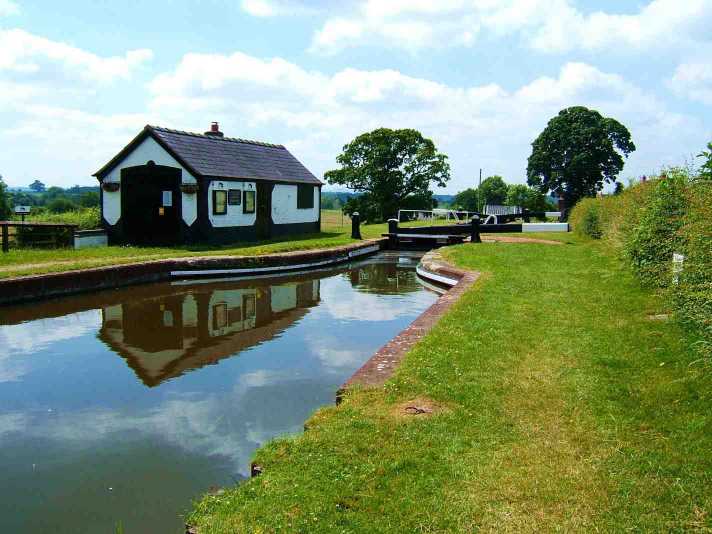
The top of the staircase locks at Welsh Frankton
We had our lunch whilst we waited for 2 o’clock and during this period more boats joined us waiting to pass through the locks. By the time the lock keeper called the first boat through there were about ten boats waiting. We were a little confused as to why the lock keeper ushered boats through the locks but when it was our turn I could see why. The top chamber of the staircase lock had less of a drop than the bottom chamber. Therefore, when emptying the top chamber, the amount of water had to be “topped up” to allow clearance of the cill. This was accomplished by opening the top ground paddles for a few minutes so increasing the amount of water available to equalise the levels and give sufficient clearance above the cill.
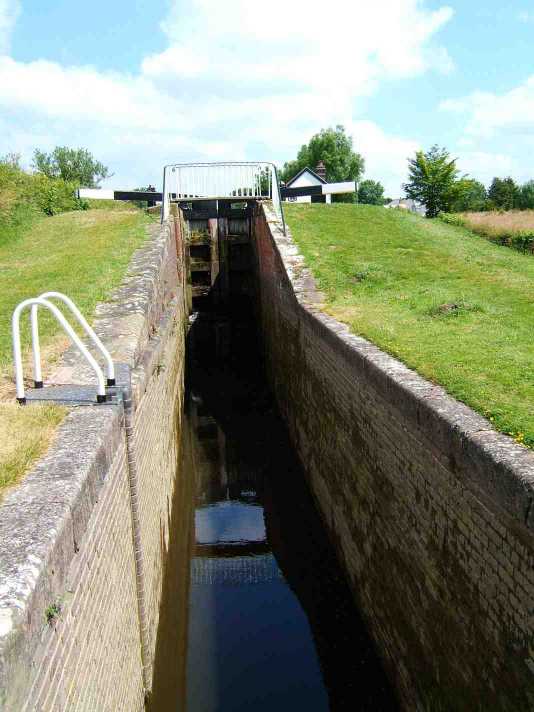
The staircase lock at Welsh Frankton on the Montgomery Canal
Ange steered the boat through the locks and the lock keeper was impressed by her handling of the boat. After the staircase we negotiated the two lower locks and passed the site of the dry-dock where L T C Rolt’s “Cressy” was was converted from a horse boat to a motor-driven narrowboat. The stocks of the dry-dock can still be seen but now they are a feature of the well kept garden which includes an outside model railway that now occupies the location. We then commenced cruising a stretch of canal that I had only walked prior to restoration.

| Looking from the bottom of Welsh Frankton Locks |
| towards what will become Graham Palmer Lock in 1991 |

The Junction Bridge at Welsh Frankton during restoration in 1991
A little way down is a junction where the Weston Arm left the main line. This arm now terminates a hundred metres along its original route where there is a sanitary station and rubbish disposal point. The remainder of the arm is now a linear nature reserve. A sharp right hand bend beneath the junction bridge was negotiated and we were soon at Graham Palmer Lock, named after the chairman of the Waterways Recovery Group. We were not impressed by the way that the stone plaque containing an image of the now deceased Graham (complete with woolly hat) had been defaced. This just demonstrates that even in the relative isolation of this canal, vandals have been present.
The lock has a drop of about two feet. This may seem not worth while until one considers that the whole level of the next pound had to be lowered to allow navigable headroom further along the canal at the rebuilt A5 bridge at the Queen’s Head public house near Aston Locks.
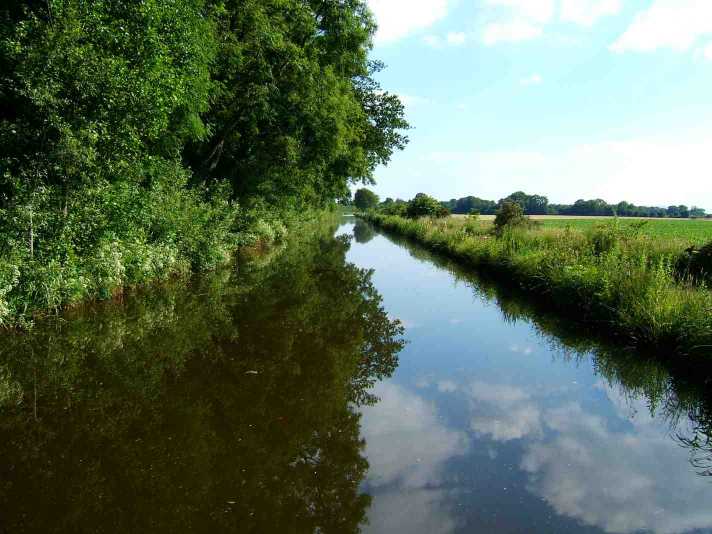
The beautiful Montgomery Canal below Perry Aqueduct
After Graham Palmer Lock we crossed the River Perry on a new aqueduct. The original structure partially collapsed in 1934 and it was this that lead to the canal being abandoned in 1944. A long straight stretch followed which was punctuated by a winding hole half-way along and the site of a removed swing bridge at the end of it. We cruised in the brilliant summer sunshine marvelling at the hard work and determination by both volunteers and British Waterways personnel that must have gone into restoring this beautiful stretch of canal.
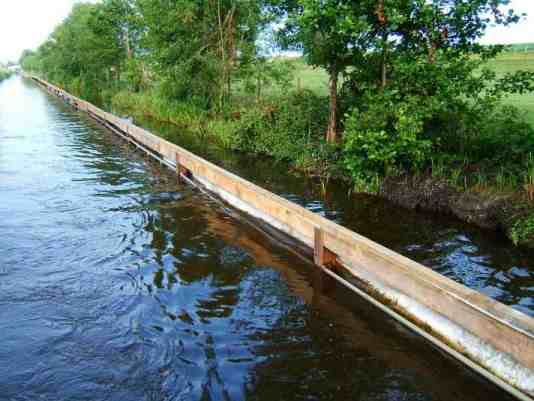
Linear SSSI (inside the partition) on the Montgomery Canal between Rednal and Queens Head
The site of Rednal Bone Factory Wharf (located by a swing bridge guarding the entrance to the arm and now a nature reserve) gave us a problem. It wasn’t marked on our map and the canal straight on didn’t look as though it was the correct route. In the end we decided to carry on straight ahead and suffer the consequences. After a right hand bend is a railway bridge and narrows at the village of Rednal which confirmed that we had made the correct decision. This was once a canal interchange where railway passengers left the railway to embark onto canal packet boats to complete their journey and visa versa.

The former canal/railway interchange at Rednal
The canal is now lined by tall reeds and areas of the bank are separated from the main channel by canvas partitions to protect the rare wildlife that lines the canal here. Soon we reached the Queen’s Head and the limit of our journey along the Montgomery Canal. Beyond the A5 and new road bridges lies Aston Locks and a further navigable stretch of canal. We would have liked to cruise down to the limit of navigation but if we did so we most probably would not have had a mooring here.
We spent the evening in the Queen’s Head were we enjoyed a sumptuous meal. We decided to turn the boat around before it went too dark ready for an early start in the morning. I reversed into the winding hole and picked up silt in the cooling system’s mud box. After the mud box emptied and our cooling water returned I reversed the boat past the moored boats into our original mooring (who says that a narrowboat won’t go backwards in a straight line?). Nigel tried to do the same with “Don Ross” but had to make some corrections to his course in reverse to allow for “prop thrash” which prevents most boats from reversing in a straight line. Afterwards we had a cup of coffee with Nigel and Lisa when they told us that they could not believe how we reversed in a straight line. I promised to live Nigel some tips but they would not be a substitute for our having a keel. When the coffees were finished we returned to "Total Eclipse" and retired for the night.
The following morning dawned bright and sunny and we set off early to try and beat the queue for the locks at Welsh Frankton. We retraced our steps to Welsh Frankton and even though we had left early there was a queue at the bottom lock and we were fourth in line to ascend. Unfortunately there is only space for two boats to wait and as the canal is quite shallow we were only able to reach about a metre from the bank. We threw the centre rope to Tony Whalley who tied us to a tree. In order for us to reach the towpath the gangplank was put out. This was the first time that we had used it. We shared the gangplank with the next boat in the queue... “Don Ross” as Nigel was not able to get back onto the boat when moving up the queue. Soon we were able to stow the plank back on its place on the roof as we moved up onto a deeper section of canal adjacent to the lock. The trip up the locks was uneventful and as we emerged from the top lock we commented on the beauty of this wonderful canal, we vowed to return in the not too distant future and (hopefully) do the “Full Monty” all the way to Newtown.
We met up with Nigel and Lisa at Ellesmere and we all went shopping together. In one of the shop windows we learnt of plans to redevelop the basin at Ellesmere. An artist's impression (see below) of how the basin will look after the redevelopment was also on display. It will be interesting to see how the heritage aspect of the surroundings will be merged into the development. I do not think that many people (including myself) will now mourn the loss of the old United Dairies site as it is an eyesore and provided that the new buildings do not "hem in" the basin they can only be an asset to the area.
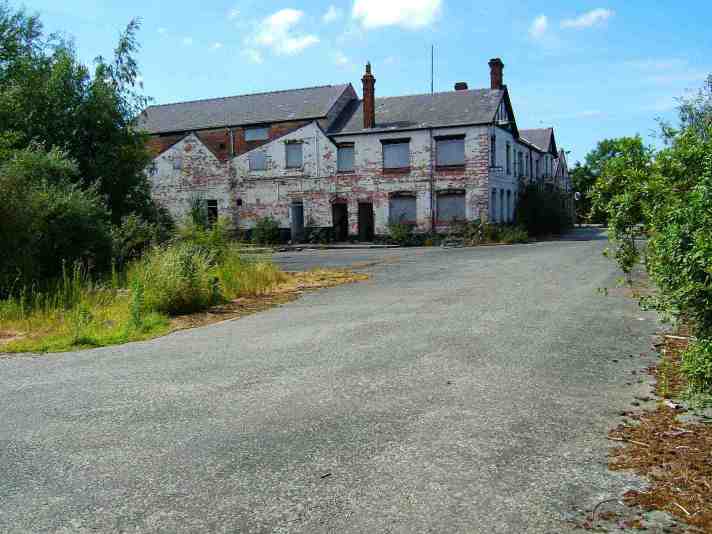
The disused dairy at Ellesmere... Site of the proposed development below
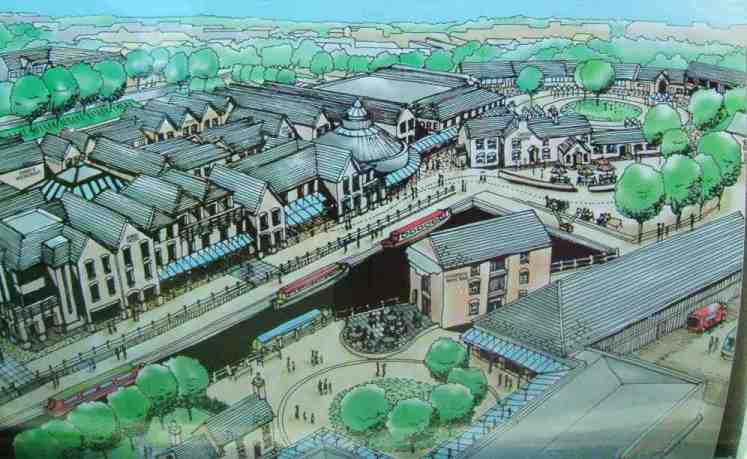
An artist's impression of the redeveloped Ellesmere Basin
On our return from the shops we decided to follow the other club members who were trying to make Grindley Brook for the night. The weather was extremely hot and we were again glad of the shade offered by the tree lined stretch between Ellesmere and Lyneal. When we arrived at Whixhall we were extra vigilant with regards horse flies that attacked us on the outward journey and we christened the fly swatter that we bought at Ellesmere specifically for the horse flies. Nigel and I again took turns opening bridges for each other and we were soon nearing Grindley Brook. It was about eight o’clock in the evening when we moored after a long but enjoyable day’s cruising.
The following morning we waited with Nigel and Lisa for an oxygen delivery to be made (Lisa needs oxygen as she has circulation and breathing problems). At ten o’clock, Boots the Chemist arrived at the road bridge adjacent to the staircase lock with the delivery of cylinders and I helped Nigel to carry them to their boat before we set off down the locks. We made mincemeat of the flight and soon passed through Willeymoor, Povey’s, Quoisley and Marbury Locks. We negotiated Wrenbury Lift Bridge (Bridge 20) and moored with the other club members by the passageway that leads to the Cotton Arms.
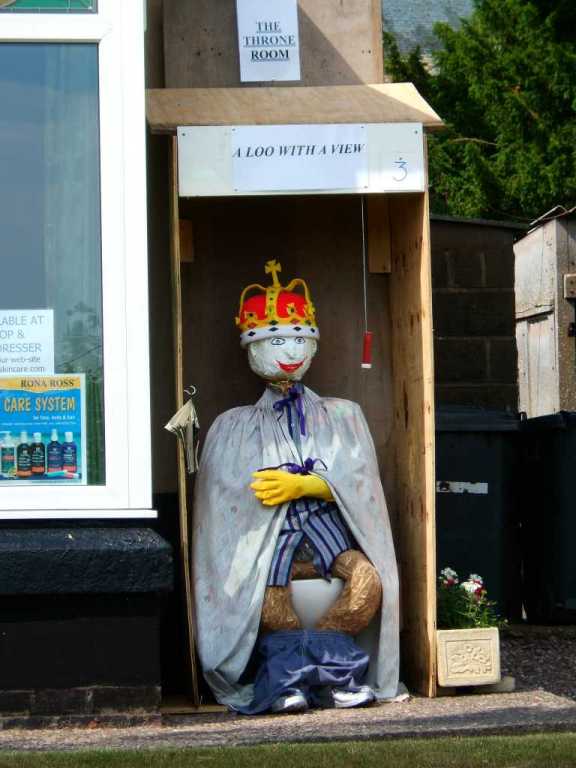
An example of one of the Wrenbury Scarecrows
After mooring we all went to the Dusty Miller for a drink before walking into the village. It was Wrenbury Village’s “Scarecrow Week” and we spent a few happy hours looking around and photographing the different scarecrows in the brilliant summer sunshine. When we all returned to our boats we were talking to Tony Whalley and a herd of cows came down to the canal to cool their feet and have a drink. Ange moo’ed at them and to her surprise she received a reply from one of them. Tony had a go next and he also received a reply. The happening was captured for prosperity on Mike Goldberg’s (NB “Californian”) camcorder and everyone in the vicinity was laughing. The “Moo-off”... as it has since been christened, was re-enacted later as we were on our way to the Cotton Arms for our tea and we all received replies.

Cows refreshing themselves at Wrenbury after the "Moo-off"
Whilst we were in the pub a thunder storm started accompanied by rain consisting of really large rain drops. It was late when we returned from the Cotton Arms and we followed the path to the canal in pitch darkness and torrential rain. Once back on the boat we got dried and watched a bit of tv before going to bed.
Wrenbury was the last place we stopped on the Llangollen Canal as the next day we made our way back down the canal to Hurleston. The weather had cleared up after the thunderstorm of the previous evening and everywhere was deliciously fresh and fragrant after it. We stopped above Baddiley Number Three Lock to buy a painted planter filled with flowers. The man who paints and sells them wasn’t there so we put our money in the “honesty box” provided at the side of the lock.
Ange steered the boat through the remaining locks and we were soon saying hello to the three noses under the lock keeper’s cottage at Hurleston. We were helped through the locks by Mike and Bonny Goldberg who were moored on the main line of the Shroppie. As we pulled out of the bottom lock we bade farewell to our helpers as they were heading towards Nantwich while we were heading towards Barbridge.
We had arranged to moor for the night with the others from our club at the Weaver Aqueduct near Church Minshull and after leaving Hurleston we turned right at Barbridge onto the Middlewich Branch of the Shroppie. After dropping down Cholmondeston Lock we moored with some of the other club members and went to visit Venetian Marine. After looking around the canal shop and Aquafax Chandlery (and spent an imaginary fortune) we all had coffee in the little cafe before returning to our boats and cruising down to Church Minshull.
When we reached the arranged moorings we sat outside eating nibbles and having a drink before the drizzle chased us inside our boats to have our tea and watch tv. The next day the weather was back to its normal hot and sunny self (for this holiday anyway) and we set off for Middlewich. As usual there was a queue for Wardle Lock and when it was our turn Maureen asked me to trim the brambles growing below the bottom gates with her shears before they scratched someone’s eye out. After the impromptu bit of gardening we continued on our way down the locks and along the Vale Royal to Anderton. Along the way we counted thirty eight very large fish dead in the canal. I put this down to the lack of oxygen in the canal with the very hot weather.
At Anderton we visited the sanitary station to empty the toilet and rubbish before trying to find a mooring at, what is now one of the most popular mooring locations in the area. As all the suitable places were taken, Nigel, who passed us when we were at the sanitary station, waved us to moor on the side of “Don Ross”, which we did. We had telephoned ahead to book a table for eight at the Stanley Arms and we got showered and changed ready for the evening ahead.
Over the food we reminisced about the holiday that was now drawing to a close. We mulled over the highlights and the weather as well as having a re-run of the Wrenbury “Moo Off”. The evening was over all too soon and we returned to our boats with full stomachs and fond memories.
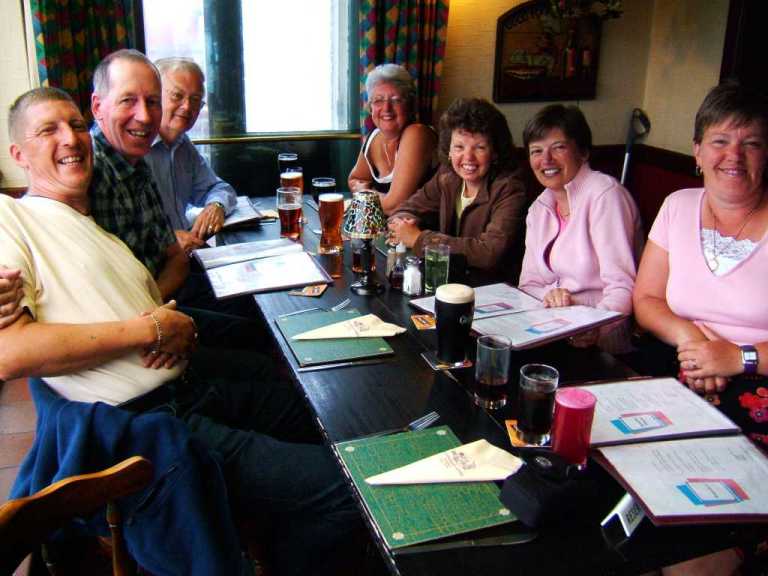
"Our Gang" (except for the author) waiting for our meal in the Stanley Arms at Anderton
(Left to right - Nigel Foster, Tony Whalley, Barry & Phyllis Greenough, Linda Whalley, Lisa Foster and Angela Wood)
Next morning we set off for the Bridgewater Canal and our home waters. We had all arranged to meet up at Stockton Heath the next afternoon and spend the last evening of the holiday together. The trip to Stockton Heath was uneventful and the deep, wide waters of the Bridgewater Canal contrasted with the shallow, narrow canals that we had cruised over the last two weeks.
At Stockton Heath “Sapphire” and “Philbarmar” were already moored. As we were mooring “Don Ross” pulled up and when the ropes were tied we made plans to visit the fish and chip shop down the road for our tea later on. In the meantime I had a few jobs to attend to. The piano hinges on which our windscreen pivoted had gone rusty and I removed them, replacing them with the original hinges that I had kept. I also fitted brass catches to hold the windscreen side wings to the main screen so that it could be erected without having the cover raised. Once these jobs were completed we joined our friends and made the journey to the fish and chip shop.
On our return, Phyllis off “Philbarmar” had set a table for us in their front cabin with knives, forks and plates ready for the piping hot food to be served. The food from the fish and chip shop we went to is renowned on the Bridgewater Canal and we have even visited it by car in the past. The fruity curry source is especially recommended (according to Ange as I do not like curry). After eating I returned to our boat to get the “Trivial Pursuit” game that we had all agreed to play. The game went on until eleven o’clock and time to retreat to our beds. We all thanked each other for their company on the holiday and especially Tony and Linda Whalley for arranging it and looked forward to future holidays cruising together.
By the time we arose the next morning, “Philbarmar” had left for Lymm and Tony was not far behind in “Sapphire”. The boat that Nigel and Lisa were on... “Don Ross” belonged to Lisa’s mother and father. Nigel and Lisa were selling their fibreglass cruiser and were due to collect their new boat later on that day so they didn’t want to waste any time leaving either. We had our breakfast and set off on the last few miles to Lymm. When we arrived at the boat club we moored our boat in the arm of the canal in front of the club house and loaded our things into the car.
By this time Nigel was ready to go and fetch their new boat that had been left in Lymm Village moorings by his father in law having, just had its Certificate of Compliance renewed by Thorn Marine. But there was a problem... the engine wouldn’t start. I offered to help Nigel bow-haul the boat from in front of Peter and Sallie Corbett's house to the club yard. We managed quite well until it was time to cross the canal in front of the club house. The ropes weren’t long enough so we used the boat as a bridge (holding up a passing boat into the bargain) and eventually moored it alongside “Don Ross”.
The problem appeared to be a flat battery and after trying to charge them a new battery was obtained and the engine burst into life. When we were happy that everything was alright we said farewell to our friends and I took the boat to Oughtrington whilst Ange met me there in the car.
When the boat had been “put to bed” we headed for home after what was the most enjoyable canal holiday I have ever experienced. We had reservations about cruising with the club for such a long period of time but we needn’t have worried as everything went to plan and Tony Whalley had made an excellent itinery... only cruising for about five hours a day gave plenty of time to explore places that one might normally cruise past when on a tight schedule.
As far as “Total Eclipse” is concerned... she never missed a beat and conveyed us with reliability and style. It was an absolute pleasure to steer her and we only used £30 worth of diesel fuel on the whole journey!
Our thoughts and observations about the Llangollen and Montgomery Canals are that they go from strength to strength. We could see a positive difference in the three years since we had last cruised the Llangollen Canal. The new marina facilities were badly needed and are a fitting end to a cruise up the canal. And as for the Montgomery Canal... it was a sheer delight and we cannot wait to return and hopefully cruise it in its entirety.
We previously had many happy memories of the Llangollen Canal. This holiday has most certainly added to them and confirmed that this canal is one of the most beautiful and most satisfying to cruise in the entire British Inland Waterways system.
Llangollen Revisited... Epilogue
The day after our return from holiday a breach occurred at Castlefield on the Bridgewater Canal. The breach was caused by a sluice gate giving way and millions of gallons of water flowed into the River Medlock near to Potato Wharf. We first heard about it on the Granada Television News and I planned to drive up there to take photographs for the second edition of “The Duke’s Cut”. Stop boards had been placed across the canal at Sale and Barton Aqueduct was closed to prevent water loss from the Leigh Branch and the Leeds and Liverpool Canal.
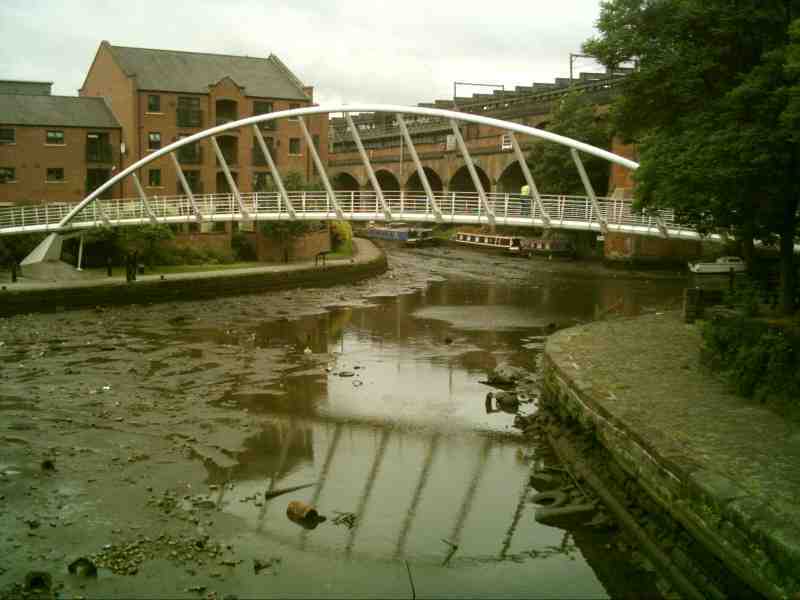
The Bridgewater Canal at Castlefield drained as a result of the breach
When I arrived the water levels were slowly returning to normal but it was still possible to see the bed of the canal in places. Whilst there I met some friends that are BMBC Runcorn members. One of them very kindly loaned me the memory card from his digital camera for me to copy as it contained photographs of the breach as it was happening.
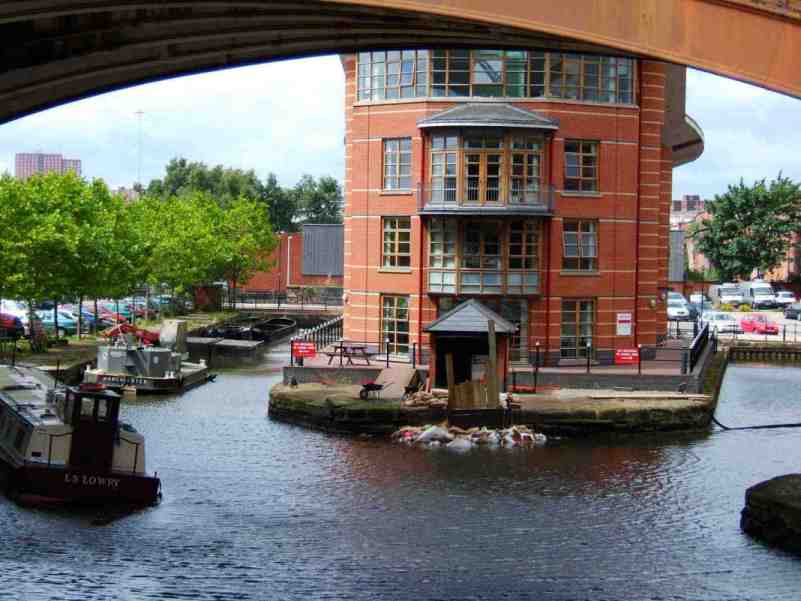
The source of the breach is in the centre of the photograph where the planks and sand bags are located
The Lymm CC cruise a fortnight later had to be postponed due to low water levels. We managed to reach Lymm’s club house but we dragged the bottom of the canal virtually all the way from Oughtrington to Lymm even though the water levels were still rising and it eventually took four weeks for the water levels to return to normal.
An incident involving one of our member’s boat was related to me a few weeks after our return. The boat in question was “Miss Ellie”, a 34ft “Nauticus” GRP cruiser owned by John and Elsie Hughes... two of our more senior members. They were descending Hurleston Locks on the return journey and whilst entering the bottom lock got stuck fast. Alan Savage’s wife... Lynn, was assisting the lock keeper empty water from the second lock in an effort to flush “Miss Ellie” into the lock and on the third flush the boat floated over the tight spot and into the lock. This incident reminded me of Chris in 1961 when his wooden narrowboat was stuck fast in this notorious lock. At least John Hughes didn’t have to resort to the axe that Chris used. Some things never change even with over forty years of use, this lock is still notorious for its narrowness as is demonstrated by the notices requesting fenders to be lifted and the story related above!
My brother... Jim and I have regularly had “Boys’ Days Out” when we get into the car and go, to quote James Tiberius Kirk... “Thataway”! We both enjoy this time together and we share our passion not just for canals but photography as well. A fortnight after returning from our holiday, Jim and I arranged to have a boys’ day out. Our first port of call was Ellesmere followed by Welsh Frankton and the Queen’s Head down the Montgomery Canal. He remembered Welsh Frankton as it was prior to restoration in the 1960’s and after walking down the locks, taking photographs and chatting with the lock keeper was very impressed with the location as it is today.
The lock keeper told us that British Waterways had imposed an annual quota of boats locking down onto the Montgomery Canal. British Waterways had specified that 2500 boats would be allowed to use the canal had almost been reached and he feared that the canal would be closed in August until next year. When the canal was completely restored there would be more boats wanting to use the canal and the quota would remain the same as at present. This would lead to more queues at the locks and the system would have to be reviewed. After this we said goodbye to the lock keeper and returned to the car.
After leaving Welsh Frankton we stopped at Maestermyn Marine. I had telephoned them a couple of days earlier and made an offer for the aerial that we had seen whilst on holiday. I offered them £20 for it which was accepted. Before parting with money I checked the signal connections to make sure that the plugs for it were readily available and it had a readily available shaft fitting. They were both satisfactory and I bought it content that I had a bargain (saving £60 can’t be all that bad can it?). Whilst we were at Maestermyn Marine we walked a little way along the canal to where boats were stored on the hard standing, some of which were for sale. There was one particular boat that Jim liked as it was similar in style to “Phial” only made out of steel. It needed quite a bit of work both inside and out but it wasn’t beyond the realms of possibility. Unfortunately, Jim’s wife... Norma, is not a boat person and prefers their static caravan instead.
After leaving Maestermyn we drove to the Queen’s Head. We left the car close to where we had moored a couple of weeks previously and walked down the towpath to Aston Locks. The locks demonstrated the same excellent level of restoration as the section of canal that we cruised whilst on holiday.
We returned to the car and on our way back to civilisation we drove along the stretch of canal that leads to Rednal. I showed Jim the Site of Special Scientific Interest where the edges of the canal’s channel were cordoned off so that boats’ wash didn’t damage the fauna and flora. He thought that it was a bit over the top so its a good job he hasn’t see the areas further down the canal where a totally new channel has had to be constructed to circum-navigate an SSSI.
|
Jim posing with his Leica "Digilux" at Pontcysyllte on one of our |
|
"Boys' Days Out" (but he still wouldn't walk across the aqueduct - wimp!) |
Jim had previously been on the navigable Welshpool section of the Montgomery Canal on a day hire boat and was not too impressed with it (this might have something to do with his jumping off the boat at a lock, missing the towpath and breaking his arm). This trip has changed Jim’s attitude towards the Montgomery Canal. He was impressed, not only by the beautiful countryside through which it passes but also by the standard of restoration. So much so that he would like to cruise its complete length when completed. He’s got to join the queue on that one though!
Our next boys’ day out was a few weeks later when we drove to Venetian Marine at Cholmondeston. After having a look around, rooted through the junk boxes upstairs in Kate’s Canal Shop and eating breakfast we went to Hurleston, We walked down the locks and met Pat and Roy Wilcox returning from Llangollen and on their way to Nantwich. After a chat we too made for Nantwich. I think that Jim would have liked to have seen a Taylor cruiser there but alas there were none. We walked back to the basin and, after a cup of coffee, made our way to Audlem. As it was a hot sunny day, there were lots of people outside the “Shroppie Fly” but this did not bother us as their presence added to the photographs that we took there.
|
|
|
|
A list of major milestones in my canal cruising experiences from 2000 to 2005
|
|
|
January 2000 |
"Canal Cruising 1960 to 2000" serialised in "The Grand Trunk" magazine |
|
February 2002 |
"The Bridgewater Book" resurrected and renamed "The Duke's Cut" |
|
March 2001 |
Took over responsibility for "Cordelia" |
|
February 2002 |
Commenced writing "The Big Ditch - Manchester's Ship Canal" |
|
April 2002 |
"The Duke's Cut - The Bridgewater Canal" published by Tempus Publishing |
|
April 2002 |
Easter Cruise to Wigan with Lymm Cruising Club |
|
July 2002 |
Purchased "Cordelia" and renamed her "Total Eclipse" |
|
July 2002 |
Cruised to Church Minshull on the Shropshire Union Canal's Middlewich Branch |
|
August 2002 |
River Irwell, Manchester Docks and Salford Quays with Lymm Cruising Club |
|
September 2002 |
Joined Lymm Cruising Club and moored "Total Eclipse" at Oughtrington |
|
April 2003 |
Easter Cruise to Wigan |
|
June 2003 |
Cruise to Castlefield, Manchester |
|
June 2003 |
Llangollen Canal (see Chapter 4 - Llangollen Pilgrimage) |
|
July 2003 |
Part of Lymm CC's Summer Cruise to Beeston, Shropshire Union Canal (see Chapter Five - Beeston Pilgrimage) |
|
February 2004 |
Became a Committee Member of Lymm CC and Director of Lymm Properties Limited |
|
June 2005 |
Lymm CC's Summer Cruise to the Llangollen and Montgomery Canals (see Chapter Six - Llangollen Revisited) |
|
August 2005 |
Cruise to River Irwell, Manchester Docks and River Irwell |
|
August 2005 |
"The Big Ditch - Manchester's Ship Canal" published by Tempus Publishing |
|
August 2005 |
Attended IWA National Rally at Preston Brook, Bridgewater Canal |
|
|
|
Sunset at Dunham Massey on the Bridgewater Canal
|
|
|
Book 4 |
Canal Cruising 2006 to 2007
or select another book below...
 |
|
"Canalscape" and "Diarama" names and logo are copyright |
Updated 03-12-2013